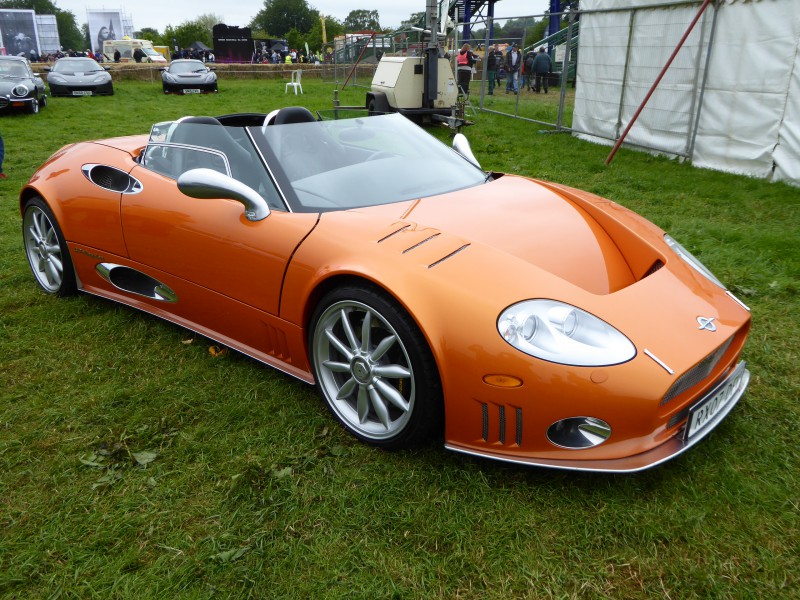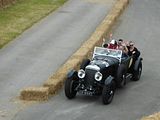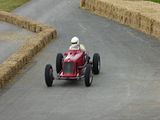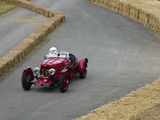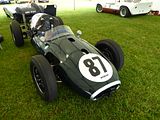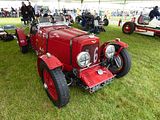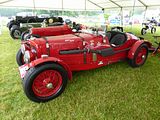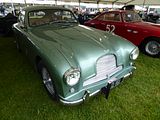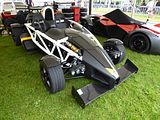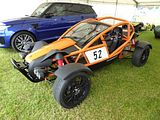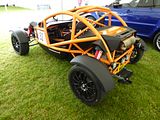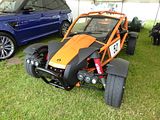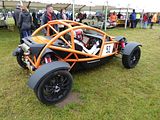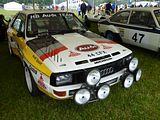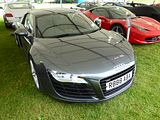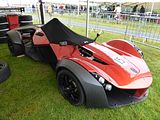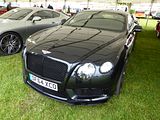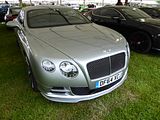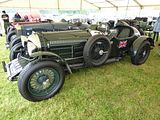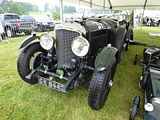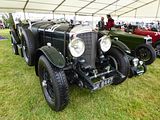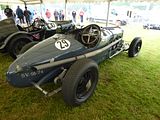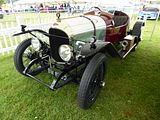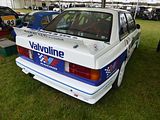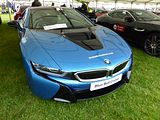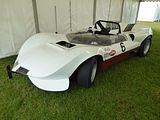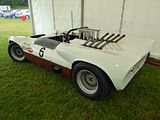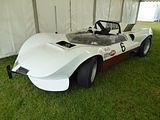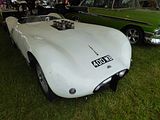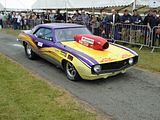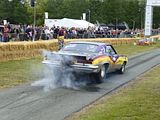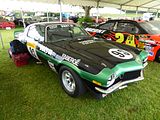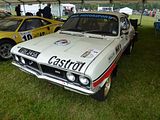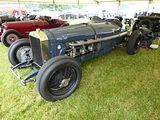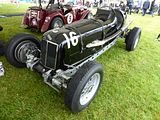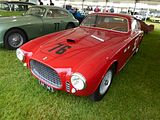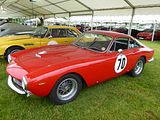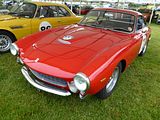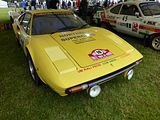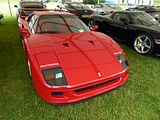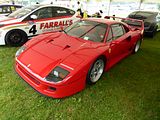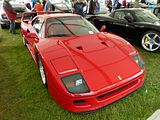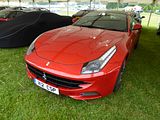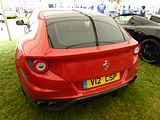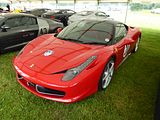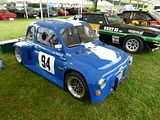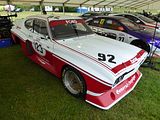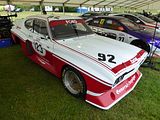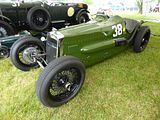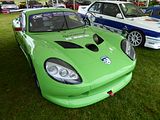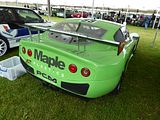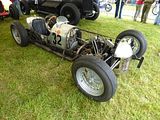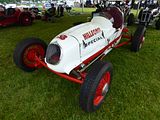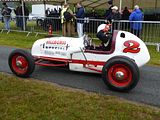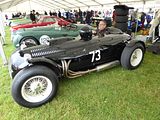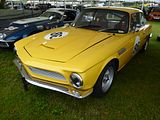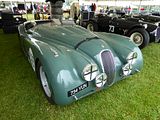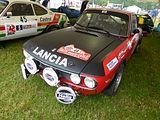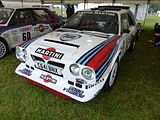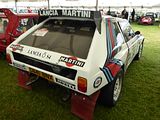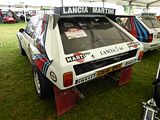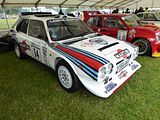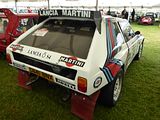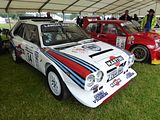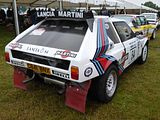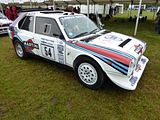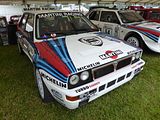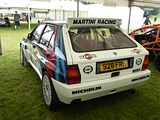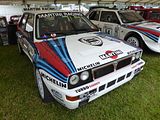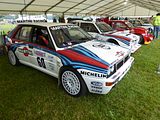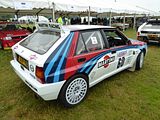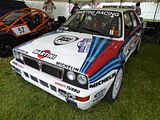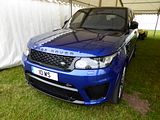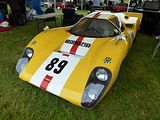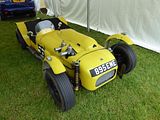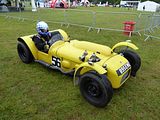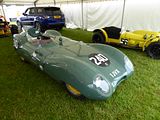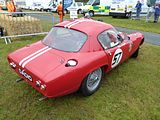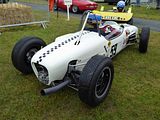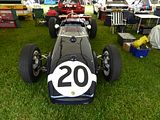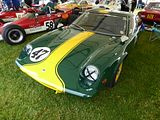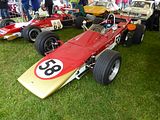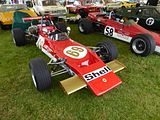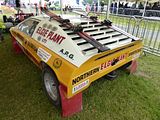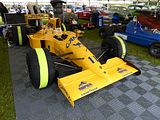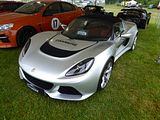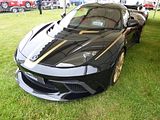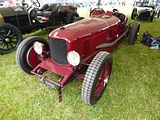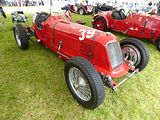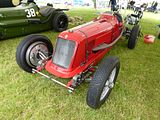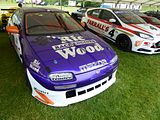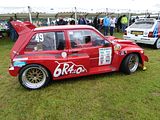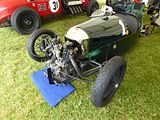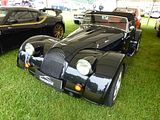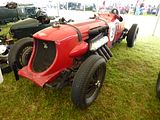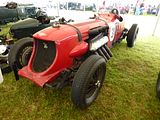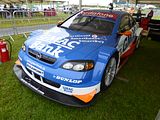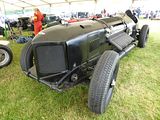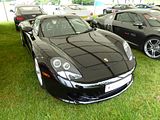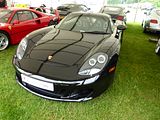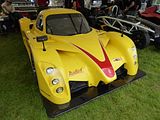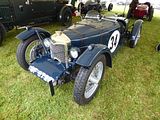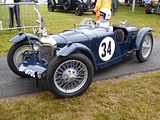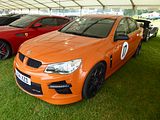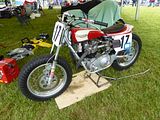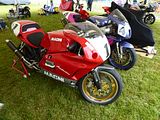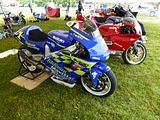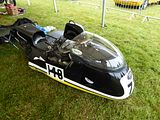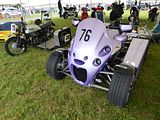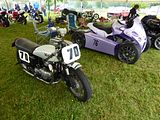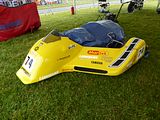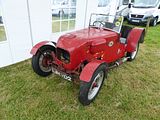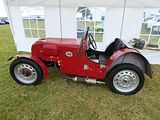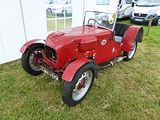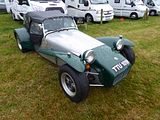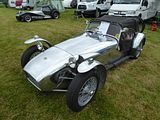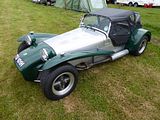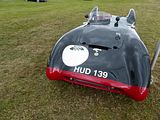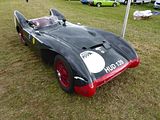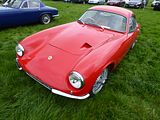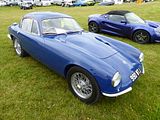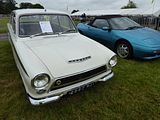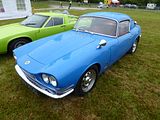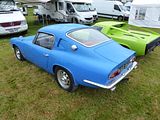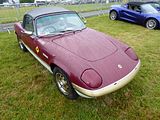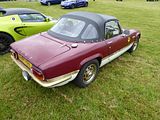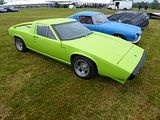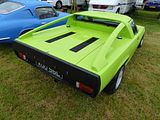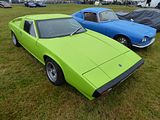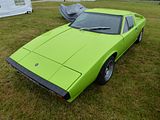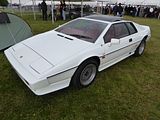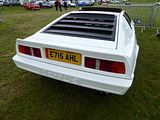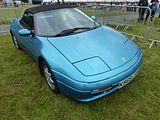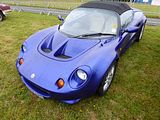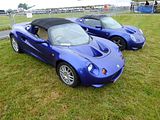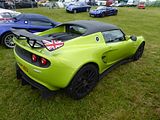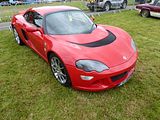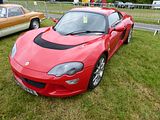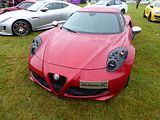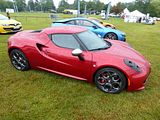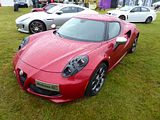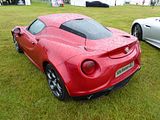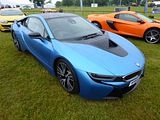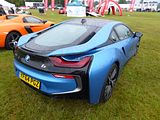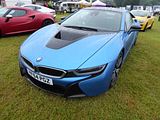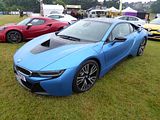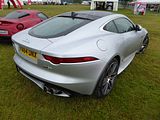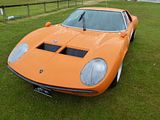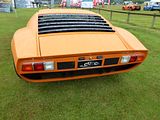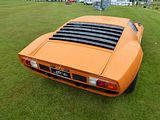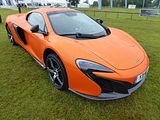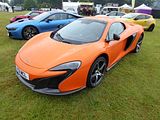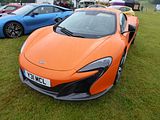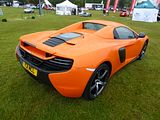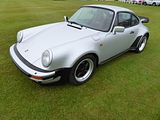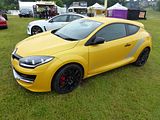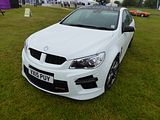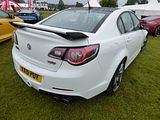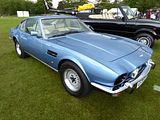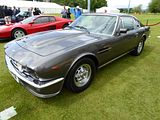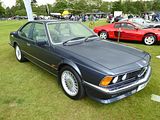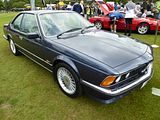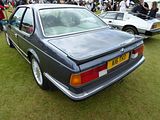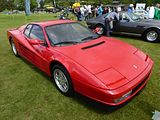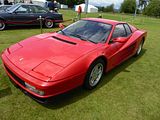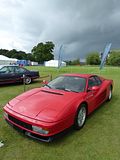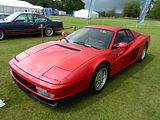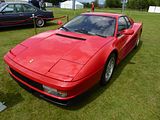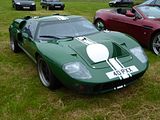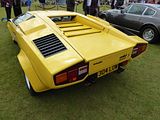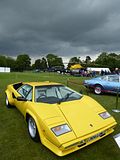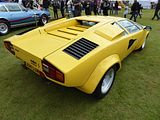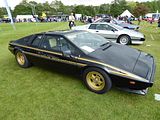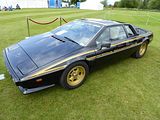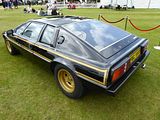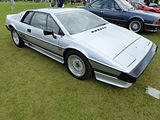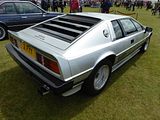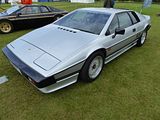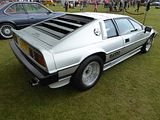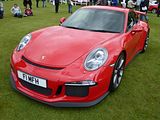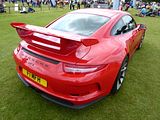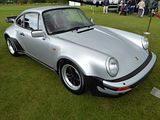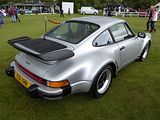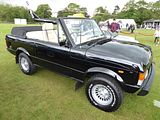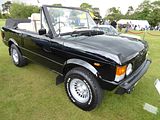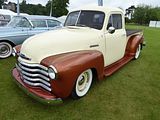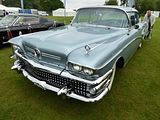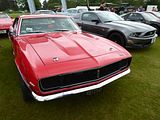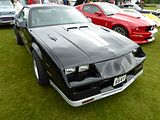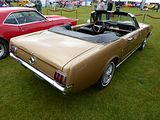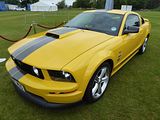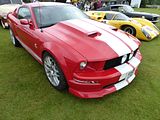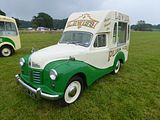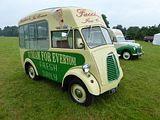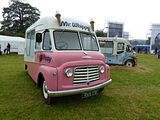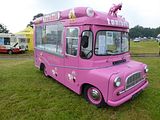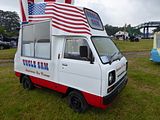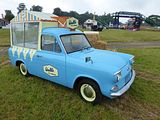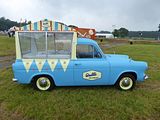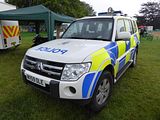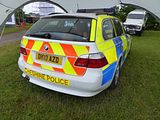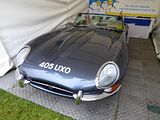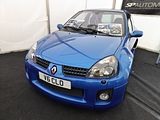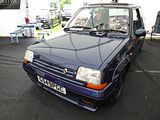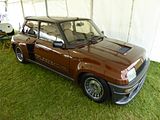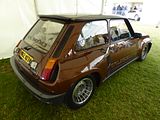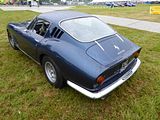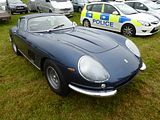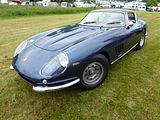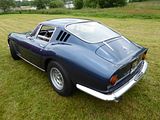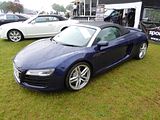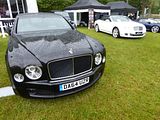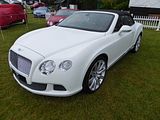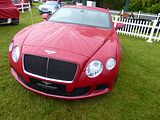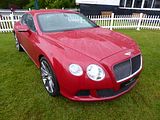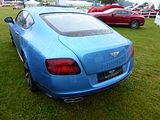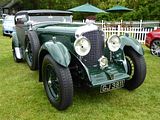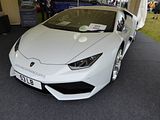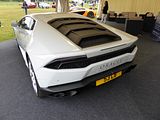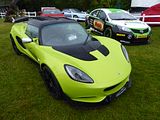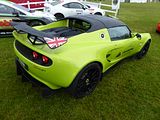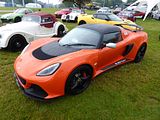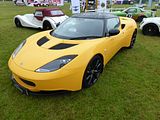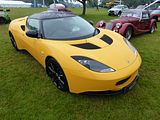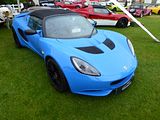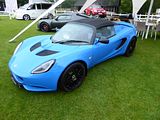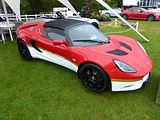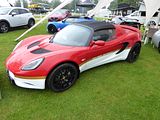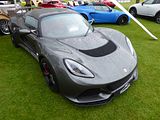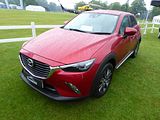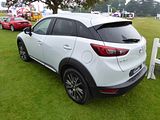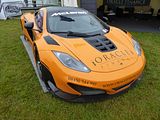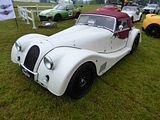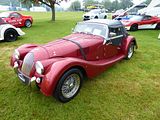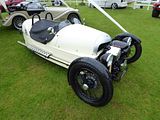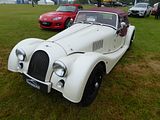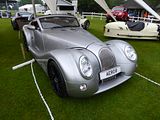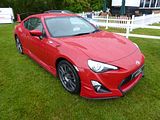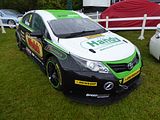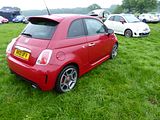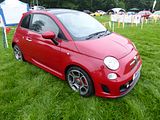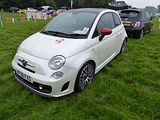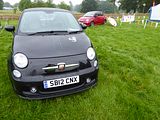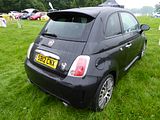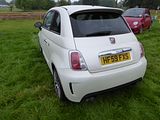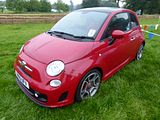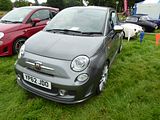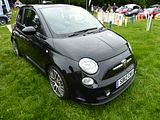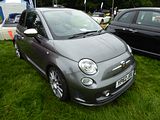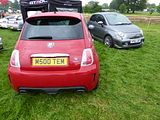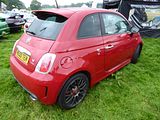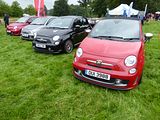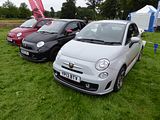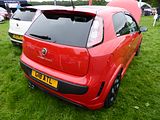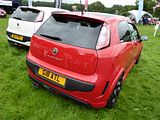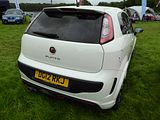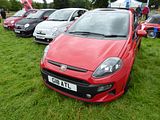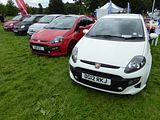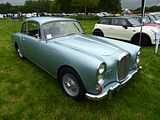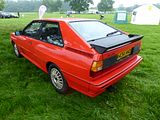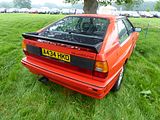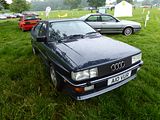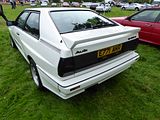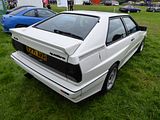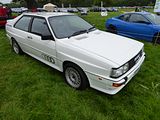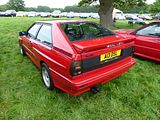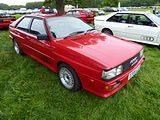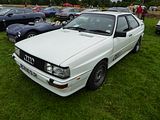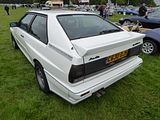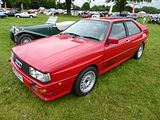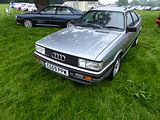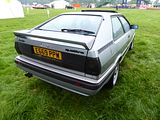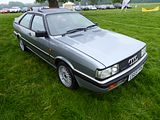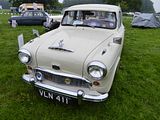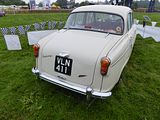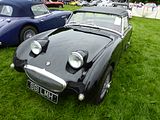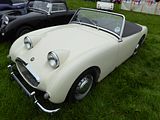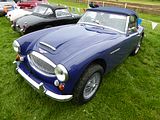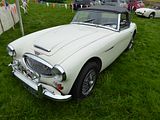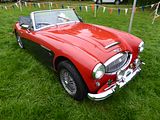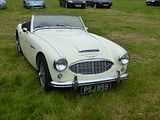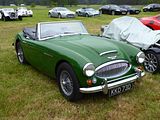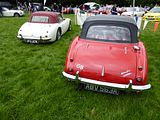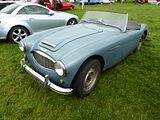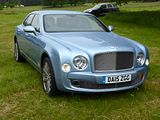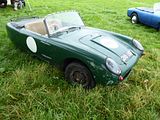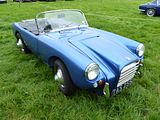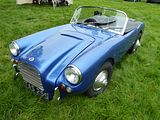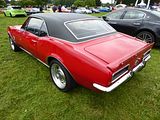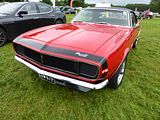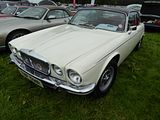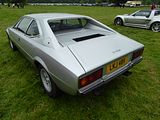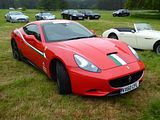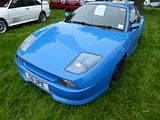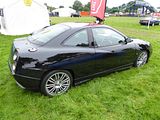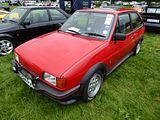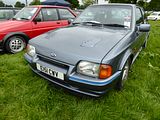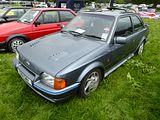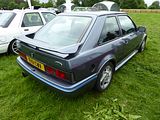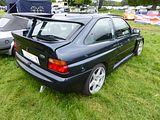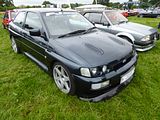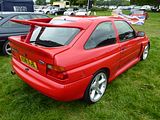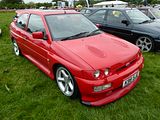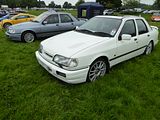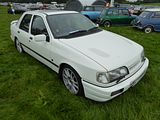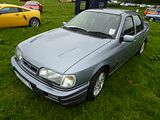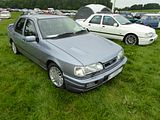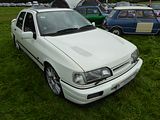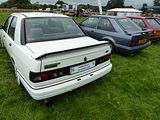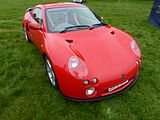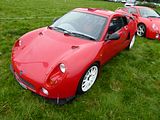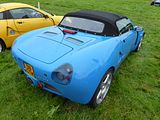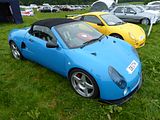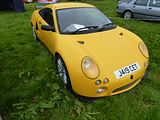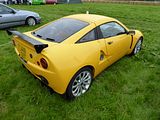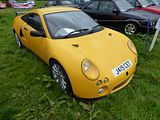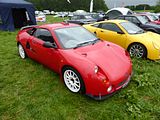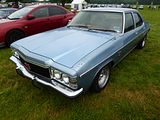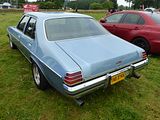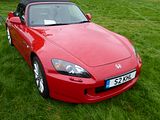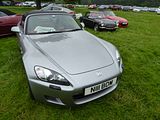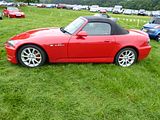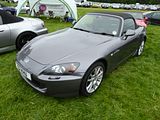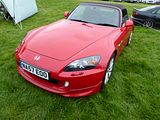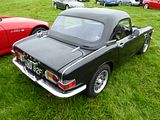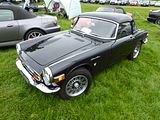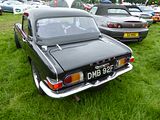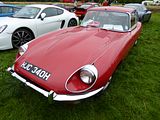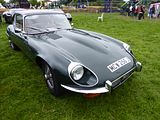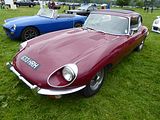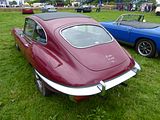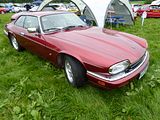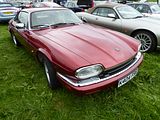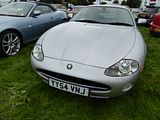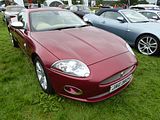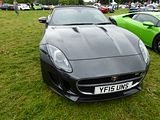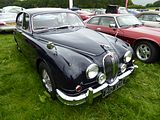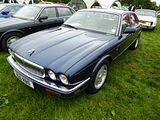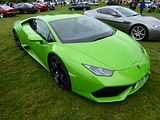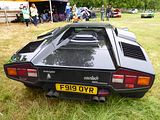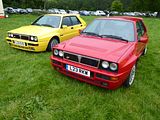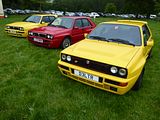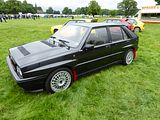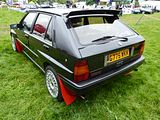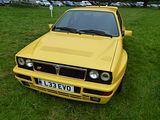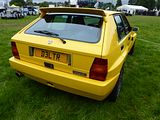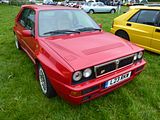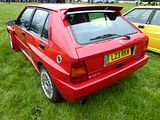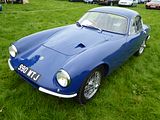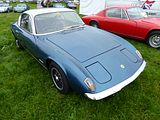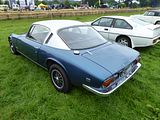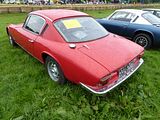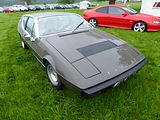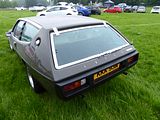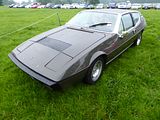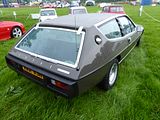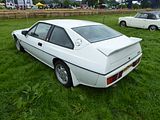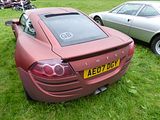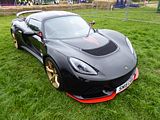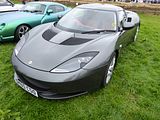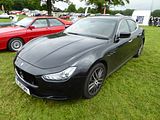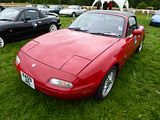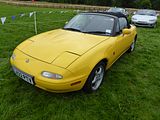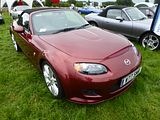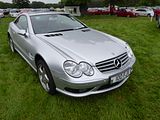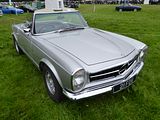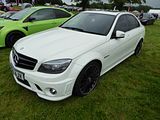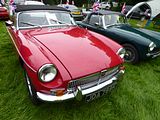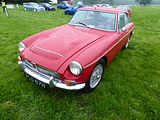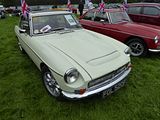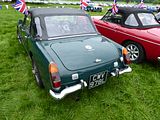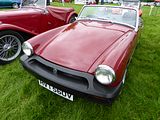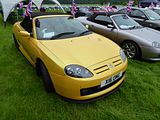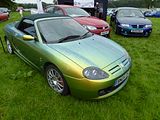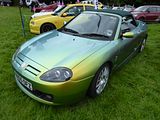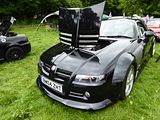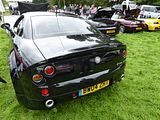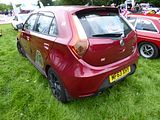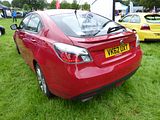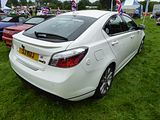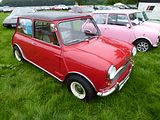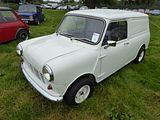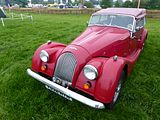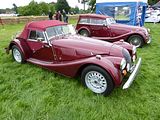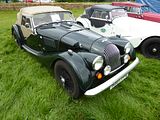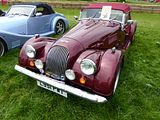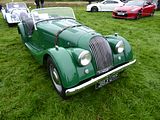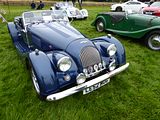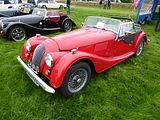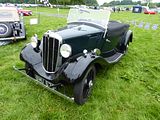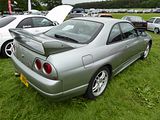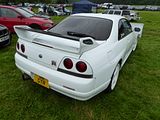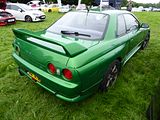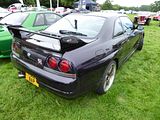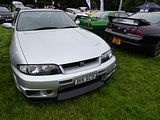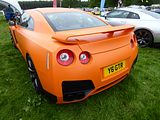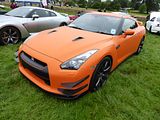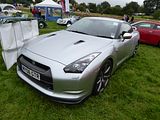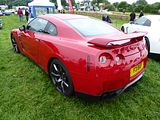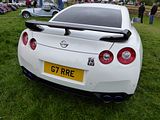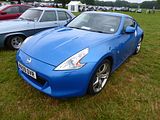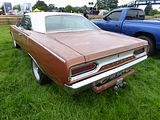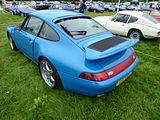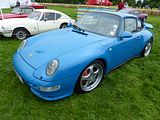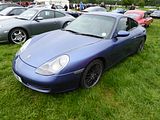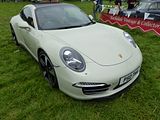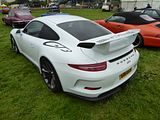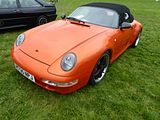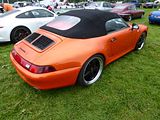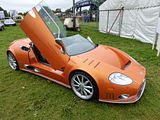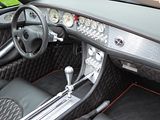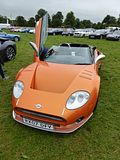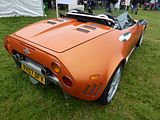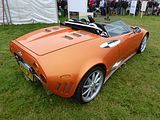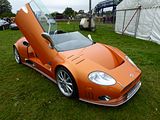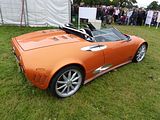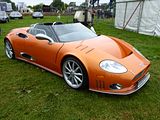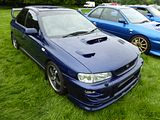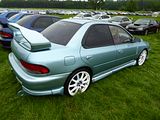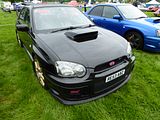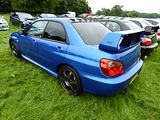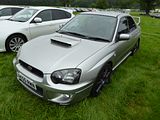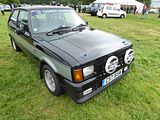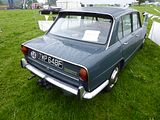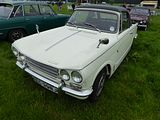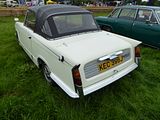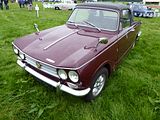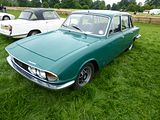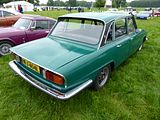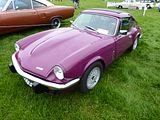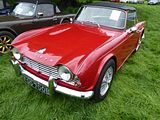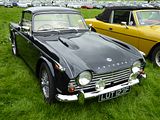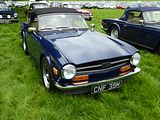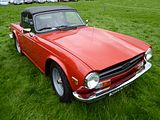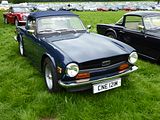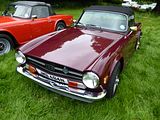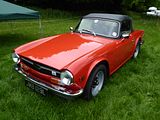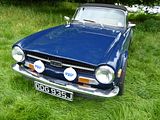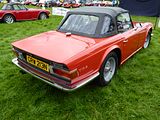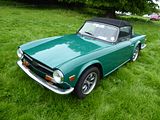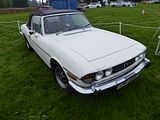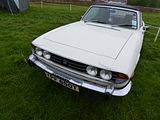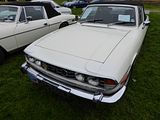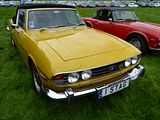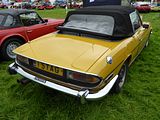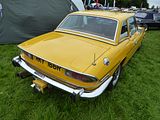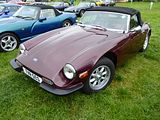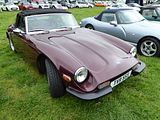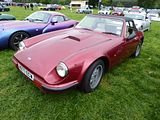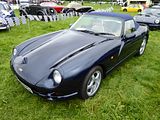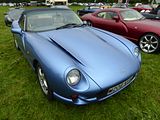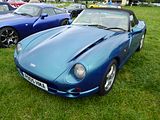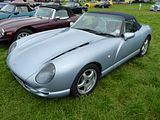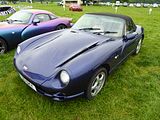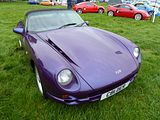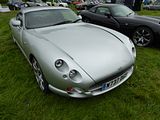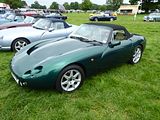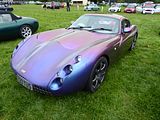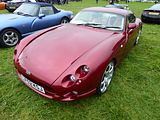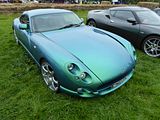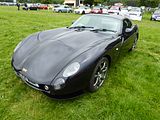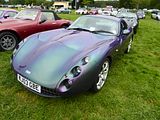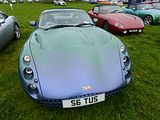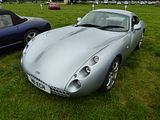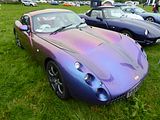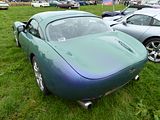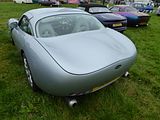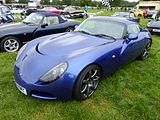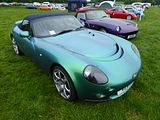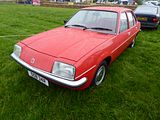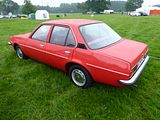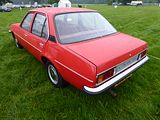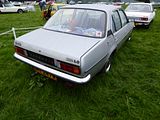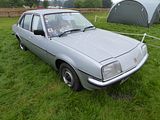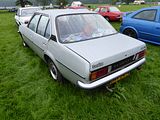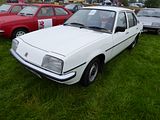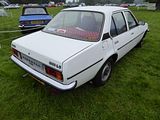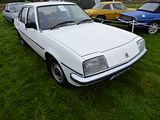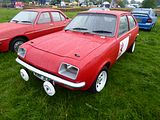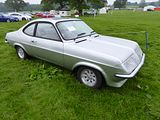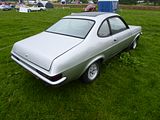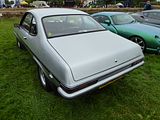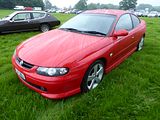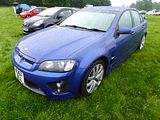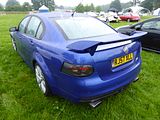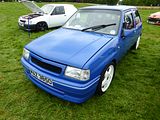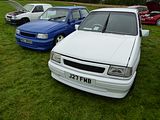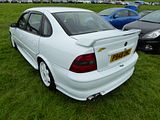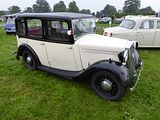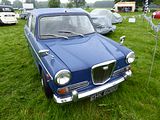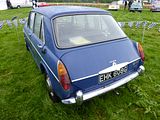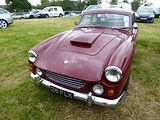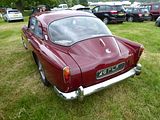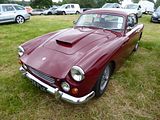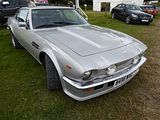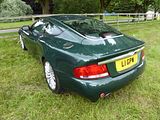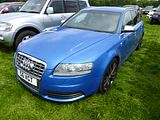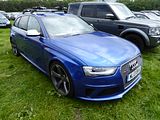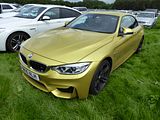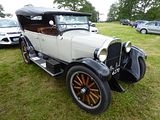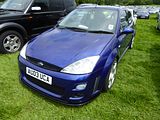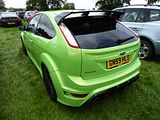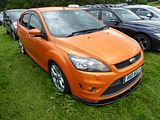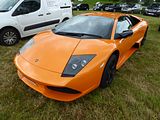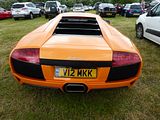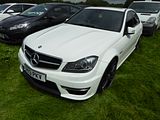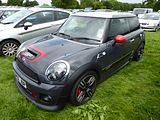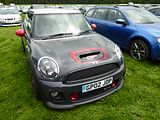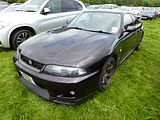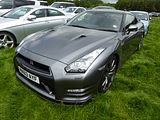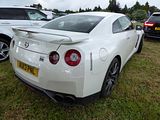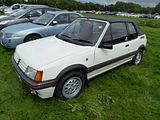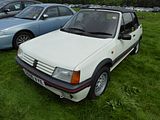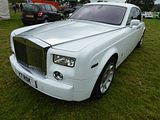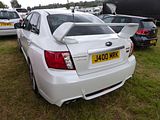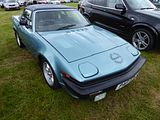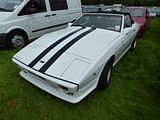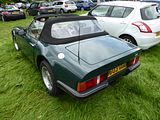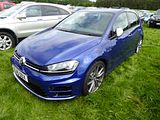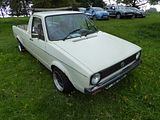As an events organiser and inveterate attendee of car events around the country, one “complaint” I hear quite frequently is that whilst there is almost too much going on in the South of England, the North is far less well served. Whilst there are indeed plenty of locally organised Shows, there are relatively few that attract national publicity in the way that some of the “Big Name” events held in the bottom half of the country manage to do. I am sure that those who organise such events could come up with a list of reasons, some of which may be genuine, as to why this is. That is the case cannot have escaped the attentions of those who conceived the event being reported on here, the Cholmondeley Pageant of Power. It had been running for a couple of years before I became aware of it, and when I was first handed a leaflet advertising it – no doubt at an event in the South! – I will confess that I had no idea where in the country it might be, as although Cholmondeley Castle has been open to the public for some years, I had not visited it, or even heard of it. The details of the event on that publicity leaflet certainly intrigued me, though, as it outlined a series of static displays, action on the track for a very varied collection of supercars and historic racers and bikes, air displays and fly pasts of some interesting and historic planes, rib rides on the lake, tanks careering around a purpose designed course as well as plenty of trade stands offering everything from gifts to locally produced food and drink. I resolved to go, and first made it there in 2011. I’ve been every year since. That fact alone should indicate that it is a good event, as its timing is such – now held in mid June in an effort to try to avoid the terrible weather of mid July which beset the event in its early years (as if the weather is ever guaranteed or predictable in this country!) – that it has to compete with other worthy events (in the South!). Cholmondeley is about 20 miles to the west of junction 16 of the M6, near Crewe and Nantwich. That means that it is not that much further from my Bristol home than London, and is actually a relatively easy journey for those coming up from the Home Counties. How many people do is a moot point, but for the last couple of years, attendance at the event has hit the 65,000 people over the three days when it is held, which is enough to make it feel decently busy but not enough to overcrowd it, as has happened to the event to which it is most often compared, the Goodwood Festival of Speeds. Indeed, some say that this is like the Goodwood event use to be, in its early years. There are similarities, but there is a unique character to this one, too, so I could quite understand anyone who went to both. Each year, the organisers announce a number of themes and special displays for the Pageant, and for 2015, we were tempted by news that these would included the last display over Cheshire of the legendary Vulcan bomber, renowned motorcyclist Dougie Lampkin MBE performing stunts on track and on water and special concours celebration of 60 years of Lotus cars, a display of US muscle cars on the Saturday and one of Eighties supercars on the Sunday. I chose to make a weekend of it, spending both the Saturday and Sunday onsite. Apart from some patchy drizzle, the weather was far kinder than it has been in some previous years, and the ground was also dry and firm underfoot, which was not always so in the past, either. That meant I could enjoy what was on show and in action, and here are the highlights.
IN THE PADDOCK
Central to the event is a Paddock overflowing with interesting machinery. Autocar magazine, one of the supporters and sponsors of the event work hard with a number of manufacturers to ensure that there is a plentiful supply of the latest performance and supercars and then owners of historic racing cars are invited to enter their treasured machines, which seems to prove an irresistible offer to plenty, with a very diverse field of cars, some well known and some unusual or obscure combining to give a total of around 200 cars, which are then joined by a huge number of motor bikes, again a very diverse lot with marques you’ve likely never heard of as well as plenty that you know well. Everything that is in the Paddock gets to make a couple of trips in the morning and another couple in the afternoon around the track. This is a 1.2 mile circuit around the grounds of the Castle which includes tight turns, straw bale chicanes on the straight and a hump-back bridge which seems plenty of competitors get momentarily air-born. There is lots of competition to set the fastest time, especially among the manufacturers, many of whom now bring not just a car and a driver but a few mechanics to ensure their cars are perfectly set up. The fastest lap of the weekend went to a Force PC, driven by Gary Thomas, with a time of 58.34 seconds. Of the regularity runners, the most consistent car was a Chevron B48, driven by Damon Milnes, with Tony Haywood on the Norton Rotary claiming the award for the most consistent motorcycle. There are vantage points around much of the circuit, so you can easily get a good look at the cars and bikes in action.
ASTON MARTIN
Aston Martin built small quantities of a number of different, but visually similar cars in the 1930s, many of which were used for racing. Of these the most special of the lot was the Ulster, 31 of which were constructed and 26 of which survive to this day, with Nock Mason owning three of them. As most enthusiasts will recall, thanks to a year of centenary celebrations, the Aston-Martin marque goes back to 1913, though it was not until after the end of hostilities in 1918 that any cars were produced. In the early years, a concentration on motor sport, while accruing invaluable publicity, distracted it from the business of manufacturing cars for sale, the result being just 50-or-so sold by 1925 when the company underwent the first of what would be many changes of ownership. The foundations were laid for the commencement of proper series production with the formation of Aston Martin Motors Ltd in 1926 under the stewardship of Augustus ‘Bert’ Bertelli and William Renwick. Bertelli was an experienced automobile engineer, having designed cars for Enfield & Allday, and an engine of his design – an overhead-camshaft four-cylinder of 1,492cc – powered the new 11.9hp Aston. Built at the firm’s new Feltham works, the first ‘new generation’ Aston Martins were displayed at the 1927 London Motor Show at Olympia. Like his predecessors, ‘Bert’ Bertelli understood the effect of competition success on Aston Martin sales and sanctioned the construction of two works racers for the 1928 season. Based on the 1½-litre road car, the duo featured dry-sump lubrication – a feature that would stand them in good stead in long distance sports car events – and this was carried over to the International sports model, newly introduced for 1929. Built in two wheelbase lengths (8′ 6″ and 9′ 10″) the International was manufactured between 1929 and 1932, mostly with bodies by Augustus’s brother Enrico ‘Harry’ Bertelli. The ‘Le Mans’ label was first applied to the competition version of the (1st Series) International following Aston’s class win and 5th place overall in the 1931 Le Mans race. This conceit was fully justified when the model placed 5th and 7th in the 1932 race and collected the Rudge-Whitworth Biennial Cup. It may, in fact, be the first car named after the Le Mans Race, although many others have since followed Aston Martin’s example. The early 1930s was a period of economic recession and with sales of expensive quality cars falling off, some serious rethinking had to be done at Feltham. The prudent decision was taken to redesign the International chassis using proprietary components to reduce cost. A Laycock gearbox was adopted, mounted in unit with the engine, while the worm rear axle, which had never been completely satisfactory, was replaced by an ENV spiral bevel. There was a redesigned chassis frame and many other modifications resulting in what was virtually a new car, although it carried the same coachwork and was sold as the ‘New International’. The original line-up of what would become known as the ‘2nd Series’ did not last long, the New International and two-seater Le Mans disappearing from the range before the end of 1932. That year’s Motor Show had ushered in the more familiar Le Mans 2/4-seater, which was also available on the long chassis as the Le Mans Special four-seater. Introduced in 1934, the replacement Mark II model sported a new, stronger chassis and a revised engine with counter-balanced crankshaft. Short (8′ 7″) and long (10′) wheelbase versions were built, the latter available with stylish four-seater sports saloon coachwork by Enrico Bertelli. Racing was still at the forefront of company policy under the stewardship of new owners the Sutherlands, Robert Gordon Sutherland having assuming the post of joint managing director alongside ‘Bert’ Bertelli in March 1933. For the 1934 Le Mans race, three competition cars were constructed on the new MkII chassis, the frames being copiously drilled for lightness. In the race all three works Astons were sidelined by trifling mechanical problems, prompting Bertelli to try and un-jinx the team by painting the cars – previously always finished in various shades of green – in Italian Racing Red. The next race on Aston Martin’s calendar was the RAC Tourist Trophy at Ards in Ulster, regulations for which stipulated standard chassis. Three new cars were built on unmodified frames and the superstitious Bertelli was duly rewarded with a 100% finishing rate. The trio finished 1st, 2nd and 3rd in class, earning Aston Martin the Team Prize. In 1935 another works car, chassis number ‘LM20’, finished 3rd overall at Le Mans, winning its class and the Rudge Cup. In October of 1934, Aston Martin exhibited the resulting spin-off model at the Olympia Motor Show, introducing it as ‘a Replica of the three cars which ran so successfully in the 1934 TT race.’ Built on the shorter of the two MkII chassis, the Ulster differed little from its more run-of-the-mill siblings, though the engine was subjected to tuning and more careful assembly. Modifications included polishing the inlet and exhaust ports, and raising the compression ratio to 9.5:1 by means of domed pistons and a ‘stepped’ cylinder head, the result of these changes being an increase in maximum power to around 85bhp. The Laystall crankshaft and the valves and valve springs were of higher specification than those of the other MkII models. Lightweight, door-less two-seater bodywork was fitted and every Ulster was guaranteed to exceed 100mph with full road equipment, a phenomenal achievement for a 1½-litre production car at that time. A serious competition machine, the Ulster abounded in mechanical refinements resulting from the factory’s years of endurance racing experience. These included painting the dashboard matte black and the radiator surround in body colour – reflected early-morning sunlight had been found to be a serious problem when flat out at Le Mans – and securing every chassis nut with a split pin. With a dry weight of 18cwt, it was absurdly heavy in comparison with Rileys, Magnettes and Nashes, so lacked their acceleration. Yet its unique qualities of stamina and superb handling earned the respect of enthusiasts all over the world. Aston Martin entered 7 of these Bertelli-designed cars in the 1935 Le Mans 24 hours, a race in which with Charles Martin and Charles Brackenbury behind the wheel, the car would go on to achieve third place overall and a win, for under 1500cc engined cars. Six of the seven cars, four of them driven by amateurs completed the race. The Ulster’s overall average speed was an impressive 75.23 mph with a best lap of 81 mph. The cars had originally been finished in green, but for this race, the decision was taken to paint them red, a colour that this car wears to this day. There was a minimum of chrome, to avoid the risk of annoying glare from chasing headlights, though some owners altered this in later years. Despite its weight issue, the car is bared down to just the essentials inside, as Classic and Sports Car writer Mick Walsh found out when he got the chance to drive one and to produce an article covering photos of 4 of he Le Mans cars together in an article published in the March 2012 edition of the magazine. The engineering quality of the car, however, was good and the sturdy 1495cc 4 cylinder engine produced a reliable 95 bhp, and generally proved reliable. It was the steering which really surprised him, it being light in feel and very positive, not characteristics that you often got with a 1930s car. Nick Mason paid £6000 for the first Ulster he bought, back in 1975, which was a lot of money then, but the car proved so beguiling that he found himself buying other cars “for stock”. These days they are worth at least £800,000, a fact which has not deterred the lucky owners from entering them in historic racing events, including the Mille Miglia, an event which Maurice Faulkner’s class wining drive of 1935 when the Ulster beat the Maserati and Alfa rivals just begs to be repeated. Truly this could be the finest British sports racer of the 1930s.
The other Aston Martin here was a DB2, the first new post war design produced by the firm, and the first car to use the DB name, reflecting the fact that in 1947 David Brown had bought the Aston Martin and Lagonda companies and incorporated them as Aston Martin Lagonda Ltd. Lagonda’s 2.6 litre dual overhead cam, straight-six engine, more powerful than the pushrod 1.9 litre unit in the Aston Martin 2-Litre Sports, was the main objective in Brown’s acquisition of the company. W. O. Bentley had supervised the engine’s design, which was largely by William (Willie) Watson, an engineer with the pre-war Invicta company who had collaborated on Lagonda’s pre-war V12 and also designed the short-lived post-war version. Work then started on producing a new car, which was called the DB2. This new model would utilise a version of the Lagonda engine in a shortened version of the tube-frame chassis designed by Claude Hill for the Aston Martin 2-Litre Sports, with a fastback coupé body designed by Frank Feeley. Three pre-production cars were entered for the 1949 24 Hours of Le Mans. One, which would become the development car for the production DB2, had the Lagonda straight-6, while the four-cylinder Aston Martin 2-litre unit powered the other two. After six laps the Lagonda-powered car, driven by Leslie Johnson, retired with overheating caused by failure of the water pump. One of the 2-litre cars was in 4th place and running without brakes when it crashed two hours short of the finish, fatally injuring driver Pierre Maréchal. The other finished 7th, crewed by Arthur Jones and Nick Haines. A month later, the larger-engined car, driven by Leslie Johnson and Charles Brackenbury, finished 3rd in the Spa 24-hour race, where one of the 2-litre cars was driven to 5th by Nick Haines and Lance Macklin. For 1950 all three factory team cars were equipped with the Lagonda engine. At the 1950 Le Mans race the one driven by George Abecassis and Lance Macklin finished 5th, with Brackenbury and Reg Parnell bringing another home 6th, which won Aston Martin 1st and 2nd in the 3-litre class. Across the Atlantic, Briggs Cunningham drove his DB2 to 2nd in its class at the inaugural Sebring race meeting in December 1950. The factory team cars continued racing in Europe throughout 1951, including at Le Mans, where Macklin and Eric Thompson took 3rd overall, with Abecassis and Brian Shawe-Taylor 5th. David Brown soon embarked on a series of Aston Martins designed specifically for competition use, starting with the DB3. Meanwhile, the production DB2 debuted at the New York Auto Show in April 1950 and continued in production until April 1953, by which time 411 had been made. The first 49 had a chrome-framed front grille in three separate parts, and large rectangular cooling vents in the front wings. Subsequent cars had a one-piece grille with horizontal chrome slats, and no side vents. The single-piece bonnet was hinged at the front. At the rear of the fixed-head coupé (FHC) a small top-hinged lid gave access to the spare wheel, and luggage space was behind the front seats, accessible only from inside the car. Later in 1950, a Drophead Coupé (DHC) variant was introduced. At least 102 were built. In April 1950, an engine with larger carburettors, inlet camshaft the same as the exhaust (for increased duration), and higher compression ratio pistons (8.16:1) was made available. Aston Martin’s first Vantage upgrade option offered 125 hp. Initially the higher compression ratio made the engine unsuitable for the British market, as the postwar austerity measures of the early 1950s restricted UK vehicles to 72 octane “Pool petrol”. The first DB2 Vantage, LML 50/21, was delivered to, and raced by, Briggs Cunningham in the United States. A revised version of the DB2 was launched in 1953, called the DB2/4. It was available as a 2+2 hatchback, marketed as a Saloon, as a Drophead Coupé (DHC) and as a 2-seat Fixed Head Coupe. A small number of Bertone bodied spiders were commissioned by private buyers. A further update in 1957 created the Mark III, and this was produced until the launch of the DB4 in 1958.
ARIEL
Somerset based specialist car maker Ariel is one of the ones who take this event very seriously, after the performance that they put in when they brought one of the very limited edition V8 engined Atom models here a few years ago. They now bring engineers as well as a car. Except this year, they brought two cars. More familiar of the pair was the Atom. First seen in public at the British International Motor Show at the NEC in Birmingham in October 1996, the Atom began as a student project by Coventry University transport design student, Niki Smart. Known then as the LSC (Lightweight Sports Car), it was developed at the university in 1996 with input and funding from various automotive industry members, including British Steel and TWR. Ariel Motor Company boss Simon Saunders was a senior lecturer whose responsibility for the project was primarily as financial manager and design critic for Smart, whom he described as “The best all-round design student I’ve ever seen.” Since then, an operation was created in Crewkerne, Somerset, and around 100 cars a year are produced there. Each one is made by a single person, who undertakes everything from assembly to final road test before putting his name on the finished product. There have been 7 distinct models, with a wide variety of different engines ranging from a 2 litre Honda VTEC unit in naturally aspirate and supercharged guise, to the ultimate, the 500, with a 3 litre V8 that generates 500 bhp. Visually, the cars look similar at a quick glance, and it takes a real marque expert (which I am not!), to tell them apart. Never intended as an every day car, as their real raison d’etre is as a track machine, owners do take them out on public roads, and in traffic, from time to time.
Joining it was a Nomad, the fun off-roader machine that so beguiled the press when they got behind the wheel earlier this year.
AUDI
There was a splendid example of the Quattro Sport S1 here. It may be over 35 years since the Quattro first came to our attention in the forests, with its distinctive sound, and all conquering abilities, and nearly 30 years since the last works cars claimed their final victories, but this is one of those legends which still appeals to just about everyone. The original Audi Quattro competition car debuted in 1980, first as a development car, and then on a formal basis in the 1980 Janner Rally in Austria. Largely based on the bodyshell of the road-going Quattro models (in contrast to the forthcoming Group B cars), the engine of the original competition version produced approximately 300 bhp. In 1981, Michèle Mouton became the first female driver to win a world championship rally, piloting an Audi Quattro. Over the next three years, Audi would introduce the A1 and A2 evolutions of the Quattro in response to the new Group B rules, raising power from the turbocharged inline 5-cylinder engine to around 350 bhp. The Quattro A1 debuted at the WRC 1983 season opener Monte Carlo Rally, and went on to win the Swedish Rally and the Rally Portugal in the hands of Hannu Mikkola. Driven by Stig Blomqvist, Mikkola and Walter Röhrl, the A2 evolution won a total of eight world rallies; three in 1983 and five in 1984. Two examples of the same car completely dominated the South African National Rally Championships during 1984 to 1988, with S.A. champion drivers Sarel van der Merwe and Geoff Mortimer. The Audi Sport Quattro S1 was a Quattro programme car developed for homologation for Group B rallying in 1984, and sold as a production car in limited numbers. It featured an all aluminium alloy 2,133 cc 20v DOHC engine slightly smaller than that of the Audi Quattro (in order to qualify for the 3-litre engine class after the scale factor applied to turbo engines). In road-going form, the engine was capable of producing 302 bhp, with the competition cars initially producing around 444 bhp. The vehicle also featured a body shell composed of carbon-kevlar and boasting wider arches, wider wheels (nine inches as compared to the Ur-Quattro’s optional 8-inch-wide wheel rim), the steeper windscreen rake of the Audi 80 (requested by the Audi Sport rally team drivers to reduce internal reflections from the dashboard for improved visibility) and, most noticeably, a 320 mm (12.6 in) shorter wheelbase. In addition to Group B competition in rallying, the Sport Quattro won the 1985 Pikes Peak International Hill Climb with Michèle Mouton in the driving seat, setting a record time in the process. 224 cars of this “short version” Sport Quattro were built, and were offered for sale for 203,850 German Marks. The Audi Sport Quattro S1 E2 was introduced at the end of 1985 as an update to the Audi Sport Quattro. The car featured an inline 5-cylinder engine that displaced 2,110 cc and produced an officially quoted figure of 470 bhp. However, the turbocharger utilised a recirculating air system, with the aim of keeping the turbo spinning at high rpm, when the driver closed the throttle, either to back off during cornering, or on gearshifts. This allowed the engine to resume full power immediately after the resumption of full throttle, reducing turbo lag. The actual power figure was in excess of 500 bhp at 8000 rpm. In addition to the improved power output, an aggressive aerodynamic kit was added that featured very distinctive wings and spoilers to the front and rear of the car to increase downforce. The weight was reduced to 1,090 kg (2,403 lb), and the S1 could accelerate from 0-100 km/h in 3.1 seconds. Some of the cars were supplied with a “power-shift gearbox”, a forerunner of the DSG technology. The S1 E2 was successful in the rally circuit, with Walter Röhrl] and Christian Geistdörfer winning the 1985 San Remo Rally. A modified version of the E2, was also driven by Michèle Mouton.The S1 evolution would become the final Group B car produced by Audi, with the works team withdrawing from the Championship following the 1986 rally in Portugal. The final factory machines of 1986 were rated at 591 bhp. In 1987, the car won the Pikes Peak driven by Walter Röhrl.
The other Audi here was more recent, an example of the soon to be superceded R8.
BAC
Making another appearance was local boy, BAC, with their Mono. The Briggs Automotive Company (BAC) is a British sports car manufacturing company based in Speke, Liverpool, founded in 2009 by brothers Neill and Ian Briggs to produce specialist sports cars targeted at enthusiasts. The company’s first and so far only vehicle is the Mono, which was conceived with the objective of creating a pure driving experience with a central-seat format. The Mono, a single seater road-legal sports car, was launched in 2011, the result of a team effort with engineers from Cosworth, Hewland, Sachs, AP and Kumho Tires all partnered with designers at BAC. The Mono uses carbon fibre composite construction over a steel chassis (with FIA compliant rollover structure) inspired by the construction principles employed in DTM race cars. The nose of the vehicle provides a storage compartment and doubles as impact protection. The Mono is powered by a 2.3-litre four-cylinder Cosworth engine producing 285 bhp and 206 lb·ft a heavily modified Ford Duratec The engine is mounted longitudinally to maintain the centralised balance of the car. The car runs a F3-specification six-speed sequential gearbox developed by Hewland. This gearbox operates a semi-automatic transmission tuned to complete gear shifts in 35 milliseconds. These specifications result in a 0–62 mph time of 2.8 seconds and a top speed of 170 mph. Weight-distribution in the Mono is focused on maintaining a low centre of gravity. The system includes a fully adjustable pushrod suspension system with damping elements made by SACHS Racing. AP Racing developed the retardation and stopping ability of the car. The Mono runs on specifically designed Kumho V70A road tires. During production, each vehicle is custom-built around the purchaser’s body shape. The size of the seat, pedal reach and steering wheel position are modified in order to suit the individual’s ergonomic requirements. The Mono ran 1:14.3 at the Top Gear test track. This makes it the one of the fastest cars to go around the Top Gear track on road legal tyres. In late 2012, the BAC Mono was featured in Need for Speed: Most Wanted. The BAC Mono also appeared in GRID 2, Driveclub in 2014, and Project CARS and Forza Motorsport 6 in 2015.
BENTLEY
As event sponsor, Bentley could not really ignore the supercar entry list and so two of their latest models were among the competitors, a Continental GT Coupe and the even faster Speed version.
There were also a trio of classic Bentleys from the glory period of the late 20s and early 30s – a couple of 3 litre cars and a “Blower” model.
Interestingly, the display also included this one, EXP2, which dates from 1919. The second three-litre Bentley prototype to be built, developed by Walter Owen Bentley and his team, it is now the oldest surviving Bentley in the world. Even by modern standards, the 1919 Bentley EXP 2 is impressive, its engine sporting four valves per cylinder in a pent-roof combustion chamber, cross-flow heads, overhead cam and two plugs per cylinder. In 1919 it was extraordinary. It was with this car that Bentley achieved their first racing success, winning at Brooklands in 1921 with Frank Clement behind the wheel.
BMW
Those who are old enough will recall the epic battles in the Touring Car Championship between the E30 M3, as seen here, and the Ford Sierra Cosworth that had us on the edge of our seats for lap after lap. Although it may be less obvious now, the original M3 was developed very much as a homologation special to allow BMW to compete at this level. Its status as a legendary road car was very much secondary to its racing exploits at the time.
In something of a contrast was this brand new i8 model. Launching a £100k supercar with just a 1.5 litre petrol engine was something of a gamble, but when waiting lists exceeded 18 month even before the car went on sale, BMW must have felt that their bold venture was a risk worth taking. As well as the striking and somewhat futuristic looks, BMW’s i8 could claim, with some justification, on launch in 2013 to be the world’s most progressive 2+2 seater plug-in hybrid sports car. With an electric motor and that small capacity petrol engine, the BMW i8 plug-in hybrid combines the performance and appeal of a sports car with the fuel consumption and emissions of a small car. It accelerates from 0-100km/h in 4.4 seconds, using just 2.1L of petrol per 100kms and emitting just 59g/km of emissions. An all-embracing sustainability concept runs throughout the entire value chain of the BMW i8 using 100-per cent renewable electricity along with a high proportion of recycled and environmentally friendly materials. It has impressed everyone, not just with the way it looks, but anyone lucky enough to have driven it (sadly, that’s not me, at least not yet!), also loves the way it drives.
CHAPARRAL
One of the noisiest cars of the day was this recreation of a Chaparral 2B, a car which I’ve seen (and heard) in action at both Prescott and the Brooklands Autumn MotorSport days. Chaparral Cars was an American racing team which built race cars from 1963 through 1970. Named after a fast-running ground cuckoo that is commonly known as a chaparral or a roadrunner, it was founded in 1962 by Formula One racer Hap Sharp and Jim Hall, a Texas oil magnate with both engineering and race car driving skills. Jim Hall raced the front-engined Chaparral (retroactively called the “Chaparral 1”) through 1962, bought from Troutman & Barnes (like the Scarab, the Chaparral 1 cars were built in California by Troutman & Barnes). Hall and Hap Sharp extensively modified their Chaparral, and eventually decided to build their own car. They obtained permission from Trouman & Barnes to use the Chaparral name, which is why all of Hall’s cars are called Chaparral 2s. The first Chaparral 2-Series was designed and built to compete in the United States Road Racing Championship and other sports car races of the time, particularly the West Coast pro Series races that were held each autumn. Hall had significant “under the table” assistance from GM, including engineering and technical support in the development of the car and its automatic transmission (this is evidenced by the similarity between the Chevy Corvette GS-II “research and development” car and the Chaparral 2A through 2C models). First raced in late 1963, the Chaparral 2 developed into a dominant car in the CanAm series in 1966 and 1967. Designed for the 200 mile races of the CanAm series, it was also a winner in longer endurance races. In 1965 it shocked the sportscar world by winning the 12 Hours of Sebring in a pouring rain storm, on one of the roughest tracks in North America. The Chaparral 2 featured the innovative use of fibre glass as a chassis material. The Chaparral 2C had a conventional aluminium chassis. It is very difficult to identify all iterations of the car as new ideas were being tested continually. The 2A is the car as originally raced, featuring a very conventional sharp edge to cut through the air. It also featured a concave tail reminiscent of the theories of Dr. Wunibald Kamm. The first aerodynamic appendages began to appear on the 2A almost immediately to cure an issue with the front end being very light at speed with a consequent impact on steering accuracy and driver confidence. As the car evolved, it grew and changed shape. Most call these the 2B, as raced through the end of 1965.
CHAPMAN-MERCURY
The 1956 Chapman Mercury III (CMIII) was built by a self-taught mechanic almost 60 years ago. It was taking part here driven by Oliver Tomlin, the grandson of its original creator and driver. The CMIII was built by motor racing enthusiast Phil Chapman. He longed for a car he could both drive on the road and race at weekends, but as he couldn’t afford the price tag of a performance car, he decided to build his own. Working with minimal tools and facilities, Phil designed and made the first incarnation of the Mercury – CMI – in a corrugated-iron shed in the late 1940s. CMIII was the third incarnation of Phil’s dream, designed from the inside out, starting with sketches of the chassis in chalk on the garage floor. From there, Phil cut and welded the tubing and built the fibreglass mould for the body, no mean feat in the early fifties! The finished CMIII was a resounding success and allowed Phil to realise his dream of competing in hill climbs and sprints throughout the late fifties and early sixties. He won numerous awards and raced at the original Chateau Impney sprint events. Phil ran CMIII until 1964, when he reluctantly sold it to fund his next project, having dreamed up a new car – the CMIV – with his own four-wheel-drive system. Phil bought back the CMIII, in the late 1970s, rebuilt it and returned to hill climbing. This time he shared competitions with his daughter, Oliver’s mother, Sandra Tomlin, who had caught the hill climb bug from accompanying her father to events as a child. Sandra graduated to driving single-seater hill climb cars and held numerous ladies’ records, including at Wiscombe, Gurston, Prescott, Shelsley Walsh, Loton Park and Harewood, between 1999 and 2014. As Phil grew older, he decided to withdraw from the sport altogether and loaned the car to the next generation of the family – his grandson, Oliver. Phil died in 2011, but his competitive genes and the car have continued to thrive. Today his daughter Sandra, and her children Oliver, 39, and Amy, 36, regularly compete at hill climb events across the country, with Oliver proudly driving his grandfather’s Chapman Mercury III.
CHEVROLET
One of the more exciting cars to see on the start line was this alcohol-burning 10000bhp 1969 Camaro-based dragster which did a number of spectacular burn-outs, engulfing everyone in clouds of smoke. I would imagine the driver got through a set of tyres in this one weekend.
There was also a second generation Camaro Z28 here, one which would have competed in the American Trans-Am series when new. This example dates from 1975. .
If you’ve never heard this car in action, you could be in for a surprise. It may look a VauxhallFirenza, the early 70s coupe verison of the Viva, but it is not. It is a South African special, hence the Chevrolet badging, where it was called the Can-Am, though it was always referred to as ‘The Little Chev’ in local advertising campaigns. The key thing about the Can-Am was that it had an American V8 power plant that put out massive amounts of power, which sat in one a small and light car, resulting in an ultimate track winner that killed its competition. Before the car could be raced, one hundred had to be built to comply with the rules for the South African Argus Production Car series. According to the South African Magazine Top Car, it is estimated that today only thirty of these scalding hot rods are still in existence. The Can Am owes its existence because of two very different reasons; One was the other South African great V8, the Ford Capri Perana , and the other is due to the efforts of local racing legend Basil van Rooyen. Van Rooyen was a South African race driver, engineer and founder of tuning company Superformance at the time. This establishment oversaw the building of a couple of Firenza coupes with a 308 cubic inch Holden V8, Van Rooyen took the cars to Port Elizabeth to prove a point to General Motors. The project was given the go ahead by GM, although funding only came from the Chevrolet Dealer Team, set up by Van Rooyen. The initiative established that for every Chevy sold in the country, 5 Rand would be contributed to the competition budget. The Argus Production Car regulations stipulated a maximum capacity of five litrrs. The Holden V8 was therefore 45 cc over what was needed, and a batch of 302 CI small block engines were sourced and imported from Michigan. These engines were prepared for the Camaro Z28s competing in the Trans-Am racing series, but after Chevy decided not to compete in the North American Series any longer, these engines were readily available. The big-valve engine had four-bolt main bearing blocks, ran a 11:1 compression ratio and with an 800 CFM Holley on top, it was rated at a conservative 290 hp and 300 lb/ft of torque. Production took place in the latter part of 1972 and early 1973. Chassis numbers suggest the Can Am’s were built in relatively small numbers, with a team of specialists assembling the cars. Superformance provided GM all the kits comprising of; Personal branded 13 inch wheels, a Personal three spoke leather steering wheel, Koni shocks and vented hood slats. Added to the package was the trademark American Racing Equipment spoiler which could be adjusted. The wing was aluminium while the bonnet was fabricated using some rather crude fibreglass. This helped keep weight down to 1100 kg (2,425 Lbs.), helping the Can Am sprint from 0 – 100 km/h in a very impressive 5.4 seconds, while top speed was an estimated 229 km/h (Over 140 MPH!). All cars were fitted with a Municie M21 four-speed manual box. The ‘Little Chev’ is firmly embedded in South Africa’s motor sport history. The oil crisis hurt sales, although new examples were still being purchased in 1975 at a reduced price of R 5,800. The standard Firenza could be had for a little over R 2,600! Just like in America, if one had a crystal ball to see their future worth, more of these scalding cars would have been bought. This car appears at a variety of historic motorsport events throughout the country and is definitely worth looking out for, and listening to (you may need ear plugs, it is that loud!).
DELAGE
First of the aero-engined cars was this Hispano-Delage which has a 27 litre engine under that long bonnet.
ERA
It is always good to see an ERA, as there are so few of these purpose-designed British race cars. 19, to be precise. Thankfully, most of them are owned by real enthusiasts who do take them out racing, so during the course of a year, if you go to the right combination of hill climbs and circuits, you should be in luck. Just one of the cars was here, R4D. This is the last development of this classic voiturette racing car, the only D-Type ever built. Originating as R4B in 1935, the car was rebuilt as a C-Type by modifying the front end of the chassis frame to accommodate independent Porsche-type torsion bar front suspension. Over the winter of 1937-38 the car was given a completely new fully boxed frame, and was designated R4D. This was the first ERA to be fitted with a Zoller supercharger (in 1935), and R4D accumulated a formidable competition record in its various guises, finally being purchased from the works by Raymond Mays, and running as a privately entered car in 1939. Mays set numerous pre-war records in R4D, including Prescott and Shelsley Walsh hill climbs, Brighton Sprints and Brooklands Mountain Circuit. Mays describes his history with the car in his book Split Second. After World War II R4D continued in active competition, but the demands on Mays’s time created by the evolving BRM project meant he competed less frequently. In 1952 Mays sold R4D to Ron Flockhart. In 1953 Flockhart had a phenomenally successful season, winning the Bo’ness hill climb in a record setting 33.82 seconds. The car was featured on the cover of Autosport magazine. This success led to his joining the BRM team as a works driver, and later successes at Le Mans and elsewhere. In 1954 Ken Wharton purchased R4D from Flockhart and used the car to win the RAC Hill Climb Championship. In 1955 he used R4D and his Cooper to finish equal first in the hill climb championship with Tony Marsh. Since Wharton was a multiple previous winner, the RAC awarded the championship to newcomer Marsh. An achievement of R4D in the post-war era is that it has won the Brighton Speed Trials seven times, driven by Raymond Mays four times and Ken Wharton three times, more wins than any other car at this event. The owner after Ken Wharton was the pseudonymous “T. Dryver,” creator of the aero-engined De Havilland-M.G. Special. He raced the ERA in the Brighton Speed Trials in 1957 but his chance of achieving fastest-time-of-the-day was spoiled by rain.From the mid-fifties onward, the car had a variety of owners, but achieved notable success in historic racing in the hands of Neil Corner and Willie Green (the latter driving for Anthony Bamford). R4D rose to pre-eminence again in the hands of Anthony Mayman, achieving many successes and setting many pre-war records at various venues. In recent years the car has been owned and driven by James Baxter and Mac Hulbert, and continues to be one of the most successful pre-war racing cars still active in competition, having set new pre-war records at numerous venues.
FERRARI
Ferrari produced small numbers of quite an array of different models in the 1950s, many of them with bodies built by the leading Italian coachbuilders, so identifying them all is not always that easy. I believe that this is a Vignale bodied 1952 212/225 Inter, a model which replaced Ferrari’s successful 166 and 195 Inter grand tourers in 1951. Unveiled at the Brussels Motor Show that year, the 212 was an evolution of the 166 — a sports car for the road that could also win international races. The chassis was similar to the 125 with a suspension featuring double wishbones in front and live axle in back. Coachbuilders included Carrozzeria Touring, Ghia, Vignale, and now Pinin Farina. The latter was an important move for the company, as Farina was already well-known and adding his styling skills would be a tremendous boost for Maranello. However, Pinin Farina was as proud as Enzo Ferrari, and neither would go to the other to request business up to this point. A mutual meeting halfway between Maranello and Turin was the negotiated solution and the first Ferrari to be bodied by Pinin Farina was 212 Inter Cabriolet, chassis no. 0177E. Both 2,500 mm (98.4 in) and 2,600 mm (102.4 in) versions were built (Export and Inter models, respectively), both with a larger 2563 cc version of Ferrari’s Colombo V12 engine. Like the 195, the additional displacement over the 166 was achieved with a larger bore, this time to 68 mm. Output was 150 to 165 hp with one or three Weber 36DCF carburettors. The short-wheelbase Export model got the more-powerful engine. 5 hp more was on the table for 1952 thanks to better cylinder heads. Autocar magazine got hold of what they described as the first production model of the Ferrari 212 in 1950 and recorded a top speed of over 116 mph and an acceleration time to 60 mph of just 10.5 seconds. 100 mph came up in 22.5 seconds, but the magazine noted that they were limited to 6,500 rpm out of respect for the newness and low mileage of the car they were using, which suggested that even better performance would be available from a fully “run in” car: as tested the 212 nevertheless outperformed any car that they had previously tested. This appears also to have been the Autocar team’s first encounter with a five speed gear box A single 212 Inter, chassis no. 0223EL2, was fitted with the available “225” or 2.7 litre Colombo V12, creating a unique model that would be properly referred to as a 225 Inter. This one-off model was given a fetching Giovanni Michelotti penned berlinetta body by Vignale and is the car seen here.
Although the 246 numbering remains well known thanks to its application on the svelte 6 cylinder Dino model that was sold in the early 1970s, Ferrari also used it for their Formula 1 car a decade earlier and there was one of these in the Paddock. The first 246 was built for the Formula One World Championship of 1958. The regulations for 1954–1960 limited naturally aspirated engines to 2500 cc and for the 1958 season there was a change from alcohol fuels to AvGas. The 246 used a 2417 cc Dino V6 engine with a 65° angle between the cylinder banks. This was the first use of a V6 engine in a Formula One car, but otherwise the 246 was a conventional front-engine design. The Ferrari 246 was good enough to win a World Championship for Mike Hawthorn and a second place in the Constructors’ Championship for Ferrari. The Ferrari 246 was not only the first V6-engined car to win a Formula One Grand Prix, the French Grand Prix at Reims in 1958, it was also the last front-engined car to win a Formula One Grand Prix. This occurred at the 1960 Italian Grand Prix at Monza, where the major British teams boycotted the race. In 1960, the Ferrari 246 designation was also used for the first mid-/rear-engined Ferrari, the 246P Formula One car (using same Dino V6 engine of 2417 cc), and then again in 1966 for Ferrari’s first three-litre era Formula One car.
The next two Ferraris were designed as road cars, but being Ferrari models are just as at home in action on a track. Older of the pair was a 250 GT/L Lusso, a car which was produced from 1962 to 1964.
Some fifteen years its junior was this 308 GTB. Although this looks very much like a road car, it is in fact a Group B Rally version. Introduced at the Paris Salon in 1975, the beautiful 308GTB – Ferrari’s second V8-engined road car – marked a welcome return to Pininfarina styling following the Bertone-designed Dino 308GT4. Badged as a ‘proper’ Ferrari rather than a Dino, the newcomer had changed little mechanically apart from a reduction in wheelbase, retaining its predecessor’s underpinnings and transversely mounted 3.0-litre V8 engine that now featured dry-sump lubrication. In road tune this superbly engineered power unit produced 255bhp, an output good enough to propel the car to a top speed of 150mph. Produced initially with vetroresina (glassfibre) bodywork – the first time this material had been used for a production Ferrari – the Scaglietti-built 308 used steel exclusively after April 1977. The first steel bodied cars were manufactured in 1976, the change bringing with it a considerable weight penalty (of around 150kg) and consequent reduction in performance. The 308GTB was clearly intended for the road, so it must have been surprising when Ferrari debuted an experimental 308 race car a year later. Eventually known as the Group 4, these made-to-order 308s contested the top level of motorsports and won events like the 1981 Targa Florio. Since Ferrari was focused on F1, the racing department known as Reparto Corse was too busy to focus on the 308. Instead, the prototype was made at Assistenza Clienti under Gaetano Florini. His intention was to make a 308 for the Group 4 category that could contest international events like the Targa Florio and LeMans. This was motivated by a NART-prepared 308 GT4 which ran the 1974 and 75 LeMans. In the beginning of 1976, Ferrari homologated their 308 test car (chassis 22711) and began initial tests around Fiorano. This car was intended to be capable of races like LeMans, but never raced probably due to Fiat’s restrictions on Ferrari. Ferrari initially called their new car the Versione Sport and offered the engine upgrades to potential race teams. Not long after after, Ferrari changed their minds and decided to outsource manufacturing of the car to Giuliano Michelotto who had prepared the successful Lancia Stratos out of his Padova-based facility. Stripped-down tubs were delivered straight to Michelotto and Ferrari helped them further develop the 308 Group 4 program. Subcontracting the project to Michelotto helped teams like Charles Pozzi take the 308 into World Rally without protest from Fiat who restricted Ferrari to F1 development. The new racer took advantage of the 308’s mid-engine layout, Fibreglass body and double wishbone independent suspension. The Tipo F106 V8 was upgraded substantially to ‘A21’ specification. This included a mechanical fuel injection system by Kugelfischer and 10.5:1 high-compression pistons to produce 315bhp at 8000 rpm. Furthermore, a dry-sump lubrication system was fitted with supplementary 8-litre oil tank as well as lighter aluminium-alloy cylinder heads and crankcase. Attached to the new engine was a close-ratio gearbox with greatly improved acceleration. An 80/20 limited-slip differential was fitted to power the rear wheels. Stopping power was provided by double-circuit Lockheed brakes having 21 in (305 mm) ventilated discs and four piston calipers. As with most rally cars, a rear wheel handbrake was also fitted. Outwardly, the body was reshaped to include flared wheel arches that could cover the new 5-Spoke Campagnolo wheels and tires. Some parts of the body were also made from Kevlar and thin fiberglass to reduce weight. Inside, the cabin was spartan with a flat dashboard, integral roll cage and bucket seats. The first production 308 GTB Group 4s were completed in 1978 as Michelotto’s first Ferrari. The first, chassis 20951, debuted at the 1978 Targa Florio, but failed to finish. That year it would run into a string of DNFs which was saved by the First important victory by by ‘Lele’ Pinto at the Rallye del Monza. Over the next couple years nine more 308s were delivered from 1980 to 1983, made from both new and used cars. In 1981, Andruet and co-driver Tilber took the overall victory at the Targa Florio on 13th March, 1981 in chassis 19051. 11 of these cars were built. After 1983, 308s were prepared for Group B rally racing with a new set of specifications. It is thought that fewer than half a dozen of the Group B 308s were built by Michelotto in Italy, while in the UK, rally driver and sports car specialist Tony Worswick developed his own version, and that is the one seen here
Designed to celebrate Ferrari’s 40th birthday the F40 was the last production Ferrari to be personally approved by the great Enzo Ferrari, and it was launched a few months before Enzo’s passing. Considered by many to be the greatest supercar of all time, the F40 was powered by a twin-turbocharged 2.9-litre V8 boasting 471bhp and was the first road legal production car to break the 200mph barrier. Strong and lightweight, the F40’s body is constructed predominantly from kevlar and carbon fibre. With only 1,311 produced the F40 has truly cemented its position amongst the greats.
This is the very FF that is currently being run for a short period by Autocar as a Long Term car. Unlike in previous years when several of the staffers were much in evidence, indeed their adventures in camping on-site in partcurarly inclement weather were reported in the magazine at the time, there was no-one around that I could see who was actually driving this car, though it did indeed venture out on the track.
Also from the current range was this 458 Italia.
FIAT
This might look a bit like a classic Nuova 500 but there is not much about Ian Medcalf’s car which is very like the way it originally left the factory. It was at this event in 2014 as well, when I learned that it had a tuned BMC A Series engine to power it. During the winter of 2014/15, the engine has been uprated again to give the car even more power.
FORD
Two very different Ford models were entered. The modern one is a Focus ST and needs little introduction.
The older one is a Capri RS3100. Ford raced the Mark 1 to great effect in the early 1970s. The first cars were based on the RS2600 which used a new 2637 cc version of the Cologne V6 engine assembled by Weslake and featuring their special all alloy cylinder heads. It first appeared in September 1971. With Kugelfischer fuel injection, the road car had power of 150 PS and this formed the basis for the Group 2 RS2600 used in the European Touring Car Championship. The RS2600 also received modified suspension, a close ratio gearbox, lightened bodywork panels, ventilated disc brakes and aluminium wheels. It could hit 100 km/h from a standstill in 7.7 seconds. Whilst the 2.6 litre engine was detuned in September for the deluxe version 2600 GT, with 2550 cc and a double-barrel Solex carburettor, the race cars were clearly going to need more power if they were to repeat the success that Germany’s Dieter Glemser had enjoyed when he won the drivers’ title in the 1971 European Touring Car Championship at the wheel of a Ford Köln entered RS2600 and fellow German Jochen Mass had repeated in 1972. That came with the RS3100, which was given the green light on 25 September 1973, Ford gave the green light in long awaited RHD form. Replacing the Cologne V6 based RS 2600 was the Essex V6 with the usual 3.0 litre displacement increased to 3,098 cc by boring the cylinders from the 93.6mm of the 3.0 litre to 95.2mm. Unlike its predecessor, it used the same double-barrel Weber carburettor as the standard 3.0 litre, and reached the same 150 PS as the RS 2600. For the road cars, the RS 3100’s ride height was one inch lower than other Capris, and also featured other unique modifications such as gold pinstriping, a ducktail rear spoiler, a re-drilled crossmember to move the suspension arms outward to provide negative camber which also made it necessary to have special wider flared front wings, heavy duty springs with Bilstein gas dampers at the front and rear, competition single leaf rear springs, special bump rubbers and spacer blocks, a small front air dam and larger 9.75 inch ventilated front disc brakes. These modifications made the RS 3100 very stable at high speeds but several reviews also complained about its rough ride. Only 250 RS3100s were built for homologation purposes between November 1973 and January 1974 so its racing version could be eligible for competition in the over three-litre GP2 class for the 1974 season. However, the car was still competitive in touring car racing, and Ford Motorsport produced a 100-model limited edition with this new engine. The group 4 RS3100’s engine was tuned by Cosworth into the GAA, with 3412 cc, fuel injection, DOHC, four valves per cylinder and 435 hp in racing trim. The car also featured improved aerodynamics. Besides the racing RS3100, the GAA was also used in Formula 5000.
FRAZER NASH
GINETTA
Ginetta was founded in 1958 by the four Walklett brothers, Bob, Ivor, Trevor and Douglas, in Woodbridge, Suffolk. The first car, not destined for production, which subsequently became known as the Ginetta G1, was based on a pre war Wolseley Hornet.. From their original base, the company moved to Witham, Essex in 1962, and between 1972 and 1974 operated from larger premises in Sudbury, Suffolk before returning to Witham where they remained until 1989. Under the Walkletts, Trevers was mainly responsible for styling, Ivor for engineering, Douglas, management and Bob sales. They made a series of different models throughout the 1960s and 1970s, supplied in component form, with the G4 of the 1960s, and the Imp based G15 and MGB GT-esque G21 of the early 1970s being the best known. Things went quiet for more than a decade, though the company did continue to produce small quantities of kits, all using Ford parts. Following the retirement of the Walkletts in 1989 the company was sold but failed, and was then bought by an international group of enthusiasts, based in Sheffield, and run by managing director Martin Phaff at which point the company burst back into public consciousness, with the launch of the G32, a nearly Ginetta, but that was not the case. In 2005, the company was acquired by Lawrence Tomlinson, and work started on the design of a car which was launched as the Ginetta G50 – a 3.5 litre V6 engine, producing 300 bhp – to celebrate the company’s 50th birthday. In 2007, the car competed in its first race in the European GT4 Cup in Nogaro France, finishing second. Hot off the back of this success, the machine enjoyed its official launch at the Autosport International Show in early 2008 alongside its sister car, the Ginetta G50 GT4. Together, they have become Ginetta’s biggest selling machine, and have raced (and won) in almost every continent, including the Dubai 24 Hour endurance race in 2012. Keen to expand his business into road cars, in March 2010, Lawrence acquired the Somerset-based sports car manufacturer Farbio, and in doing so inherited the F400, which was subsequently redesigned, redeveloped and rebranded from the Farbio Marque, into a Ginetta G60; a two-door mid-engined powerhouse which shares the same 3.7 litre V6 engine as its G55 GT3 stablemate and packs a real punch, capable of 0 – 60 mph in 4.9 seconds, with a top speed of 165 mph. At the same time as this, Lawrence was eager to implement a newer, safer car into the existing Ginetta Junior series and in doing so, replaced the old Ginetta G20 race car with a G40J. Staying true to his deep-rooted belief in nurturing young racing talent through the motorsport ladder, today’s G40J is designed to give aspiring young racing drivers the chance to make their first steps into the world of motorsport behind the wheel of a 1800cc, 100 bhp racing car, whilst a full integral FIA approved roll cage and fibre-glass shell ensures the 14- to 17-year-old drivers enjoy safe, controlled racing. Following the success of the G40J, Ginetta decided to introduce a Ginetta G40 Challenge car for the adult racers in its Challenge series. With the same engine as its little sister, the G40 Challenge car puts out 165 bhp as it competes against the existing G20 models. Today, the car features heavily in the Total Quartz Ginetta GT5 Challenge; one of the most popular, cost-effective but competitive racing series in Britain. With strong demand for a G40 race car, Ginetta unveiled its second road car – the Ginetta G40R – in 2011, designed to mimic the Walklett brothers’ original vision of ‘a race car for the road’. Capable of 0-60 in 5.8 seconds, the G40R shares a number of characteristics with its racing siblings, representing the culmination of Ginetta’s racing pedigree translated into a road car. Shown here was a G50 GT4 car dating from 2008.
HARDY
This is a Hardy Special, one of a large number of cars which were built in the UK by an array of creative talent who lacked the resources of the major manufacturers but who still wanted something competitive for their motor-sport fixes. Some, of course, having started out this way, such as John Cooper and Colin Chapman, went on to productionise their wares, but not everyone aspired to this. or indeed succeeded even if they tried. Dick Hardy is one such, but even so his offshoot retro approach spawned one of the most successful hillclimb and sprint cars. The second Hardy Special — his first was based on a Riley 9 — came to fruition in 1955, but was constructed mainly of pre-1931 bits because Dick wanted to contest VSCC events. Like all good specialbuilders he used what came to hand, which is why two other specials and 17 marques — cars and bikes — comprised his new racer, from O.M. rear brakes to a fine crenellated Sunbeam 20 fuel filler cap. Like all good special-builders there is a hint of the madcap to him, which is why one idea was to fit a Gypsy aero-engine (offered for 1,10, still in its packing case) into a whippy, spindly GN chassis of 1921 vintage which had once borne the Meo Special, a racing car Hardy discovered under a pile of bomb rubble in a Hampstead garage (in 1953!) and bought the bulk of for 125. Like all good special-builders, however, some sense prevailed. And like all good special-builders he chose his ‘heart’ well. ‘Barry’ Baragwanath banged in 100mph laps of Brooklands by the sidecar-load astride Brough Superiors during the 1920s and ’30s. An intuitive engineer, his tweaked JAPs, especially his V-twins, were the ones to beat. Yet even he excelled himself with the rare, supercharged, bronze-crankcased, 50-degree, 996cc twins that emerged from his Brooklands workshop in 1928. One of them ended up in the Hardy Special via another special, the Sumner-JAP, an equally eclectic machine — part Lancia, part Brescia Bugatti. It was wrecked at Prescott in 1938 and, although it was rebuilt, made only very few post-war appearances before Dick, as all good specialbuilders would, interrupted his honeymoon to buy its engine in 1954. The Meo’s chassis was beefed up via three sturdy crossmembers, two of which were used to mount the JAP longitudinally behind the driver — Dick had been a big fan of the Auto Unions. Added to the mix was Morgan i.f.s., a GN solid back axle, a Norton fourspeed ‘box (designed for 16bhp but now expected to cope with 85-90), Morgan cableoperated front brakes, and steering from a Raleigh Safety Seven (a three-wheeled delivery van of the 1930s). Good special-builders hit their budget, preferably undercut it, so you can imagine Dick’s chagrin when, at the behest of those bothersome scrutineers, he eventually had to clothe it all in a bare aluminium body, at a cost of £1,120. Luckily for his pocket, Dick had chopped an amazing 18in from the car’s original chassis, the new 7ft 6in wheelbase drawn from some judicious measuring of a new Lotus at Silverstone in the late ’50s. The car was quick once Dick had recarbed it (inch-and-seven-eighths SU), replaced the almost square cams with milder ‘touring’ JAP 8145 items and upped the blower pressure, but it was still prone to detonations. The bronze crankcase was, and still is, up to it, but the bearings of the day weren’t, and the impecunious owner was forced to sell it (briefly) to Frank Lockhart. The latter proved too big for the cramped cockpit and he shipped it on to John Barton-Hall, who owned it from 1961 to 1974, during which time he conclusively proved that racing overstressed the car. In 1974, the Hardy fell into the hands of Dr Brian Gray, who has doted on it and campaigned it ever since. His first year of ownership saw him and long-term helper Ted Roberts complete a nut-and-bolt rebuild, since when steady evolution and constant fettling has been sufficient. Though hardly a thing of beauty, the car Was the apple of Brian’s eye: like Hardy, he is an avid A-U and Rosemeyer fan; a biking background (his father owned 38 second-hand-bike depots) means V-twins are dear to his heart, while his love of chains (in the strictest motoring sense) is confirmed further by his ownership of a 1933 TT Replica Frazer Nash. The Hardy had the lot Plus a swathe of quirkiness. Another of Brian’s prized possessions is a 1920 Zenith Gradua bike, with its revolutionary adjustable belt drive, while a painting on his dining-room wall depicts the wild Coupe de l’Auto Peugeot, its gudgeon pin-straining stroke bursting through the bonnet into the drivers’ eyeline: this semiretired Tewkesbury GP likes to be different. And competitive. In his hands, the Hardy has racked up class records at Shelsley, Prescott, Curborough, Wiscombe and Loton. And it has, in its time, had the unusual distinction of simultaneously holding vintage and Post-Vintage Thoroughbred benchmarks at avenue. This peculiarity stems from Brian’s sense of fair play. “It was classed as vintage, but it was built in the 1950s. Plus it has advantages in terms of size, weight distribution and traction.” So he asked the VSCC to reclassify it The PVT boys must wish he had stayed where he was. They will be particularly peeved when I reveal that Brian takes care not to overdevelop the car. He has fitted BSA front brakes (still cableoperated) but states, with some pride, that “They won’t lock the wheels — even on my gravel path.” The solid back axle still features the original GN cups-and-cones bearings, quarter elliptics and radius arms, and is ‘controlled’ by tightened-down Hartford friction dampers. The tiny Norton gearbox (constant-mesh, pull back for first, push for up, pull for down) has made two concessions to Baragwanath grunt — a strengthened 14 tooth bottom gear and a steel casing instead of the original aluminium. Dick Hardy fitted a mag alloy unit given him by F3 legend Don Parker, but this finally split asunder in 1980. Other concessions to reliability and the passage of time have been new cylinder heads and barrels, two single-cylinder Lucas magnetos in place of a V-twin unit which would give one strong and one weak spark, and a JAP gear pump for the dry sump instead of the original drip-feed Pilgrim item. The Murderers’ Row of bent con-rods and chewed pistons that adorns the window ledges of Brian’s garage suggests that the car has been far from flawless, but the problems have tended to come in batches and, in fact, this is one of the more reliable specials. Nicknamed ‘The Hardy Annual’, it is sturdy in a fragile way. Most specials are drilled until they resemble Bonnie and Clyde’s Tommygunned getaway car. “Dick didn’t put much effort into making the car light,” says Brian. “You could lose another Xcwt [it currently scales 71Acwt] if you wanted to.” Another concession — opposition take note. “It’s actually all surprisingly smooth. If you feel a vibration it’s a sign to switch off as something’s about to go wrong. It’s not even that noisy now we have been forced to run long pipes with silencers [in place of the original stubs].”. Smooth? A big twin, a supercharged twin, with its awkward, uneven firing intervals? Their tuning was deemed a black art in the 1920s, giving rise to closely-guarded theories. These included the given that one cylinder had less time than the other to prepare for its big moment. To compensate, Baragwanath fitted different-sized inlet valves in a bid to even up the explosions. But Brian has done away with this to no ill effect. He also uses pure methanol (4mpg, 7.5:1 compression) rather than the recommended, complex dope brew — again with no ill effect. And those enforced, long, silenced exhausts have led to an increase of torque with no loss of power. What Brian has kept is the long induction pipe from the chain-driven Centric 260 vane-type blower. This routes around the far side of the engine, acting as a plenum chamber, smoothing out the pulses and providing a constant steady supply of compressed mixture. Despite the ‘weight’ and this ‘smoothness’, the Hardy is still as quick as a 11-litre ERA to the Sleepers at Prescott (a seven-second burst from the start) and can crack 80mph, in third, across the finish at Shelsley, clocking a best (37.17sec) faster than Raymond Mays managed at a venue he dominated. It is now driven by Rachel Williams, daughter of Chris Williams, whose aero-engined cars feature a bit later in this report.
HILLEGASS
This Hillegass Sprint Special dates back to 1930. It is one of 41 sprint models produced by Hiram Hillegass of Allentown, Pennsylvania. It has an early aerodynamic design, including flaring in the fuel pump on the cowling side, on the right side around the headers, and a slight layback on the grille. It has a hand-formed body, all aluminum sheet metal, stick welded. The wheels are 16″ and there is cross spring suspension with five leafs in the rear spring and four in front., lever shocks and an early Franklin steering system. the car was setup for dirt racing, with the front axle mounted far forward to provide a better bite.It was restored in the mid 1990s and since then has been run and shown with Vintage American Race Cars. The engine is a Model B Ford 4 cylinder flathead, with the C head and a 6-1 compression ratio.
HWM
Regular readers of Classic and Sports Car magazine will need no introduction to this car, the HWM Stovebolt Special which belongs to Simon Taylor and about which he writes quite frequently in the “Our Cars” section. The car dates back to 1950 when as the HWM Formula 2 works car with a 4 cylnder ALTA engine. It was raced by Stirling Moss, Johnny Claes and Rudi Fischer and won the Grand Prix des Fronti’res. It was crashed by Stirling Moss in the Naples Grand Prix. It was sold on by HWM in 1955 as cycle-winged sports car and starred in the Hollywood film ‘The Racers’ driven by Kirk Douglas. During filming, the car was crashed. The remains were purchased and completely rebuilt in 1955 as ‘The Stovebolt Special’ by Seattle racer Tom Carstens with a V8 Chevrolet small-block now under the bonnet, the first sports racing car to use this engine. The engine was tuned at Vic Edelbrock’s shop where Bobby Meeks modified thee engine, resulting in a displacement size of nearly five litres. It was fitted with JE pistons, a modified cam, and several other modifications. After the engine work was completed, it was installed in the HWM chassis by Eddie Kuzma. The large engine required the firewall be moved back and new bodywork be fabricated. Next, Ted Hallibrand’s garage installed a quick-change rear axle along with disc brakes. After the work was completed, it was brought to the 1956 Pebble Beach Road Racers where it was piloted by Bill Pollack. The car showed tremendous promise but was prematurely sidelined after experiencing differential failure. It was bought and rebuilt by Simon Taylor, who has raced it in the United Kingdom, France, the United States and Australia. Simon also drives the car on the road to all its events. The car is road legal. It is small, light and has over 600 BHP per ton. It was put on display at the 2003 Pebble Beach Concours d’Elegance. Simon is seen here getting ready to take it out on track.
ISO
Originally founded in Genoa in 1939, but transferred to Bresso in 1942 by Renzo Rivolta, an engineer and the heir of industrialists, the Iso Rivolta company was initially named ‘Isothermos” and manufactured refrigeration units before World War II. After the Second World War, the company reopened its doors, completely changing its activity. In 1948 it began to build motorcycles, scooters and motocarries (three-wheeled transport scooters/motorcycles). Among the most famous are the Furetto (1948), ‘Isoscooter (1950),’ Isocarro (1951), ‘Isomoto (1954) and’ Isosport (1953). Accordingly, the business was refounded as Iso Autoveicoli S.p.A. in 1953 to reflect the production of motorized transport. In the mid-1950s, Rivolta started to develop a miniature car for two persons and front entrance, initially with only three wheels, later, for reasons of stability, with four wheels (the two on the rear very close together): the Isetta Bubble Car. About 20,000 of the bubble cars were built at the Rivolta works near Milan. Starting in 1954, Isetta was licensed to automobile manufacturers in several countries: France (by VELAM), Spain, Great Britain and Brazil (by Romi). The most successful, however, was the German Isetta built by BMW. The BMW-Isetta went on to dwarf the production volumes of Rivolta and fulfilled the dream of mobility in post-war Germany. About 130,000 had been sold by 1962. That success encouraged Rivolta to become more ambitious, and together with engineer Giotto Bizzarrini, designer Giorgetto Giugiaro and chassis builder Bertone, Renzo Rivolta began developing the Iso Rivolta IR 300, which was first presented at the Torino Show of 1962. It was an elegant 2 + 2 Coupé with well-balanced technical components and outstanding driving performance. It had a 5.4 litre V8 Chevrolet Small-Block engine, the transmission came from General Motors in Detroit, and the de Dion suspension and four-wheel disc braking system came from the large Jaguars of the time. This concept was maintained for almost all production cars of Iso. The cars sold steadily. but in small numbers. This Rivolta has been prepared for historic racing and is to be seen at numerous UK events during the course of a year.
JAGUAR
Launched in open two-seater form at the 1948 London Motor Show, the XK120 was a testbed and show car for the new Jaguar XK engine. The display car was the first prototype, chassis number 670001. It looked almost identical to the production cars except that the straight outer pillars of its windscreen would be curved on the production version. The roadster caused a sensation, which persuaded Jaguar founder and design boss William Lyons to put it into production. Beginning in 1948, the first 242 cars wore wood-framed open 2-seater bodies with aluminium panels. Production switched to the 112 lb heavier all-steel in early 1950. The “120” in the name referred to the aluminium car’s 120 mph top speed, which was faster with the windscreen removed. This made it the world’s fastest production car at the time of its launch. Indeed, on 30 May 1949, on the empty Ostend-Jabbeke motorway in Belgium, a prototype XK120 timed by the officials of the Royal Automobile Club of Belgium achieved an average of runs in opposing directions of 132.6 mph with the windscreen replaced by just one small aeroscreen and a catalogued alternative top gear ratio, and 135 mph with a passenger-side tonneau cover in place.In 1950 and 1951, at a banked oval track in France, XK120 roadsters averaged over 100 mph for 24 hours and over 130 mph for an hour, and in 1952 a fixed-head coupé took numerous world records for speed and distance when it averaged 100 mph for a week. Roadsters were also successful in racing and rallying. The first production roadster, chassis number 670003, was delivered to Clark Gable in 1949. The XK120 was ultimately available in two open versions, first as an open 2-seater described in the US market as the roadster (and designated OTS, for open two-seater, in America), and from 1953 as a drophead coupé (DHC); as well as a closed, or fixed head coupé (FHC) from 1951. A smaller-engined version with 2-litres and 4 cylinders, intended for the UK market, was cancelled prior to production. Many of these cars are used in historic competition these days, despite their value. There was one XK120 model entered here.
LANCIA
Lancia enjoyed phenomenal success in rallying over a 20 year period. The first car which really brought the marque to the fore in this sport was the Fulvia HF Rallye, an example of which was here.
It was followed by the world’s first purpose-designed rally car, the Stratos. There was not an example of that here, and nor was there one of its successor, the 037, but the car which everyone still remembers, or in the case of the younger generation, has heard about is the Delta. By 1985 it had become apparent that with the successes being racked up by the latest four wheel drive Audi Sport Quattro and Peugeot 205 Turbo 16 Lancia would have to abandon its supercharged 2 wheel drive Lancia 037 and join the four wheel drive rallying band wagon if it wanted to remain competitive in World Championship Rallying. Over the course of 1985/86 Lancia built 200 Lancia Delta S4 Stradales with CroMo tube frame chassis, covered with epoxy and fibreglass 2 door body panels, vaguely reminiscent of the Lancia Delta 4 door hatch back but hinged in the roof for easy access to the rear. Like the Peugeot Turbo 16 the engine was mounted transversely behind the passenger seat but it was not only supercharged as per Lancia 037 but also turbocharged to improve overall power, while the S4’s four wheel drive system was developed with Hewland. Power output for the engine at 5 bar boost was said to be 1000hp but in Stradale, road spec, 250 hp was deemed sufficient while in Corsa, competition spec between 500hp and 600hp was more likely. The competition version of the S4 made its debut on the RAC Rally in November 1985 and Henri Toivonen with Neil Wilson navigating came home first ahead of team mates Markku Alén and Ilkka Kivimäki. The following season the S4 scored four victories: Monte Carlo for Henri Toivonen and Sergio Cresto, Acropolis for Miki Biasion and Tiziano Siviero with Markku Alén and Ilkka Kivimäki winning the Sanreno and Olympus Rallies. Markku Alén and Lancia might have been crowned World Rally Champions, but that was before the governing body the FIA found that the organisers of the San Remo Rally had been wrong to disqualify the Peugeot team from a commanding lead of the rally for using skirts to aid the handling of their cars and so the FIA had little option but to annul the San Remo results which handed the world titles to Juha Kankkunen and Peugeot. However the season was clouded and the course of rallying was changed after first three spectators were killed and another 30 were injured when a Group B Ford RS200 plunged into a crowd in Portugal and later Henri and Sergio lost their lives after their S4 plunged into a ravine and burst into flames in Corsica. In the aftermath of these events, Group B was cancelled from the end of 1986. Ford curtailed its Rally RS200 programme while Audi immediately withdrew from international rallying completely.
With Group B now cancelled, the focus shifted back to the Group a cars, and this is where the Lancia Delta HF Integrale came into its own, proving to be the dominant force in the sport in the late 80s and early 90s in the way that the Audi Quattro had been in the first half of the 80s.
LAND ROVER
This would be the first chance many would have to see and hear the new Range Rover SVR in action.
LOLA
This is a Lola T70 Mark II. The Lola T70 was built for sports car racing, popular in the mid to late 1960s. Developed by Lola Cars in 1965 in Great Britain. Early success came when Walt Hansgen won the Monterey Grand Prix, at Laguna Seca Raceway, on October 17, 1965, driving John Mecom’s Lola T70-Ford. In 1966, the hot setup for the Can-Am was a T70 Chevrolet. Winning five of six races during the year. John Surtees was the champion and Dan Gurney drove the only Ford powered car ever to win a Can-Am race. In 1967, no one could compete with the new M6 McLaren. The T70 was quite popular, with more than 100 examples of the vehicle being built in three versions. The first version, besides the original factory car, was the open-roofed Mk II, joined by the Coupé-version Mk III, and a slightly updated version, the Mk IIIB. When the FIA changed the rules for sports car racing that came into effect for 1968, limiting the engine size of prototypes to three litres, sportscars with up to 5000cc engines were allowed if at least fifty were made. This rule allowed the popular yet outdated Ford GT40 and Lola T70s to continue racing. The Fords won Le Mans again in 1968 and 1969, while the T70’s only big endurance win came in the 1969 24 Hours of Daytona where they finished first and second. The winning car was the Sunoco Lola T70-Chevrolet of Mark Donohue and Chuck Parsons. When the minimum number was lowered to twenty five for 1969, the more modern Porsche 917 and Ferrari 512 were homologated (sanctioned), and outran the older Lolas and Fords. Chevrolet powered coupes tended to suffer reliability problems when racing in Europe, in part due to the grade of fuel allowed. When forced to run on commercially available “pump fuel”, with a lower octane rating than the “Avgas” permitted under American rules, engine failures were common. In modern historic racing these engines show much improved reliability due to a number of factors: in modern historic racing they use parts unavailable in the 1960s, and fuel quality is better than the historically poor fuel supplied by the ACO. An Aston Martin powered coupe was entered by Lola for Le Mans in 1967. Even with drivers such as John Surtees, the T70 Aston Martin was a disaster. The Aston Martin V8 engine failed after short runs. The lack of development was attributed to a lack of funds. The T70 was replaced in the Can-Am by the lighter Lola T160.
LOTUS
There was a whole row of Lotus models entered, ranging from the familiar to the downright rare. Oldest of these was an example of the Mark VI. I’ve seen this particular car a number of times before, at events all around the country, so the owner certainly gets around with it. After building multiple trials and road racing cars, Colin Chapman introduced his first ‘production’ car, the Lotus Mark VI, in 1952. The heart of the Mark VI was a space frame chassis. Rather than a complete car, it was available to the general public as a kit, wherein the customer could install any preferred engine and gearbox, making it eligible for a wider number of formulae. The Mark VI in many ways reflected Chapman’s background in engineering: his designs resulted from a stress analysis of loads into the frame, they were extremely light (the 6′ space frame weighed only 55 lbs), and the suspension incorporated the latest advances. The prototype chassis was built up by the Progress Chassis Company and the aluminium body was constructed by panel beaters Williams and Prichard. (Both firms would later furnish bodies and chassis for subsequent models.) The cheap and easily available mechanical parts were sourced from the Ford Prefect. The Mark VI became a popular sight on Britain’s racetracks, and was a frequent winner, beating many more powerful and expensive cars, earning praise for very good handling and superior low-speed acceleration. An important facet of the success of the kit was Chapman’s offering a comprehensive package in the Mark VI, including most of the special parts needed, and not just the chassis. The Mark VI chassis came with mounting points for several different engines including the 1172cc Ford 10, the 1250 cc or 1500 cc MG TF, the 1500cc Consul, and the exalted Coventry Climax. Standardised as far as possible for volume production, some units were customised per the owners wishes. Lotus even modified the owner’s parts, if needed. When fitted with the 1172cc Ford engine, and a 3 speed gearbox, the car put out 50 bhp at 5000 rpm, and generated 57 lb/ft of torque, which gave the car a 0 – 60 time of 15 seconds and a top speed of 93 mph. The success of the Mark VI in competition and sales – 100 had been built by 1955 – established Chapman as a manufacturer of specialty cars.
Perhaps better known is the Lotus Eleven, racing car built in various versions by Lotus from 1956 until 1958. The later versions built in 1958 are sometimes referred to as Lotus 13, although this was not an official designation. In total, about 270 Elevens of all versions were built. The Eleven was designed by Colin Chapman and fitted with a sleek body designed by aerodynamicist Frank Costin. Its top version, dubbed Le Mans, was generally fitted with a 1100 cc Coventry Climax FWA engine and occasionally with a 1500 cc Coventry Climax FWB engine mounted in the front of a tubular space frame and featured a De Dion rear axle and Girling disc brakes. Fully loaded, the car weighed only about 1,000 lb (450 kg). Versions for a 1100 cc Climax engine (Club) and a 1172 cc Ford engine (Sport) were also produced; both featured a live rear axle and drum brakes. Several cars were fitted with alternative engines by their owners, these included Coventry Climax 1500cc FWB and FPF and 1200 cc FWE, Maserati 150S 1500cc, DKW 1000cc SAAB 850cc and 750cc engines. There were two main body styles: one with a headrest and the other with no headrest, just two small fins. Some cars were later fitted with a closed body with gullwing doors to meet GT specifications. Despite the wide variety of engines installed, the car was primarily designed to compete in the 1100 cc class where it was one of the most successful cars during the mid- to late-1950s. In 1956, An Eleven, modified by Costin with a bubble canopy over the cockpit, was driven by Stirling Moss to a class world record of 143 mph (230 km/h) for a lap at Monza. Several class victories at Le Mans and Sebring followed, and the Eleven became Lotus’ most successful race car design. A 750cc version won the Index of Performance at Le Mans in 1957. In 1957, the Eleven underwent a major design change, including a new front suspension and improvements to the drivetrain. Although officially called Eleven Series 2, these late models are sometimes informally referred to as Lotus 13s, since they were produced between the 12 and 14 models and the 13 designation was not used by Lotus. There have been several replicas and re-creations of the Lotus Eleven, including the Kokopelli 11, the Challenger GTS, the Spartak and the best known, the Westfield XI.
This Series 2 Lotus Elite is generally referred to, thanks to its licence plate, as Dadio. It belonged to Les Leston, who was born Alfred Lazarus Fingleston. He raced in many forms of motorsport, including Grands Prix and Le Mans, but he was perhaps best known for the aftermarket tuning company he set up at the end of his racing career. His Elite carried the personal plate because Leston gained the nickname Dadio during his time playing in the jazz band The Clay Pigeons. In DAD 10, Leston had some legendary battles with fellow Elite racer Graham Warner, in his car that carried the numberplate LOV 1. A year after winning the 1961 British Sports Car title, Leston sold the car to focus on his business. By then he was pioneering the use of flameproof overalls and crash helmets. His customers included drivers as well known as Juan Manuel Fangio, Mike Hawthorn and bastion of motorsport safety Jackie Stewart. The car was lost for some time then found in a field in 1978 – and subsequently restored from its damaged state – by Malcolm Ricketts. It took six years to get the car back in shape, but has since become a popular fixture in historic motorsport making appearance in all the major historic events around the country during the course of a year.
The legendary Lotus 18 was here, of course. This was the first mid-engined car built by Lotus and was a marked improvement over Chapman’s early and only moderately successful front-engined formula cars, the 12 and 16. It was introduced for the 1960 F1, F2 and FJ seasons, with about 27 examples of the F1 and F2 versions and 110 of the FJ versions being built. As a stop-gap before the introduction of the 18’s successor models, the Lotus 20 for F2/FJ and 21 for F1, some 18 chassis were rebodied with 21 skins to create the interim Lotus 18/21 hybrid derivative. The car was a classic Chapman design, being extremely light and simple; the body was made up of lightweight panels bolted to heavily-triangulated tube frame (almost spaceframe) chassis. Thus the car was rigid, strong and light, maintaining the 16’s forward weight distribution despite the engine moving behind the driver. It was powered initially by a 2,467 cc Coventry Climax FPF four cylinder DOHC engine inherited from the Grand Prix version of the Lotus 16. In 1960, the FPF was enlarged slightly to 2497 cc, which produced 239 hp at 6,750 rpm from a weight of only 290 lbs and had a wide torque range. The 2.5 litre engine was replaced by a 1.5 litre Climax FPF Mk.II with new Formula One engine rules in 1961. The Formula Junior variant used a 998 cc Cosworth Mk.III or a Downton BMC “A” Series with 948cc displacement. The Formula Junior version also used smaller gauge chassis tubing and Alfin drum brakes on all four corners.
The Lotus 20 was a Formula Junior car built by Lotus for the 1962 season as a successor to the Lotus 18. The chassis was a spaceframe, clothed in fibreglass bodywork. It had front double wishbone suspension, but the rear had a lower wishbone with the driveshaft being fixed length and therefore used as a top link. Originally fitted with Alfin drum brakes at all four corners, it was soon upgraded to discs in front and inboard drums at the rear. Equipped as standard with the Cosworth Mk.IV engine and with either a Renault Dauphine gearbox or Hewland-modified VW box. Compared with the Lotus 18, the 20 had a much reduced frontal area and lower centre of gravity, aided by the fact the driving position was reclined so the driver was nearly lying down, compared with being more upright in the Lotus 18.
The Lotus 30 was Colin Chapman’s first attempt at a large displacement sports car racing machine following the success of the smaller Lotus 19 and Lotus 23. In a way, it was a further development of the final Lotus 19 called Lotus 19B, which had a Ford V8 engine installed in place of Coventry Climax FPF. It was designed by Colin Chapman and Martin Wade, and built in 1964. The Lotus 30 was raced in British races such as Guards Trophy, international races such as Nassau Speed Week that allowed FIA Group 4 “Sports Car” class of racing machines, and more importantly, in Can Am series. These were before the recognition and creation of Group 5, 6 and 7 categories by FIA in 1966. This explains why Lotus 30 and 40 (the latter was built in 1965) came originally equipped with headlights, tail lights and a windscreen wiper. Notable were its curvaceous fibreglass body work and “pickle fork” backbone chassis first seen in the front engine Lotus Elan, in sharp contrast to Lotus 19’s space frame design. On the 30, the layout was reversed and placed the engine behind the driver. Lotus engineer Len Terry was asked by Chapman to comment on the draft concept and considered it to be so flawed he refused to have anything to do with it. The Lotus 30 was powered by a 4.7 litre Ford V8 engine, the same type as used in the Ford GT40, mated to a 5 speed ZF syncromesh transaxle which was far more reliable than Colotti transaxle in 19B handling the V8 torque. It used 13 inch wheels and solid disc brakes on each wheel. The Lotus 30 was regarded as unsuccessful and / or dangerous but when everything was working and nothing broke, the car was incredibly fast. The inherent flaws of the engineering became evident as horse power requirements and tyre technology of the period evolved and pushed the original design past its intended limits. The problems were mainly related to the torsional rigidity of the backbone chassis and materials available at the time, all of which resulted in chassis and suspension failures. Jim Clark laboured long with the car, and managed to prise some promising results with it before it was replaced with the Lotus 40. Equipped with 15in wheels and vented disc brakes as well as a larger engine, the 40 was just as recalcitrant as the 30. The most telling comment about these Lotus race cars was made by the American driver Richie Ginther. When asked what he thought of the new Lotus 40, Ginther, a lugubrious Californian, said, “Same as the 30 but with ten more mistakes”. The effort was not a total loss as this chassis type proved to be perfectly acceptable for the lower powered Lotus Europa, and was used on the Esprit series cars with further development.
This looks like the Europa roadcars that Lotus sold from 1966 to 1975, but it is in fact a Type 47. The Europa was originally conceived as a clubmans sports racer to replace the Lotus 7, but it was realised that the car would be uncompetitive with the Renault engines available. A decision was therefore made for Lotus Components to manufacture a specialist race car based on the Europa to be raced by Team Lotus and sold to private entrants. Although the very first Type 47 was based on a modified Europa, all subsequent cars were produced entirely by Lotus Components rather than the main factory. Launched at the same time as the S1 Europa, the body of the 47 was thinner than the standard Europa and with larger wheel arches. Side vents into the engine bay were added after the 1st few cars experiencing problems with engine bay temperature. The engine, gearbox and rear suspension were completely different from the standard Europa and were taken in their entirety from the Lotus 23/Lotus 22 Formula Junior with a Lotus-Ford Twin Cam based 165 hp 1,594 cc Cosworth Mk.XIII dry sump engine, and a Hewland FT 200 5-speed gearbox and suspension with reversed bottom wishbone, top link and dual radius arms. The front upright was specially cast in common with the F2 version of Lotus 41X to accommodate a larger Girling brake for the later 47A model (which had the Alfa Romeo tail lamp shared with the Europa S2) with reinforced front frame. The Type 47 exact production numbers are unknown, the last car was 47GT-85 but it is unlikely 85 47GT’s were produced, estimates vary from 55 to 68 during the years 1966-70. Although the 47GT is the best known, a few 47F’s were produced, these had the detachable body similar to the S2 Europa, but retaining the large wheel arches and side vents of the 47GT. Fitted with a tuned Ford cross flow engine but with the Renault gearbox and rear suspension of the Europa. The number produced is unknown but probably no more than 6. As a mobile test bed for the new 2 litre Lotus 907 engine being developed for the forthcoming Elite and Eclat, the Type 62 was produced. Only two such cars were ever made. These were space frame cars with F1 suspension to handle the 240 hp from the engine. Although deliberately made to resemble the Europa, in practice the only connection to the Europa was a few of the Europa’s body panels. It did win its first event the 1969 BOAC 500 at Brands Hatch with John Miles and Brian Muir at the wheel. Replica 47’s and 62’s are bespoke-manufactured by Banks Europa Engineering, in several variations. A one-off 47, fitted with a Rover V8 engine (3.5 litre enlarged out to 4.4 litre), was built for GKN in 1968 and registered, GKN 47D, with 300 hp it was capable of 180 mph (290 km/h).
The Lotus 41 was a Lotus Formula 3 and Formula 2 racing car which ran between 1966 – 1968. John Joyce, Bowin Cars founder, was the Lotus chief designer and was assisted by Dave Baldwin. They started with a clean sheet of paper. The chassis was a welded tubular steel space frame. The racing classes of this period imposed minimum weight requirements, so steel could be used in place of aluminium without a weight penalty. The most notable feature of the new design was the extensive use of stressed steel panels in the bulkheads, welded steel around the footwell and the instrument panel, a welded sheet of steel surrounding the driver’s shoulder, and a double-sided steel cradle surrounding the gearbox. Floors were also welded for additional stiffness. Another clever design feature of the Type 41 was the use of a rear bulkhead as an oil overflow collector. Even the front oil tank had its overflow routed through a labyrinthine path using chassis tubes all the way to the back. The chassis of the Formula 2 Type 41 was also considered as the bases for a possible sports-racing car, using the Type 868 V8 engine of 500 bhp, although nothing eventually came of these plans.
The Lotus 58 was conceived at a radical approach to the Formula 2 category for 1968. The advent of wider tyres and aerodynamics was predominant in its design thinking. The radical layout of the 58 showed, with a De Dion front and rear axle to keep all wheels in an upright position when cornering hard, and the wedge style profile was its own wing. Shown in gold leaf colours for the first time, it was due to be tested by Jim Clark on his return from the Hockenheim Formula 2 Race, sadly he never made that test. Graham Hill and John Miles subsequently drove the car and whilst the handling is superb, it was just too slow. Later on the car received a 2.5 DFV Engine for the Tasman Series. Again, Graham Hill drove the car, but the Team decided to take the well established Lotus 49 to the Series. The car was abandoned at Hethel until Clive Chapman, with the help of Malcolm Ricketts, decided to restore and again run this most unusual Racing Car. Graham Hill was right – too heavy and slow, compared with other Historic Formula 2 Cars racing. The car is now used for display, hill climbing and track events.
The Type 69 was a Formula 2 car from 1970.
I’ve seen this Esprit rally car at Race Retro a few times, and I’ll admit that I’ve never got round to researching what it really is, so for this report, I decided to make amends and this is what I discovered. Although Lotus didn’t produce a V8 engined Esprit until the 1990s, a V8 did find its way into a much earlier chassis than that. Into the prototype chassis, number one no less. Not that it was fitted with a V8 during its prototyping duties. The car was heavily modified by Cypriot rallycross driver Dimi Mavgropolis once it left the Lotus factory to suit his chosen motorsport discipline. The rear overhang was much shortened with modified rear bodywork, and a spaceframe chassis underneath to accommodate the Rover-derived 3.9-litre engine and Hewland DG300 gearbox. Bodywork at the front was changed, too, with no shortage of louvres adding to the car’s purposeful look. It’s slightly rough and ready, but suits its intended purpose perfectly. The car has been owned by Terry Maynard for almost three decades, and has been to a number of events including the Goodwood Festival of Speed, as well as Race Retro. Terrry regularly competed in rallycross events during his early ownership of the car, but these days uses it for only a handful of rally stage events each year, sometimes now with his son Neil behind the wheel. The father-and-son pair clearly have fun with the car – that much you can tell from the skis on the roof and wooden fish in the driver’s door pocket, both inspired by the (very different) James Bond Esprit.
Very distinctive, with its bright yellow paintwork was this Type 102 Formula 1 car, designed for use in the 1990 Formula One season and an evolution of the Lotus 101. The 102 would eventually go on to compete in 37 races spanning three seasons from 1990 until 1992. Using the 101 as its basis Frank Dernie incorporated the 640 bhp Lamborghini V12 engine that had been used by the Larrousse Lola team during 1989. Its use made the 102 the only Lotus to race with a V12 engine. The engine had several drawbacks, principally its size, weight and fuel economy. However, it was believed that the increases in power would offset these drawbacks. The engine’s size meant it had to be located lower in the chassis, which also had to be designed to its widest permitted dimensions in order to incorporate larger fuel tanks. Furthermore, due to the engine’s mass every component on the car had to be scrutinised to investigate whether any further weight reductions could be made elsewhere. The departure of Nelson Piquet and Satoru Nakajima the previous season brought in the experienced Derek Warwick, and promoted test driver Martin Donnelly to fill the other vacant drivers seat. The inclusion of these drivers, who were taller than Piquet and Nakajima, incurred another design compromise as the car had to be taller than was desired. Team Lotus’s manager Rupert Mainwarring confidently predicted that the team would score 40 championship points. By the first round of the championship it was apparent that this confidence was sadly misplaced. Team Lotus were to struggle throughout the 1990 season to score three points, its lowest score since 1958. Warwick scored all three points with a 6th place in Canada and a 5th-place finish in Hungary, while Donnelly failed to score at all. Ultimately it was the unreliability of the Lamborghini 3512 engine which cost Lotus in 1990. Ultimately this performance was to witness the departure of Camel sponsorship and almost cost the team its existence. Fortunately in December 1990, Peter Collins and Peter Wright headed a consortium which bought the team. Due to the eleventh hour nature of the takeover the team were unable to start the season with sufficient sponsorship. In addition, the planned introduction of Dernie’s type 103 was shelved, the team instead opting to refresh the 102 to B standards. The 102 ultimately saw the end of Martin Donnelly’s brief F1 career in a crash which almost cost him his life. During qualifying for the 1990 Spanish Grand Prix at Jerez, Donnelly had a horrific crash during Friday practice when he left the circuit in the fast right hand turn behind the pits and the car hit the barriers at speed. The 102 broke in half and the seat of the car broke free and was flung clear of the wreck with Martin still strapped in. Donnelly, who ended up laying in the middle of the track, received serious injuries that took months of recovery. Two races previous in Italy, Warwick also had a monumental crash on the first lap of the race at Monza when he ran wide on the exit to the Parabolica and clouted the barriers at speed. Despite the car overturning and sliding down the middle of the circuit upside down, Warwick was thankfully unharmed. He climbed out of his car (which was avoided by following cars), ran back to the pits and started the race in the spare car. After Donnelly’s career ending crash at Jerez, he was replaced for the final two races in Japan and Australia by British driver Johnny Herbert. The Lotus 102B was Team Lotus’s entry to the 1991 season. Despite having over 800 new components incorporated the new car was not sufficiently different from the 102 to justify a new type designation. This continued the precedent set by Lotus 30 years previously, whereby the Type 25 was almost completely redesigned, but was still designated the 25B. The heavy and ultimately unreliable (in Lotus usage at least; the Larrouse-Lola outfit found better results having used the engine since 1989) Lamborghini engine was replaced by the Judd EV V8 and the driver line-up was also changed. Mika Häkkinen and Julian Bailey filled the seats vacated by a frustrated Derek Warwick and injured Martin Donnelly. It was apparent that the car was nowhere near the pace setters of the McLaren MP4/6 and the Williams FW14 at the opening round in Phoenix. Häkkinen would go on to describe that during this race his steering wheel actually came off. Bailey’s failure to qualify for the Monaco Grand Prix prompted his departure and replacement with test driver Johnny Herbert for the remainder of the season. Due to Herbert’s International Formula 3000 commitments the German driver Michael Bartels raced in his absence but failed to qualify. The 102B enabled the team to equal their 1990 points total of three points. With increased sponsorship and the delay of the 107 it was to continue racing for the first four races of the 1992 season in D specification. The C specification incorporated an Isuzu V12 engine that had been developed throughout the season but never raced. The final incarnation of the 102, was the makeshift 102D that represented Team Lotus’s for the start of the 1992 season. Outwardly similar to the 102B, the car had a Cosworth HB V8 in place of the Judd EV V8. In an attempt to gain exposure a 102D driven by Johnny Herbert broke the Brands Hatch Indy circuit record for the BBC Record Breakers programme.
Oakmere, a Cheshire dealer who had a lot of cars on separate display outside, presented later in this report had the latest Exige Spider present.
There was also an Evora GTE entered. Evora GTE here. First seen at the 2011 Frankfurt Show, and with looks that were inspired by the Evora GTE racer, with the regular Evora Coupe’s inoffensive lines replaced by aggression and attitude, new front air intakes, wider hips and a stonking rear spoiler, the road going Evora GTE was intended to be the fastest, most focused and most exciting production Evora available. By extension it would also be the fastest production Lotus ever. The spec was certainly there to go GT3 hunting, and to compete with cars like the M3 GTS, C63 Black Series and 997 GT3 RS, which inevitably must have been the target. Power was up 90hp on the Evora S to 440hp, and there was an automated single-clutch manual transmission (dubbed an AMT racing gearbox). The rear track was 100mm wider than the standard car. Thanks to liberal use of carbonfibre – including bumpers, rear wing and doors – the weight was quoted as 1277kg, 105kg less than the standard car, which was hardly overweight in the first place. Prices of around £100,000 were mooted. Initially the GTE was going to be available only in China, which sounds like madness. as it was pretty obvious that there would be demand for this car elsewhere. And it was quickly proved that there was, with plenty of people requesting the car. But this was the era when things went somewhat awry at Lotus, following the departure of Danny Bahr as CEO. What happened next is not clear, but it is generally believed that after 30 pre-production cars were built at Hethel, the project was stalled. Some of these cars were registered, some were not. Predictably enough the cars were not a priority as Lotus changed ownership and it wasn’t until September 2014 that Lotus sold off 20 GTEs to its dealers around the world. They would be remanufactured from original spec by Lotus Motorsport to include new suspension wishbones, brakes and wheels. Frustratingly that also meant a return for the 350hp Evora S engine. Just six right hand drive GTEs were built, and it is believed that those which found buyers were indeed sold for around the initially quoted price of £94,995. For those who want the full 440hp, then at least one dealer who sold a GTE suggested a Komotec upgrade for an additional £5,000.
MASERATI
Although the Maserati company was founded in 1914, the first cars to bear the famous name did not appear until 1926. Fittingly, that is why it is called the Tipo 26. 43 of these cars were made, with a variety of engines from 1100 to 2500cc. This is a Tipo 26B and dates from 1929.
It was not until after the War that Maserati produced road cars, so all their efforts in the 30s were concentrated on racing. New models, with more power continued to be developed, in an effort to compete against the might of Alfa Romeo and the Germans. The Maserati 8CM was a Grand Prix race car produced between 1933 and 1935. It sported an 8-cylinder 2991 cm3 straight engine and 400 mm drum brakes. Maximum power was around 220-240 hp at 5,500 rpm. The chassis had been derived from that of the 4CM 1100, which proved to be too light and was subject to flex; the situation improved when driver Tazio Nuvolari asked a strengthening of the front part, and the weight reduced from 785 to 750 kg. The car debuted at the Tunis Grand Prix in 1933 and, in that year, won the Belgian Grand Prix and others, raced by Nuvolari. In 1934-1935, however, it struggled to take the pace of the Alfa Romeo, Mercedes and Auto Union, and was replaced by the V8RI model. This 1934 car belonging to Sean Danaher won the Best Classic Pre-War award from event sponsor Oracle Finance, and deservedly so too, as it is really very splendid.
MAZDA
A car I had not seen before, and indeed do not recall seeing in action when it would have been new was this 323F Touring Car. A bit of research when producing this report revealed the reason why. It was built in 1995, based on the 323f otherwise known as the Lantis, by Roger Dowson Engineering and originally entered in the 1995 British Touring Car Championship under the Team Magic banner to be driven by Slim Borgudd, however the deal fell apart and the car was never raced in the championship. When the deal to run the car in the BTCC fell through . The car was advertised by Roger Dowson for sale or for a paying driver to bring a budget to the team. Unfortunately nobody came forward so the car sat in Roger’s workshop for a number of years. Nick Cresswell was doing some work for Roger and visited him at his premises at Silverstone where he came across the Mazda and a deal was done. Nick raced it with good success but due to work commitments and the fact the Mazda is not a car you can turn up with on your own on a weekend & race (it’s best if there is a few guys to give you a lift) decided to part with it for something more simple. and the car once again spent several years in storage. In 2005 the car was brought by Shane Fearns, but other commitments have meant that the car remained unused for a further 12 months. Only recently has the car finally made a very belated debut.
MG
The 4WD mid engined MG Metro 6R4, a 6-cylinder four wheel drive rally car, was a world away from the supermini to which it bore only a superficial cosmetic resemblance. Produced as Austin-Rover’s attempt to claim glory in Group B rallying, the competition car effectively only shared the name of the production Metro as it featured a mid-mounted engine with four wheel drive transmission enclosed within a seam-welded tubular chassis. The development of this vehicle had been entrusted to Williams Grand Prix Engineering. The resulting car was shown to the world in May 1985. It was powered by a David Wood designed bespoke 3-litre V6 powerplant which used some of the engine architecture of the Cosworth DFV. It featured twin overhead camshafts and four valves per cylinder. The engine was a break from the norm, as it wasn’t turbocharged as the majority of its competitors were. The engine was mounted back to front in the car, with the forward end of the engine facing the hatchback and the gearbox attached conventionally behind it and, therefore, in the middle of the vehicle. The four-wheel-drive was permanently engaged, and drove separate propshafts to the front and rear differentials. The rear differential was mounted on the side of the engine sump with one driveshaft running through the sump to the nearside rear wheel. Much of the outer bodywork was made of GRP, with the only exception being the roof panels (which were aluminium) and the steel doors. These were, however, concealed by plastic airboxes. Indeed, models now on show generally have stickers demonstrating where it is safe to push from when moving the vehicle, so as not to damage the bodywork. The 6R4 appeared in two guises. There was a so-called Clubman model which was the road going version which developed in the region of 250 bhp (186 kW), of which around 200 were made and sold to the public (the homologation version). A further 20 were taken and built to International specifications which had a recorded output of over 410 bhp. The car never achieved its potential, as Group B rallying came to an end in 1986, and with it the car lost its prime purpose.
MORGAN
Two very different Morgans were entered. A classic 3 wheeler from the 30s was joined by the very latest Plus 8 model.
NAPIER-BENTLEY
Making another appearance here, much to the delight of the crowds who always enjoying this car, was Chris Williams’ fabulous Napier-Bentley. This vintage racing car is a one-off special built in 1968 by David Llewellyn, based on a Sunbeam chassis but, after a serious accident, was re-built on the chassis of a 1929 8 Litre Bentley. It has a 24 Litre Napier Sea Lion W12 boat engine based on the Napier Lion aeroplane engine, the same as that used in the silver Napier-Railton, which it resembles closely, which develops approximately 550 bhp With its red bodywork and Napier-Railton-esque grille, it is spectacular and entertaining in action. Being a W12, the engine has three banks of four very large stub exhausts, one of which points straight out of the side of the car. The sound of the car has been likened to a World War I biplane or cluster or mortar bombs going off. Due to the immense torque of the engine (c.1,400 ft-lbs), the rear tyres can be made to produce clouds of smoke whenever the car is launched, while the exhausts produce sparks, flames and smoke. In the past, I have seen Chris making toast from the heat of the exhaust after he has taken the car out on track. It certainly tends to leave the grass under where it is parked looking somewhat singed. An amazing car – but it was not the only one of its type that was here.
OPEL
The Astra G series Coupé look was used for the V12 powered dedicated racing cars in the DTM series. These DTM racing cars were purpose built race cars with barely any parts taken from the road cars save for lights or door handles. The car’s bodywork featured gull-wing doors that were each supported by two gas struts. The racing cars were powered by 4.0 litre V8 engines with nearly 500 hp. Opel did poorly during several seasons of DTM as only Manuel Reuter placed significantly in the championship once, taking second in the inaugural season 2000. Opel did win the 24h Nürburgring in 2003, though.
PACKARD
Conceptually very similar to the Napier-Bentley is this Packard-Bentley, known affectionately as Mavis. This one-off vintage racing car was specifically built by VSCC member Chris Williams. It is powered by a massive American 42 litre Packard 4M-2500 V-12, developing 1,500 bhp , sourced from an American World War II-era marine military PT boat. The car debuted at this very event in July 2010, and since then has made appearance at a number of VSCC and other events around the country, often alongside Williams’ other Bentley special, the Napier Bentley, which was also present here. When interviewed about it, Williams claimed the car has been light-heartedly criticised as the “biggest automotive waste of time, money and engineering expertise ever built”. The car is based on a 1930 Bentley 8-litre chassis, although it is highly modified. The car also has 24 exhaust pipes, however it only has 12 cylinders, contrary to some rumours; this is because the engine is a twin-port design. The steering column is offset and angled to allow it to clear the huge engine block, and the fake torpedoes strapped to the side of the car are actually oil tanks. With the matt-black paint and v-shaped grille, the large size of the car means it drew much attention at its first event. With the amount of torque produced by the engine (2,000 foot-pounds), the rear tyres can be made to create large volumes of smoke upon launch, whilst the 24 exhaust stubs emit clouds of smoke and streamers of flame. Unsurprisingly, the car proved to be a very popular spectator attraction, both when static and whilst being driven here.
PORSCHE
Last year there was a rather unfortunate incident involving a Carrera GT, which ended up crashing into the hay bales, with the wounded car being abandoned on the side of the track, covered in a large tarpaulin. There were no such issues in 2015, with this fabulous black car available for inspection in the Paddock, and to be seen and heard out on track. The Carrera GT’s development of this car can be traced back to the 911 GT1 and LMP1-98 racing cars of the late 1990s, the career of both which had ended in 1998 not least due to FIA and ACO rule changes in 1998. Porsche had been planning a new Le Mans prototype for 1999, with the car initially intended to use a turbocharged flat-6, but later redesigned to use a new V10 engine, pushing the project back to planned completion in 2000. The V10 was a unit secretly built by Porsche for the Footwork Formula One team in 1992, but later shelved. The engine was resurrected for the Le Mans prototype and increased in size to 5.7 litres. The project was cancelled after two days of testing of the first car, in mid-1999, mostly due to Porsche’s wish to build the Cayenne SUV with involvement from Volkswagen and Audi, thus requiring engineering expertise to be pulled from the motorsports division. It was also speculated that VW-Audi chairman Ferdinand Piëch wanted Audi’s new Le Mans Prototype, the Audi R8 not to face competition from Porsche in 2004. However, Porsche did keep part of the project alive by using the 5.5 litre V10 from the prototype in a concept car shown at the 2000 Paris Motor Show, mainly in an attempt to draw attention to their display. Surprising interest in the vehicle and an influx of revenue provided from the Cayenne helped Porsche decide to produce the car, and development started on a road-legal version that would be produced in small numbers at Porsche’s new manufacturing facility in Leipzig. Porsche started a production run of Carrera GTs in 2004. Originally a production run of 1,500 cars was planned. However, Porsche announced in August 2005 that it would not continue production of the Carrera GT through to 2006, citing discontinuation was due to changing airbag regulations in the United States. By the end of production on May 6, 2006, more than 1,270 GTs had been sold, with at least 604 of those being in North America.
RADICAL
Last year, Radical were able to claim the fastest time around the track with their SR8 car, This year they brought along the new RXC 500, which created a lot of attention, not least because of the striking yellow paint. but also because of the incredible noise it made when powered up. With its Twin Turbo Eco-Boost engine, this car, the first, and so far, only, road registered Radical RXC 500 in the UK, develops 540bhp and weighs less than 950kg, making it the quickest road legal car, having recently proven quicker than the Porsche 918 around a well-known UK track. It is understood that it will be taken to Nurburgring when speed limits are lifted, to try to achieve the quickest time for any road tyre equipped UK manufactured car. When expressed in those terms, the price tag of £135,000 sounds almost like a bargain! Sadly, it was not able to retain the title of fastest on track here, though, for its maker.
RILEY
Like many cars of this period, what you see here is best described as a “Special” as it combines elements from a number of original cars. This one is a replica Riley Brooklands, number 8041 and is the last of a number of such replicas built by a talented engineer and enthusiast. This car was built utilising an original Riley 9 chassis dating from 1929, which left the Coventry factory as chassis # 606124. During the 1950’s the chassis was modified to replicate an original Thompson and Taylor Brooklands type. This was not an easy job back then or even today! The chassis was acquired together with its axles a few years ago from the person who had the chassis modification work done back in the 50’s. The remainder of the components were available from a personal and extensive spares collection, which had been built up over many years of Riley ownership. BF6722’s engine #17352 was originally installed in chassis #607011, a 1929 car. Obviously this has been rebuilt, installing modern Crank and Rods from Phoenix and the pistons are Omega via the Riley register. Twin 1”1/8 SU carbs are also fitted. The Gearbox is #5281 and has been rebuilt with new bearings and close ratio gear set which provides a nice smooth gear change! The rear axle is from 1931, which has an improved design and these later rear axles are the preferred choice for modified cars. The interior has the period vintage feel with a full set of period instruments, and two correct adjustable black leather bucket seats, there is also a full tonneau cover with split zip to driver only driving. Work commenced on this Brooklands project in 2013, and it took around 12 months to complete. It is believed that the end result is a true facsimile of a real Brooklands rather than an uneducated interpretation of this iconic Riley sports/racing car. When the car was offered for sale in early 2014, the vendor opined that many may feel that building a vintage special is a simple task and in some respects it can be, but when you’re building an exacting replica of a well documented model and especially that of a Brooklands, there are numerous unique features that only an expert or original car owner knows about. It is vitally important to get these small details correct. For instance the radiator is a unique shape and getting this correct takes many man-hours. Then there are specific cast mounting brackets too! He assured the market that he had verified that this was all the case with this creation.
VAUXHALL
VXR8 GTS
VOLKSWAGEN
This may look like a Beetle (of sorts), but in fact this 1975/76 “supersaloon” is more of a Chevrolet than a Volkswagen, with just the outline of the German car there to make us think Beetle. An enthusiast’s favourite ever since its creation in 1976, this car is comprised of a custom spaceframe chassis with predominantly March Formula 5000 suspension and of course the ubiquitous Chevrolet V8 fitted, with a Beetle cockpit. In-period it had little trouble winning a hatful of Super Saloon races and nowadays it runs a slightly larger version of the Chevy V8, probably because 500bhp in something so light just wasn’t quite cutting it!
BIKES
There are dozens of bikes here, too, of all shapes and sizes and ages. I am no expert on these, but present these photos to illustrate just some of the variety of what was present., Among them was a 2006 Ducati Desmosedici. Desmo engines use a mechanical shutting of the valves rather than leaving it up to springs helping efficiency at high engine speeds. The immensely powerful 989 cc engine produces in excess of 230bhp and enables the bike to reach speeds of up to 215 mph. Far from the easiest bike to ride, this ex factory Ducati Moto GP (Sete Gibernau) was put through its paces by rider Andrew Caddick.
LOTUS DISPLAY
The declared plan was to assemble at least one example of every road-going Lotus model type ever produced. No mean feat, even if the company has produced far fewer different vehicles over the course of its 60 year history than a lot have done. I believe that the challenge was accomplished, but sadly for me, the day when all the Lotus cars were on show was the Friday, the one day I was not present. Some of the cars were still in place over the weekend, though, moved to an area to the “far” side of the Paddock, and still well worth a look.
This is the oldest surviving Lotus, known now as the Mark II. It was created in 1949, while Colin Chapman was serving with the RAF. For his second car Chapman built on the knowledge gained from building and competing in the Lotus Mark I, so he again used the widely available and inexpensive Austin 7 chassis as a starting point. He boxed in the chassis rails and replaced the cross members with stronger tubular braces. He swapped the Austin engine for a 1172cc side valve Ford engine and transmission, first from a Ford 8, then from a Ford 10, but retained the Austin 7 rear axle. To be able to use a wider tyre, Chapman adapted Ford pressed-steel wheels. He modified the engine as far as the club rules would allow. Chapman used this chassis and running gear to support a cigar-shaped body with a rounded nose. It has rudimentary cycle-type fenders. The result was a very competitive trials car, but one also suitable for circuit racing. Chapman used the car to compete in events sponsored by the 750 Motor Club. Although Chapman built the car to compete in English Trials events, he also entered the car in track events, such as Silverstone, where he won in his class. From that point forward, Chapman concentrated on designing and constructing cars for race circuits instead of trials.
Best known of the early Lotus models, of course, is the Seven, which was launched in 1957, after the Lotus Eleven was in limited production. The Seven name was left over from a model that was abandoned by Lotus, which would have been a Riley-engined single-seater that Lotus intended to enter into the Formula Two in 1952 or 1953. However, the car was completed around Chapman’s chassis as a sports car by its backers and christened the Clairmonte Special. Based on Chapman’s first series-produced Lotus Mark VI, the Seven was powered by a 40 bhp Ford Side-valve 1,172 cc inline-four engine. It was mainly for lower budget club racing on short tracks. The Lotus Seven S2 followed in 1960 and was supplemented by the Lotus Super Seven S2 from 1961. The Super Seven initially used the larger Cosworth modified 1340cc Ford Classic engine and later examples were fitted with 1498cc or 1599cc engines. The Seven S3 was released in 1968. In 1970, Lotus radically changed the shape of the car to create the slightly more conventional sized Series 4 (S4), with a squarer fibreglass shell replacing most of the aluminium bodywork. It also offered some “luxuries” as standard, such as an internal heater matrix. Between 1970 and 1975, following a representation agreement, Lotus Argentina SA obtained the licence to manufacture the Lotus Seven in Argentina. This production reached approximately 51 units. These vehicles were not replicas, but built under licence and original brand Lotus. Under the Purchase Tax system of the time cars supplied as a kit (known as “completely knocked down” or CKD) did not attract the tax surcharge that would apply if sold in assembled form. Tax rules specified assembly instructions could not be included, but as the rules said nothing about the inclusion of disassembly instructions, they were included instead and all the enthusiast had to do was to follow them in reverse. However, once the UK joined the EEC on 1 January 1973, the VAT system was adopted instead so the tax advantage of the kit-built Lotus Seven came to an end. In 1973, Lotus decided to shed fully its “British tax system”-inspired kit car image and concentrate on limited series motor racing cars. As part of this plan, it sold the rights to the Seven to its only remaining agents Caterham Cars in England and Steel Brothers Limited in New Zealand. Caterham ran out of the Lotus Series 4 kits in the early 70s. When this occurred and in accordance with their agreement with Lotus, Caterham introduced its own brand version of the Series 3. They have been manufacturing the car ever since as the Caterham Seven. Steel Brothers Limited in Christchurch, New Zealand assembled Lotus Seven Series 4s until March 1979 when the last of the 95 kits provided by Lotus was used up.The last Lotus badged Seven, a Series 4, was therefore produced in New Zealand. Steel Brothers attempted to make a wider, modernised version of the Series 4, the “Lotus Super 907”, using the twin cam Lotus 907 engine. In the spring of 1978 it was announced that this was to be sold in the United States – but the American importer had no funds and the project came to naught. The single finished Super 907 was moved from the New Zealand to the US in 2010 to undergo a full restoration. Because of the Seven’s relatively simple design, over 160 companies have offered replicas or Seven-type cars of which Caterham and Westfield are by far the best known.
This is a 1955 Mark IX, an aluminium-bodied sports racing car, of which about thirty were made. It was closely related to the Lotus Mark VIII of 1954, only about seven of which were built. These cars were largely based on the innovative space frame of the Lotus Mark VI of 1952. The Lotus Mark VIII was Colin Chapman’s first fully enclosed aerodynamic design. Chapman’s basic requirements for the design were for a car of 1100 lbs powered by an 85 bhp engine and a maximum speed of 125 mph. Work began on this design in late 1953, and Chapman was assisted in the design of the body by the aerodynamicist Frank Costin who was the brother of Mike Costin his main collaborator. The spaceframe chassis for the Mark VIII has been described as “the most nearly perfect sports car chassis”. This was Lotus’ first true spaceframe and relied on the aircraft experience of Peter Ross and Gilbert McIntosh. Extremely light (the total weight of the frame alone was only 35 lbs) and very stiff, the frame consisted of only nineteen members and was fully triangulated. But from a practical point, however, the frame had limitations, mostly in maintenance. In order to install the engine, it had to disassembled and then reassembled inside the framework. The spaceframe retained the divided front axle independent suspension that Chapman had used on his earlier cars, with a de Dion layout with inboard brakes at the rear. A modified MG 1500 cc engine and transmission were installed, and a stressed undertray further stiffened the chassis. In its first race at Oulton Park, Chapman set the fastest lap of the day in Mark VIII prototype which was designated P3, but had to retire because of a blown head gasket. However, at the next race at Silverstone, Chapman won the 1,500 cc. class outright. It was at a subsequent meeting of the RAC British Grand Prix at Silverstone on 17 July 1954, where the reputation of Lotus cars was made as Chapman in the Lotus Mark VIII and Peter Gammon in the Mark VI beat the works quad-cam Porsche driven by Hans Herrmann again winning the class. The huge rear tail fins of the VIII proved quite a problem when transporting the cars. For the IX, these were toned down somewhat, as it was discovered that the smaller fins were no less effective. The chassis of the Mark IX was a new design, compared to that of the Mark VIII. Both were space frames of welded steel tube. The new chassis was an advance over the Mark VIII in terms of the efficiency of its design and avoiding the VIII’s need for diaphragm-stiffening panels. However both chassis still used an over-sized lower rail of 1.8-inch tube, a hang-over from the original design of the first Mark VI space frame. Compared to the Mark VIII, the Mark IX was shortened somewhat to a wheelbase of 7 feet 3.5 inches, and the body itself was about two feet shorter than that of the Mark VIII. During this early era, of 1954–1955, Lotus Engineering was still a fledgling company, and cars were delivered in different states of completion on special orders. Similar to the Mark VIII, the Mark IX was available in various configurations and different engines, including the 1500 cc MG, 1500 cc Connaught and 2-litre Bristol were fitted. However, the Mark IX designation is most often powered by the 1100 cc Coventry Climax engine. Apparently two models of Mark IX were offered – the “Club” and the “Le Mans”, the latter of which had larger drum brakes fitted. A total of about thirty of the Mark IX sports racing cars were produced in various forms, and these were successfully raced in both Europe and the US. The first two examples of the Mark IX were apparently delivered to the US with the 1100 cc Coventry Climax engine to compete in the 1955 running of the 12 Hours of Sebring race and were beaten by a Porsche Spyder. These cars were actually entered as Lotus Mark VIII models in the G class by Frank Miller of Larchmont, NY and by Bobby Burns and Norman J. Scott of Houston TX in, respectively, car numbers 78 and 79. The Lotus Works Team entered at least one Mark IX in the Le Mans 24 hour race in 1955, driven by Chapman, which may have been equipped with disc brakes. However, the car was disqualified apparently due to his reversing the car to re-enter the race track after going off course. A further revision created the Mark X, of which only 6 or 7 cars were built.
The first enclosed Lotus, intended for use as a road car as well as for competition purposes as the Type 14 Elite, an ultra-light two-seater coupé, which made its debut at the 1957 London Motor Car Show, Earls Court, as chassis #1008 , following a year in development, aided by “carefully selected racing customers”, before going on sale. The Elite’s most distinctive feature was its highly innovative fibreglass monocoque construction, in which a stressed-skin GRP unibody replaced the previously separate chassis and body components. Unlike the contemporary Chevrolet Corvette, which used fibreglass for only exterior bodywork, the Elite also used this glass-reinforced plastic material for the entire load-bearing structure of the car, though the front of the monocoque incorporated a steel subframe supporting the engine and front suspension, and there was a hoop at the windscreen for mounting door hinges and jacking the car up. The first 250 body units were made by Maximar Mouldings at Pulborough, Sussex. The body construction caused numerous early problems, until manufacture was handed over to Bristol Aeroplane Company. The resultant body was both lighter, stiffer, and provided better driver protection in the event of a crash. Sadly, the full understanding of the engineering qualities of fibreglass reinforced plastic was still several years off and the suspension attachment points were regularly observed to pull out of the fibreglass structure. The weight savings allowed the Elite to achieve sports car performance from a 75 hp 1216 cc Coventry Climax FWE all-aluminium straight-4 engine with fuel consumption at 35mpg. All production Lotus Elites were powered by the FWE engine. (Popular mythology says that cars left the factory with a variety of engines, but this is incorrect.) The FWE engine, derived from a water pump engine usually found bolted to a fire truck, was used by Lucas Electric for electrical component life testing in the presence of intense vibration. The car had independent suspension all round with transverse wishbones at the front and Chapman struts at the rear. The rear struts were so long, that they poked up in the back and the tops could be seen through the rear window. The Series 2 cars, with Bristol-built bodies, had triangulated trailing radius arms for improved toe-in control. Girling disc brakes, usually without servo assistance, of 9.5 in diameter were used, inboard at the rear. When leaving the factory the Elite originally fitted Pirelli Cinturato 155HR15 tyres. Advanced aerodynamics also made a contribution, giving the car a very low drag coefficient of 0.29 – quite low even for modern cars. This accomplishment is all the more remarkable considering the engineers did not enjoy the benefits of computer-aided design or wind tunnel testing. The original Elite drawings were by Peter Kirwan-Taylor. Frank Costin (brother of Mike, one of the co-founders of Cosworth), at that time Chief Aerodynamic Engineer for the de Havilland Aircraft Company, contributed to the final design. The SE was introduced in 1960 as a higher performance variant, featuring twin SU carburettors and fabricated exhaust manifold resulting in 85 bhp, ZF gearboxes in place of the standard “cheap and nasty” MG ones, Lucas PL700 headlamps, and a silver coloured roof. The Super 95 spec, with more power, from a higher-tuned engine with raised compression and a fiercer camshaft with 5 bearings. A very few Super 100 and Super 105 cars were made with Weber carburettors, for racing use. Among its few faults was a resonant vibration at 4000 rpm (where few drivers remained, on either street or track) and poor quality control, handicapped by overly low price (thus losing money on every car produced) and, “perhaps the greatest mistake of all”, offering it as a kit, exactly the opposite of the ideal for a quality manufacturer. Many drivetrain parts were highly stressed and required regreasing at frequent intervals. When production ended in 1963, 1030 had been built, although there are sources claiming that 1,047 were produced.
Included in the display was a Mark 1 Lotus-Cortina. The history of this model began in 1961, before the launch of Ford’s family saloon. Colin Chapman had been wishing to build his own engines for Lotus, mainly because the Coventry Climax unit was so expensive and his chance came when he commissioned Harry Mundy (a close friend and designer of the Coventry Climax engine and technical editor for Autocar) to design a twin-cam version of the Ford Kent engine. Most of the development of the engine was done on the 997cc and 1,340cc bottom end, but in 1962 Ford released the 116E five bearing 1,499 cc engine and work centred on this. Keith Duckworth, from Cosworth, played an important part in tuning of the engine. The engine’s first appearance was in 1962 at the Nürburgring in a Lotus 23 driven by Jim Clark. Almost as soon as the engine appeared in production cars (Lotus Elan), it was replaced with a larger capacity unit (82.55 mm bore to give 1,557 cc). This was in order to get the car closer to the 1.6 litre capacity class in motorsport. Whilst the engine was being developed, Walter Hayes (Ford) asked Colin Chapman if he would fit the engine to 1,000 Ford saloons for Group 2 homologation. Chapman quickly accepted, although it must have been very busy in the Cheshunt plant, with the Elan about to be launched. The Type 28 or Lotus Cortina or Cortina Lotus (as Ford liked to call it) was duly launched. Ford supplied the 2-door Cortina bodyshells and took care of all the marketing and selling of the cars, whilst Lotus did all the mechanical and cosmetic changes. The major changes involved installing the 1,557 cc 105 bhp engine, together with the same close-ratio gearbox as the Elan. The rear suspension was drastically altered and lightweight alloy panels were used for doors, bonnet and boot. Lightweight casings were fitted to gearbox and differential. All the Lotus factory cars were painted white with a green stripe (although Ford built some for racing in red, and one customer had a dark blue stripe due to being superstitious about green). The cars also received front quarter bumpers and round Lotus badges were fitted to rear wings and to the right side of the radiator grille. Interior modifications were limited to a centre console designed to accommodate the new gear lever position, different seats and the later style dashboard, featuring tachometer, speedometer, oil pressure, water temperature and fuel level gauges. A wood-rimmed steering wheel was fitted. The suspension changes to the car were quite extensive; the car received shorter struts up front, forged track control arms and 5.5J by 13 steel wheel rims. The rear was even more radical with vertical coil spring/dampers replacing the leaf springs and two trailing arms with a A- bracket (which connected to the differential housing and brackets near the trailing arm pivots) sorting out axle location. To support this set-up, further braces were put behind the rear seat and from the rear wheelarch down to chassis in the boot. The stiffening braces meant that the spare wheel had to be moved from the standard Cortina’s wheel well and was bolted to the left side of the boot floor. The battery was also relocated to the boot, behind the right wheelarch. Both of these changes made big improvements to overall weight distribution. Another improvement the Cortina Lotus gained was the new braking system (9.5 in front discs) which were built by brake specialist Girling. This system also was fitted to Cortina GTs but without a servo, which was fitted in the Cortina Lotus engine bay. Initially, the engines were built by J. A Prestwich of Tottenham and then Villiers of Wolverhampton. In 1966, Lotus moved to Hethel in Norwich where they had their own engine building facilities. The Cortina Lotus used a 8.0 in diaphragm-spring clutch, whereas Ford fitted coil-spring clutches to the rest of the range. The remainder of the gearbox was identical to the Lotus Elan. This led to a few problems because although the ultra-close gear ratios were perfect for the race track or open road, the clutch was given a hard time in traffic. The ratios were later changed. The early cars were very popular and earned some rave reviews; one magazine described the car as a tin-top version of a Lotus 7. It was ‘THE car’ for many enthusiasts who before had to settle for a Cortina GT or a Mini-Cooper and it also amazed a lot of the public who were used to overweight ‘sports cars’ like the Austin-Healey 3000. The launch was not perfect however, the car was too specialist for some Ford dealerships who did not understand the car; there are a few stories of incorrect parts being fitted at services. There were a few teething problems reported by the first batch of owners, (most of these problems show how quickly the car was developed) some of the engines were down on power, the gear ratios were too close and the worst problem was the differential housing coming away from the casing. This problem was mainly caused by the high loads put on the axle because of the A bracket it was an integral part of the rear suspension. This was made even worse by the fact any oil lost from the axle worked its way on to the bushes of the A bracket. There were 4 main updates made to the Mk1 Lotus during its production to solve some of these problems. The first change was a swap to a two-piece prop shaft and the lighter alloy transmission casing were changed for standard Ford items; this also included swapping the ultra close ratio gears for Cortina GT gear ratios, the main difference was 1st, 2nd and reverse were much higher ratios. from 1964, standard panels were used rather than the light alloy ones. Alloy items and ultra-close ratios coulds be specified when buying new cars. The 2nd main change came in late 1964 when the entire Cortina range had a facelift which included a full width front grille and aeroflow outlets in the rear quarters because the Cortina Lotus also gained Ford’s new ventilation system which also included an update to the interior. The third and probably most important change came in mid-1965, when the Lotus rear suspension was changed for the leaf springs and radius arms of the Cortina GT. This replaced all the stiffening tubing as well. The last update also came in 1965 when the rear drums were swapped for self-adjusting items and also the famous 2000E gearbox ratios were used. These lowered 1st and reverse about halfway between the Cortina GT ratios and the ultra close-ratio box. All these changes made the cars less specialised but far more reliable and all the special parts were still available for competition as well as to members of the public. The Cortina Lotus had by this time earned an impressive competition reputation. It was also being made in left hand drive when production finished around late 1966 and the Mk2 took over. 3306 examples were made. It is sometimes suggested that the survival rate is well in excess of that, with many cars being created out of non-Lotus models. There certainly are plenty of those around, so it really is a case of “buyer beware” if in the market to acquire one of these cars.
Many people would see this and have no idea as to what it might be. I have seen it a couple of times before, at other events, so did actually know. it is based on the Elan, with a special body produced by Ian Walker Racing. Ian Walker had previously owned both an Eleven and an.Elite, which he raced, but by the time the Elan came along, he had hung up his helmet and founded Ian Walker Racing. He thought that a streamlined version of the small new Lotus could work and he got Williams and Pritchard to construct a car with an aluminium body, featuring fixed headlights, a longer and lower nose and muscular rear haunches with Cortina rear lights. The car was debuted at the 1964 Racing Car Show and it caused a sensation. Plans to take it to Le Mans were scuppered when Mike Spence rolled it at Montlhery. Although Walker received orders for several cars, Chapman did not like this car and put a stop to it all One person who was keen on it was a Swiss collector called Hermann Huber, who managed to take delivery of a road-going version of the project. This car looked very different to the racer, even though its body was also constructed by Williams and Pritchard, with angled front headlights which looked rather like a Gordon Keeble. The well appointed interior was installed by Radford, and some features, such as the wrap around dashboard did make it into later production Elan models. Thte car appeared in the UK a few years ago and has now appeared at a number of events.
The Elan Sprint was the last version of Colin Chapman’s 1962 masterpiece, sold between 1971 and 1973, and following the Series 1, 2, 3 and 4. Essentially, the Sprint was an up rated S4, fitted with a more powerful version of the Lotus twin cam engine. Though there are some who see the Sprint as a tuned S4, there is no doubt that Lotus intended it to be a separate version of the Elan (an “S5” in effect) and that it was marketed as such. The Sprint has become one of the more sought after Elan types and although over 1100 were made, now they are relatively few in number.
Another rarity, and indeed a car I have never seen in person before was this GS Europa. These were designed by William Towns, and first presented in 1975. It is believed about a dozen of them were produced, Colin Chapman did not care for the design and gave the project no support.
Needing less of an introduction than the earlier cars was this Esprit Turbo, an example of the long running sports car that was produced from 1975 for over 20 years, with the Turbo version joining the range in 1981.
The only front wheel drive car that Lotus has ever produced is the M100 series Elan. Like many specialist produced cars of the era, there was a long wait for this car form when news first broke that it was under development to the actual release of cars people could buy. The M100 Elan story goes back to 1986 and the purchase of Lotus by General Motors which provided the financial backing to develop a new, small, affordable car in the same spirit as the original Elan, the last of which had been built in December 1972. A development prototype, the M90 (later renamed the X100) had been built a few years earlier, using a fibreglass body designed by Oliver Winterbottom and a Toyota-supplied 1.6-litre engine and transmission. Lotus was hoping to sell the car through Toyota dealerships worldwide, badged as a Lotus Toyota, but the project never came to fruition and the prototype was shelved, although Lotus’s collaboration with Toyota had some influence on the design of the Toyota MR2. The idea of a small roadster powered by an outsourced engine remained, however, and in late 1986 Peter Stevens’s design for the Type M100 was approved and work began by Lotus engineers to turn the clay styling buck into a car that could be built. This process was completed in just under three years, a remarkably short time from design to production car. The M100 Elan was conceived as a mass-market car and in particular one that would appeal to US buyers. Consequently, Lotus put an enormous effort (for such a small firm) into testing the car; over a two-year period 19 crash cars and 42 development vehicles were built, logging nearly a million test miles in locations from Arizona to the Arctic. The Elan was driven at racing speeds for 24 hours around the track at Snetterton. Finally each new car was test-driven for around 30 miles at Lotus’s Hethel factory to check for any manufacturing defects before being shipped to dealers. The choice of front-wheel drive is unusual for a sports car, but according to Lotus sales literature, “for a given vehicle weight, power and tyre size, a front wheel drive car was always faster over a given section of road. There were definite advantages in traction and controllability, and drawbacks such as torque steer, bump steer and steering kickback were not insurmountable.” This was the only front-wheel-drive vehicle made by Lotus. Every model made since the M100 Elan, such as the Lotus Elise, has been rear-wheel drive. The M100 Elan’s cornering performance was undeniable (on release the Elan was described by Autocar magazine as “the quickest point to point car available”). Press reaction was not uniformly positive, as some reviewers found the handling too secure and predictable compared to a rear-wheel-drive car. However, the Elan’s rigid chassis minimised roll through the corners and has led to its description as ‘the finest front wheel drive [car] bar none’. Unlike the naturally aspirated version, the turbocharged SE received power steering as standard, as well as tyres with a higher ZR speed rating. The M100 Elan used a 1,588 cc double overhead camshaft (DOHC) 16-valve engine, sourced from the Isuzu Gemini and extensively modified by Lotus (a third generation of this engine was later used in the Isuzu Impulse), which produced 162 hp. 0–60 acceleration time was measured by Autocar and Motor magazine at 6.5 seconds, and a top speed of 137 mph was recorded. Significant differences in the Isuzu-Lotus engine from the original include a new exhaust system, re-routed intake plumbing for better thermodynamic efficiency, improved engine suspension, and major modifications to the engine control unit to improve torque and boost response. Almost all models featured an IHI turbocharger. Two variants were available at launch, the 130 bhp Elan 1.6 (retailing at £17,850) and the 162 bhp Turbo SE (£19,850). Initial sales were disappointing, perhaps because its launch coincided with a major economic recession in the UK and USA, and perhaps also because it coincided with the cheaper Mazda MX-5 which was arguably similar in concept, though the MX-5 was quite intentionally nostalgic and old fashioned (apeing the original Elan), while the M100 was deliberately futuristic, modern and forward looking. The Elan was regarded as a good product in a bad market, but was also very expensive to make (the cost to design and produce the dashboard alone was more than the total cost of the Excel production line), and sales figures were too low to recoup its huge development costs. Altogether 3,855 Elans were built between November 1989 and July 1992, including 129 normally aspirated (non-turbo) cars. 559 of them were sold in the US, featuring a ‘stage 2 body’ which had a different rear boot spoiler arrangement together with a lengthened nose to accommodate a USA-compliant crash structure and airbag, and 16-inch wheels (optional in most markets, standard in the U.S.) instead of 15-inch as on the UK model. A limited edition of 800 Series 2 (S2) M100 Elans was released during the Romano Artioli era (produced June 1994–September 1995) when it was discovered that enough surplus engines were available to make this possible. According to Autocar magazine, the S2 addressed some of the concerns over handling, but power was reduced to 155 bhp and the 0–60 acceleration time increased to 7.5 seconds, due to the legislative requirement to fit a catalytic converter in all markets. The S2s have very similar performance to the USA vehicles, having an identical engine management system calibration and a slightly lower overall vehicle weight.
It is 20 years since Lotus launched the Elise, a model which showed a return to the core values of simplicity and light-weight which were cornerstones of Colin Chapman’s philosophy when he founded the marque in 1955. The first generation Elise was produced for just over 4 years, with a replacement model, the Series 2 arriving in October 2000. It came about as the Series 1 could not be produced beyond the 2000 model production year due to new European crash sustainability regulations. Lacking the funding to produce a replacement, Lotus needed a development partner to take a share of investment required for the new car. General Motors offered to fund the project, in return for a badged and GM-engined version of the car for their European brands, Opel and Vauxhall. The result was therefore two cars, which although looking quite different, shared much under the skin: a Series 2 Elise and the Vauxhall VX220 and Opel Speedster duo. The Series 2 Elise was a redesigned Series 1 using a slightly modified version of the Series 1 chassis to meet the new regulations, and the same K-series engine with a brand new Lotus-developed ECU. The design of the body paid homage to the earlier M250 concept, and was the first Lotus to be designed by computer. Both the Series 2 Elise and the Opel Speedster/Vauxhall VX220 were built on the same production line, in a new facility at Hethel. Both cars shared many parts, including the chassis, although they had different drive-trains and power-plants. The VX220 carried the Lotus internal model identification Lotus 116, with the code name Skipton for the launch 2.2 normally aspirated version and Tornado for the 2 litre Turbo which came out in 2004. Fitted with 17 inch over the Elise’s 16 inch front wheels, the Vauxhall/Opel version ceased production in late 2005 and was replaced by the Opel GT for February 2007, with no RHD version for the United Kingdom. The Elise lived on. and indeed is still in production now, some 15 years later, though there have been countless different versions produced in that time. Whilst the first of the Series 2 cars came with the Rover K-Series engine, and that included the 111S model which had the VVC engine technology producing 160 hp (119 kW), a change came about in 2005 when Lotus started to use Toyota engines. This was initially due to Lotus’ plans to introduce the Elise to the US market, meaning that an engine was needed which would comply with US emissions regulations. The selected 1.8 litre (and later 1.6 litre) Toyota units did, and the K-series did not. that MG-Rover went out of business in 2005 and engine production ceased confirmed the need for the change. Since then, Lotus have offered us track focused Elise models like the 135R and Sport 190, with 135 bhp and 192 bhp respectively, as well as the 111R, the Sport Racer, the Elise S and Elise R. In 2008 an even more potent SC model, with 218 bhp thanks to a non-intercooled supercharger was added to the range. In February 2010, Lotus unveiled a facelifted version of the second generation Elise. The new headlights are now single units; triangular in shape they are somewhat larger than the earlier lights. The cheapest version in Europe now has a 1.6 litre engine to comply with Euro 5 emissions, with the same power output as the earlier 1.8 136bhp car. Lotus has been through some difficult times in recent years, but things are looking more optimistic again, with production numbers having risen significantly in the last couple of years, after a period when next to no cars were made. The Elise is still very much part of the range. Both Series 1 and Series 2 cars were on show here.
One of the shortest lived Lotus models was the modern Europa. Based on the Elise, the car was officially introduced at the 2006 Geneva Motor Show. Lotus Europa S production commenced in July 2006 and continued to 2010. The engine was a 2.0 litre turbo delivering 197 bhp at 5,400 rpm, with a maximum torque of 272 N·m (201 lb·ft) at 5,400 rpm, delivering 0-60 mph in 5.6 seconds and a maximum speed of 143 mph. Lotus did not export the Europa S to the USA, but despite this, the American manufacturer Dodge developed an electric vehicle based on the Europa, known as the Dodge Circuit, which it planned to bring to the US market by 2010, but the project was cancelled in May 2009. The Europa SE was unveiled at the Geneva International Motor Show on 5 March 2008. The Europa was an upgraded model with more comfort in mind, intended to bring in more customers. The Europa S motor was modified to bring power to 222 bhp and torque to 300 N·m (221 lb·ft). Neither version was a success, though and the Europa was discontinued in 2010 after a short model life.
SUPERCAR DISPLAY
The main Supercars of the 80s display was scheduled for the Sunday, but there were a few examples of the genre parked up in the vicinity on the Saturday as well, in readiness for the bigger gathering when Supercars were the theme of the day. Cars on show on the Saturday included these:
Alfa Romeo 4C Competizione
BMW i8
Jaguar F Type Coupe
Lamborghini Miura
McLaren 650S
Porsche 911 Turbo
Renault Megane RS275 Trophy
Vauxhall VXR8 GTS
These were the display cars for the Sunday.
Aston Martin V8 1987
BMW 635CSi
Ferrari Testaroosa
Ford GT40
Lamborghini Countach 5000S
Lotus Esprit S2 and Turbo
Porsche 911 GT3 991
1987 Porsche 911 Turbo
Not quite a supercar in the established meaning of the phrase, but very much part of the display was this Glenfrome Range Rover Convertible. Glenfrome Engineering was a coach building company based in Bristol, sometimes known as ‘Glenfrome of Bristol’ or ‘Glenfrome of England’. It was there that they built their own sports car, named the Glenfrome Delta. It was a two-door mid-engined sports model with an aluminium body over a tubular steel space frame. When the Delta was exhibited at the 1977 Motorfair, they were asked by a London firm to build a series of special Range Rovers for export, which they continued to do until 1980. They then began producing their own Range Rover conversions, and due to the increase in work load, they moved to new premises at St. Georges, Bristol, Glenfrome had Land Rover Ltd. approval for their conversions and built some Range Rover specials for them. The company ceased trading in the early 1990s. Glenfrome produced four main types of vehicle: a Sports Coupe which was in reality a re-bodied Range Rover; Convertibles, which were based on the Range Rover and available in standard or 110″ wheelbase; Extended models, with longer wheelbases, of which there were versions with an extra 9″ ( Filton), 24″ ( Clifton), 36″ (Westbury), 24″ or 36″ wheelbase extension with a ‘notch back’ (Dyrham), a 36″ wheelbase extension and six doors (Portway) and a 36″ wheelbase extension and three axles (Glenfrome Six); Utility vehicles which were open topped or pick-up Range Rovers mainly for military or the emergency services with the completely open topped vehicle known as Falcon and the pick-up style vehicles known as the Hawk.
AMERICAN MUSCLE CAR DISPLAY
On the Saturday, the theme for the special display was American Muscle Cars and a small but varied collection of different models, ranging from the 1950s to the present were assembled for closer inspection. This is what was on show:
Chevrolet 3100 Pickup
1958 Chrysler 300D
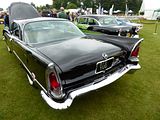
1958 Buick
1967 Chevrolet Camaro SS Coupe
1982 Pontiac Firebird
As well as an early, 1967 Mustang, Convertible there were a couple of more recent 5th generation Mustangs from the last 10 years here
2010 Dodge Challenger R/T
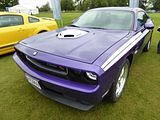
OTHER DISPLAYS
In previous years, the area between the straight section of the track and the lake has been home to a number of Dealer Displays, though these had reduced somewhat in number from the first time I attended the event. There were none at all in this area in 2015, with those dealers still presenting their cars now located in the main arena part of the event. But this space was still being put to good use as there were a number of things to see.
HISTORIC ICE CREAM VANS
Notable, and certainly something rather different, was this collection of old Ice Cream Vans. These are the sorts of vehicles which when in service, few of us pay much attention to, more interested in the product that they are selling than the vehicle from which it is sold. All sorts of vans and commercial vehicles have been converted, with purpose- designed bodies which can accommodate not just the freezers in which to store the product but also with a higher roof so the operative can stand up whilst serving.
POLICE DISPLAY
Cheshire Police always have a display here, and it proves a popular attraction. As well as showing some of their latest vehicles, which the public can inspect in less difficult situations than when they might otherwise encounter them, there are a number of other displays around road safety aimed at getting some key messages across in an less threatening (though quite sobering) way.
TRADE STANDS
There are all manner of Trade Stands, located in the central part of the event. Many of these are selling produce, a lot of it very tempting looking food and drink. Unlike a lot of events like this where there is a limited choice of over-priced and generally rather unpleasant burgers and other fast food, here the emphasis tends to be on local producers with all sorts of goodies ranging from local sausages and pies to freshly produced juice, home-made cakes and various alcohol beverages. There are lots of craft stalls as well, and plenty of merchants offering car related products and services ranging from detailing kits and consumables such as oil and filters, as well as services such as restoration work and insurance. The stall holders are all very friendly, and you could easily spend a significant proportion of your day in this part of the Show.
Needing little in the way of introduction was this early Series 1 Jaguar E Type Roadster.
Displayed together were this Renault Clio V6 and R5 GT Turbo Raider which SP Automotive were showing in their display, as examples of the work that they can do on restoration, paintwork and “upgrading” a car.
This Renault R5 Turbo was also parked up in one of the marquees.
This Ferrari 275 GTB/4 was parked up in a number of different locations during the two days I was there. A car this special feels like it ought to have some display all of its own, but instead it was simply “parked”
NEW CARS
There were fewer dealer displays of new cars here than in previous years. That meant that there was space for them all on the main lawn area, to one side of the Paddock.
AUDI
With a new R8 model announced at Geneva earlier in the year, this is the swansong year for the supercar which came from Ingolstadt in 2007 and proved to everyone that you really can have a dramatic looking car with explosive performance that you can use every day without having to buy a product from the western side of Stuttgart. The Audi R8 may have been around for over 8 years, and changed almost not at all in looks in that time, but it sitll pulls heads wherever one appears even now. This was a Spider, which is even more desirable (when the sun is shining) to many people than the Coupe. This one was actually on a stand from a specialist car rental company.
BENTLEY
The Bentley works is only just up the road in Crewe, and so this is a local event for the marque. Accordingly, they take it very seriously and act as an event sponsor. That means that a number of their cars are pressed into service as course cars, but also that they can easily ship an array of their latest models for people to inspect close up. These were to be found in the Paddock, leaving the display area here clear for a dealer to use The dealer in question was Bentley Birmingham who brought along the latest Mulsanne, Continental GT Coupe and GTC and there was also another example of the GTC on the adjacent specialist car rental stand along with the Audi R8.
Parked alongside them was this splendid 1930 Speed Six 6.5 litre model, with a Gurney Nutting body and once the property of Wolf Barnato, which is referred to as the Blue Train Bentley, for the exploits of racing the famous Blue Train from Cannes all the way to the channel port in Calais. Although this car, GJ3811 is the one in Terence Cuneo’s well-known painting, there is some conjecture that the Blue Train from Cannes to Calais had been outpaced with a different car. Barnato referred to it only as “my Speed Six saloon”. What is known is that this car was commissioned by Barnato with a sweeping roofline, and was one of the first ever fastbacks in which the rearmost seat was placed sideways. The rakish black (and later also dark olive) Gurney Nutting body had smart gadgetry, a cocktail cabinet, and reputedly accomplished the dramatic drive in March 1930 as a result of a wager in a gentlemen’s club. The Blue Train ran from Cannes to Calais, and Barnato aimed not so much to beat it, as show how easily it could be done. The company needed all the publicity it could get, it was on the brink of receivership, and as principal shareholder he was fretting. In reality the contest demanded neither great speed, nor exceptional staying power, except perhaps from the crew of the car. Barnato set off with his golfing friend Dale Bourn, not from the railway station at Cannes – that would have looked like a stunt – but from the bar at the Carlton. They waited for word that the Blue Train was departing, finished their drinks, and left. There were no autoroutes. Fuel was arranged in advance overnight, Esso filling stations remained open at Aix-en-Provence and Lyons, and a tanker lorry at Auxerre, while the train made its leisurely progress. From Cannes it went west along the Cote d’Azur, stopping for 70 minutes in Marseille, before heading North for Paris where it wasted three hours going from the Gare d’Orleans to the Gare du Nord. The Bentley pressed on without a pause, reaching Boulogne with an hour to spare before the ferry, and getting to London in time for a celebration drink at Bourn’s club, The Conservative, in St James’s Street. It was 3.20 on the London Victoria clock, according to Barnato, and the Blue Train was not due in Calais for another four minutes. The pair then parked outside the RAC in Pall Mall for the hall porter to stamp their cards having averaged 43.43mph. There has always been lots of interest in the Blue Train race. More recently, historians have been careful to take into account a possibility that the Gurney Nutting fastback was not the car that took part. In 2006 Mike Cassell wrote in the Financial Times about a re-enactment, trying to clear up the confusion. After US businessman McCaw bought the Gurney Nutting coupé illustrated in Cuneo’s picture, research suggested that Barnato may have used his saloon 6½. The McCaws tracked this down from its chassis number, reuniting it with its original Mulliner saloon bodywork, which had been re-mounted on another chassis. They then owned both. Mike Cassell’s re-enactment left the Carlton Hotel in Cannes before dawn, finding a sprinkling of snow on the mountain peaks of the Napoleonic route. They were not burdened with finding where Barnato’s pre-arranged refuelling stops were, nor did they suffer a puncture. However they did manage a meal and a decent night’s sleep near Dijon, completing the 750 miles in 37 hours against Barnato’s in 20hr 35min.
LAMBORGHINI
This Huracan was on the Oracle Financial Solutions stand. I am sure the idea was that the company would find a financial solution to make a car like this affordable. Dream on!
LOTUS
The latest Lotus models were displayed by Cheshire dealer Oakmere, who mixed these British sports cars with other marques that they also sell. Cars on show included the latest Exige V6 Cup and the regular car, a trio of Elise models including a regular S car, a Sprint and an S Cup as well as a couple of the larger and rather costly Evora.
MAZDA
Along with a couple of the soon to be replaced NC Series Mazda MX5 models, Mazda was represented among the Oakmere car by a pair of the newly announced CX3, Mazda’s entrant in the ever-popular B-segment Crossover market. This model has had mixed reviews, with some declaring it a disappointment, at least in diesel guise, which is a pity, as it looks good, as does the entire rest of the Mazda range, and the interior is well finished and the car scores highly on practicality.
McLAREN
Joining the Lamborghini Huracan on the Oracle Financial stand was another supercar, the MP4 12C in GT3 guise.
MORGAN
Oakmere are also dealers for Morgan and there were several of the Malvern Link company’s products on show as well. including the Plus 8 and the Roadster, the Three Wheeler and the new Aero 8 which was launched at the Geneva Show in March.
TOYOTA
Final brand in the Oakmere portfolio is Toyota and there were two very different cars on show, one of which you can buy and one of which you cannot, at least not in the form displayed. The one available to purchase is the GT86, that sporting 2+2 rear wheel drive Coupe which wowed the press but which has not sold in anything like the volume that you might have expected or its maker would have hoped for. The other car was the Avensis used in the current Touring Car championship.
CAR CLUB DISPLAYS
Car Clubs are very much a part of this event, and over 50 register to bring anything from a couple to a couple of dozen of their members’ cars along. There is always a good mix of Marque or Model Clubs and those representing a geography, and some of those Clubs present combine both these aspects. Certainly many of the cars that you get here are ones which you are unlikely to see at events further south as these are Northern-based classics. The Car Club areas were marked out for the entire weekend, but there were very different presences on the two days I attended, so some spaces were all but empty on one day, but replete with the cars the next and vice versa. Not surprisingly, there were more cars in total on the Sunday.
ABARTH
Although there are plenty of Abarth owners in the North West, for some reason this event has never really captured the imagination of many of them, and of the handful of cars that were here on either day, only Tom Mallon is really that local, everyone else having travelled a fairly significant distance. On the Saturday there were just 4 Abarth models present, all of them 500 based, with my regular 500 the oldest and least potent. Joining it were a couple of 595 Hatch models and Ed Tan’s 595C Turismo.
On the Sunday, there were a couple of Punto Evo models, the more recent being Ashley Gibson’s SuperSport as well as a trio of 500-based cars to look at.
ALFA ROMEO
Slightly surprisingly, there was only one Alfa Romeo in the Club Displays, one of the cars shown by the Cheshire Car Club., It was a rather nice 105 Series 1750 GTV.
ALVIS
This is a TE21. Sold between 1963 and 1966, the TE Series was a three litre sports saloon or drophead coupé, with a body built by Mulliner Park Ward. It was an updated version of the 1958 TD21. The body was a modified version of the TC 108G styled by Graber of Switzerland but built by Mulliner Park Ward and distinguished by having twin headlights mounted one above the other. The design was noted for its lack of bright side trim or creases moulded into the body parts. The windscreen was one-piece, curved, and not too highly sloped. The 2993 cc engine, first used in the 1950 TA 21, received a modified cylinder head and manifold which increased power to 130 bhp at 4000 rpm giving the car a top speed of 107 mph A choice of automatic or five speed gearbox made by ZF was available. Suspension was independent at the front using coil springs, with leaf springs at the rear. Disc brakes were fitted to all wheels. Recirculating-ball-type steering gear was fitted to reduce effort and power steering became optional in late 1964. Although the car was replaced by the TF 21 in 1966, the TE 21 was still in stock and “available to special order” until 1967. The TF21 was visually identical to the TE21, but had revised steering, suspension and trim details. Alvis ceased the manufacture of passenger cars in 1967.
AUDI
There was a strong showing from the Quattro Owners Club, with several cars on display. The idea for a high-performance four-wheel-drive car was proposed by Audi’s chassis engineer, Jörg Bensinger, in 1977, when he found that the Volkswagen Iltis could outperform any other vehicle in snow, no matter how powerful. Bensinger’s idea was to start developing an Audi 80 variant in co-operation with Walter Treser, Director of Pre-Development.. Following an unveiling on 1st March 1980, Audi released the original Quattro to European customers in late 1980, with the car featuring Audi’s quattro permanent four-wheel drive system (hence its name), and the first to mate four-wheel drive with a turbocharged engine. The original engine was the 2,144 cc in-line-5-cylinder 10 valve SOHC, with a turbocharger and intercooler. It produced 197 bhp propelling the Quattro from 0 to 100 km/h in 7.1 seconds, and reaching a top speed of over 220 km/h (137 mph). The engine was eventually modified to a 2,226 cc inline-5 10 valve, still producing 197 bhp, but with peak torque lower in the rev-range. In 1989, it was then changed to a 2,226 cc inline-5 20v DOHC setup producing 217 bhp, now with a top speed of 230 km/h (143 mph) Audi Quattros are referred to among owners and enthusiasts by their engine codes, to differentiate between the earlier and later versions: the earliest 2144 cc 10v being the “WR” engine, the 2226 cc 10v being the “MB” engine, and the later 20v being the “RR” engine. Hence, Quattro models may be referred to as either the WR Quattro, MB Quattro, and RR or “20v” Quattro, respectively. Quattro car production was 11,452 vehicles over the period 1980–1991,and through this 11 year production span, despite some touch-ups, there were no major changes in the visual design of the vehicle. For the 1983 model year, the dash was switched from an analogue instrument cluster, to a green digital liquid crystal display (LCD) electronic instrument cluster. This was later changed in 1988 to an orange LCD electronic instrument cluster. The interior was redesigned in 1984, and featured a whole new dash layout, new steering wheel design, and new centre console design, the switches around the instrument panel were also redesigned at this time. In 1985 the dash changed slightly with harder foam and lost a diagonal stripe, the dash switches were varied slightly and the diff lock pull knob gave way to a two-position turning knob with volt and oil temp digital readouts. External styling received very little modification during its production run. Originally, the car had a flat fronted grille featuring four separate headlamp lenses, one for each of the low and high beam units. This was altered for the 1983 model year, and replaced with combined units featuring a single lens, but housing twin reflectors. This was changed again, for the 1985 model year, in what has become known as the ‘facelift model’ and included such alterations as a new sloping front grille, headlights, and trim and badging changes. Max speed was 124 mph. The RR 20v Quattro also featured a new three spoke steering wheel design, leather covering for door arm rests, gloveboxes, centre console and door pockets. There was also a full length leather-wrapped centre console running all the way to the rear seats. The 20v was also the first Ur-Q to have “quattro” script interior with partial leather seats. The floor on the drivers side had a bulge due to dual catalytic exhaust setup. The different models may be distinguished by the emblems on their boot lids: the WR had a vinyl ‘quattro’ decal or a brushed aluminium effect plastic emblem, the MB had chrome plated ‘audi’, ‘audi rings’ and ‘quattro’ emblems, whilst the RR had only chrome plated ‘audi rings’. The rear suspension was altered early on with geometry changes and removal of the rear anti-roll bar to reduce a tendency for lift-off oversteer. For the 1984 facelift, the wheel size went from 6×15-inch with 205/60-15 tyres to 8×15-inch wheels with 215/50-15 tyres. At the same time the suspension was lowered 20 mm with slightly stiffer springs for improved handling. For 1987, the Torsen centre differential was used for the first time, replacing the manual centre differential lock. The last original Audi Quattro was produced on 17 May 1991, more than two years after the first models of the new Audi Coupe range (based on the 1986 Audi 80) had been produced.
Parked up with the Quattro cars was another one with a similar body style and a quattro badge. But this was a version of the Coupe, which shared the same basic body design, but was a much cheaper car. The Coupe joined the urQuattro in Audi’s range in the autumn of 1980, and was commercially the far more significant car. Offered initially with the 5 cylinder engine with carburettors, producing 136 bhp and front wheel drive, the range was gradually expanded up (with a fuel injected model) and down, with less powerful 4 cylinder cars. A facelift in the autumn of 1984 tidied up the styling and brought the quattro four wheel drive system into the range as an option for the first time. Plenty of people in recent times have got very excited by the mention of an Audi quattro available for a bargain price only to discover that it is one of these and not the turbocharged urQuattro. That said, it is still a nice car, a real 4 seater Coupe, and probably rather rarer than its more exotic brother.
AUSTIN
This A55 Cambridge was in the Cheshire Car Club display. In September 1954, Austin had dusted off the Cambridge name that they had used on some of their Ten models in the late 1930s, and applied it to a new pairing of A40 and A50 models which replaced the Somerset. The A40 and A50 Cambridge models were entirely new, with modern unibody construction and new styling with integrated wings and a full width grille which was initially quite rounded, though a facelift in 1957, creating the first A55 changed that somewhat, before the more significant new look came in 1959 with the Farina styled cars. Initially the Austin Cambridge was only offered with a 4-passenger, 4-door saloon body, although a few pre-production 2-door models were also made. A van derivative introduced in November 1956 and a pick up that followed in May 1957 remained available until 1974. The A40 had a 1.2 litre straight-4 pushrod engine B-Series engine based on the one used in the previous Austin Somerset, although sharing no parts. A maximum power output of 42 bhp was claimed, transmitted to the wheels by means of a four-speed gear box controlled with a column-mounted lever. Only 30,666 A40 Cambridge models were produced, as it was the A50 version of the Cambridge, introduced at the same time, but with a new 1489 cc B-Series four-cylinder engine with single Zenith carburettor which was good for 50 hp which would prove far more popular . It sold better and remained in production through to 1957 with 114,867 A50s being produced The de luxe version had a heater, leather seat facings, carpets replacing the standard rubber matting, armrests on the doors, twin-tone horns, a passenger sun visor, and some extra chrome including overriders. Technical advances in the A50 Cambridge included an optional Borg-Warner overdrive unit for the top three (of four) gears. A semi-automatic transmission (branded “manumatic” and providing pedal-free clutch operation) was also offered, but it was unpopular with buyers. A number of modifications were introduced in October 1956 including smaller 13 in wheels and increased compression ratio (8.3:1). A de luxe version tested by The Motor magazine in 1955 had a top speed of 73.6 mph and could accelerate from 0–60 mph in 28.8 seconds. A fuel consumption of 28.0 mpg was recorded. The test car cost £720 including taxes. Austin updated the model in 1957 with new styling front and rear and a more powerful engine, and it was one of these cars which was to be seen here.
AUSTIN HEALEY
The Austin Healey Owners Club had a display area which contained a mix of the two main models that were sold under this branding between 1952 and 1970, the Sprite, and the “Big Healey”. The Sprites were the Mark 1 model, affectionately known in the UK as the “Frog Eye”. The Sprite was announced to the press in Monte Carlo by the British Motor Corporation on 20 May 1958, just before that year’s Monaco Grand Prix. It was intended to be a low-cost model that “a chap could keep in his bike shed”, yet be the successor to the sporting versions of the pre-war Austin Seven. The Sprite was designed by the Donald Healey Motor Company, with production being undertaken at the MG factory at Abingdon. It first went on sale at a price of £669, using a tuned version of the Austin A-Series engine and as many other components from existing cars as possible to keep costs down. It was produced for a little over 3 years before being replaced by a Mark 2 version, which was then joined by a badge-engineered MG version, the Midget, reviving a model name used by MG from the late 1920s through to the mid 1950s. Enthusiasts often refer to Sprites and the later Midgets collectively as “Spridgets.” The first Sprite quickly became affectionately known as the “frogeye” in the UK and the “bugeye” in the US, because its headlights were prominently mounted on top of the bonnet, inboard of the front wings. The car’s designers had intended that the headlights could be retracted, with the lenses facing skyward when not in use; a similar arrangement was used many years later on the Porsche 928. But cost cutting by BMC led to the flip-up mechanism being deleted, therefore the headlights were simply fixed in a permanently upright position, giving the car its most distinctive feature. The body was styled by Gerry Coker, with subsequent alterations by Les Ireland following Coker’s emigration to the US in 1957. The car’s distinctive frontal styling bore a strong resemblance to the defunct American 1951 Crosley Super Sport. The problem of providing a rigid structure to an open-topped sports car was resolved by Barry Bilbie, Healey’s chassis designer, who adapted the idea provided by the Jaguar D-type, with rear suspension forces routed through the bodyshell’s floor pan. The Sprite’s chassis design was the world’s first volume-production sports car to use unitary construction, where the sheet metal body panels (apart from the bonnet) take many of the structural stresses. The original metal gauge (thickness of steel) of the rear structure specified by Bilbie was reduced by the Austin Design Office during prototype build, however during testing at MIRA (Motor Industry Research Association) distortion and deformation of the rear structure occurred and the original specification was reinstated. The two front chassis legs projecting forward from the passenger compartment mean the shell is not a full monocoque. The front sheet-metal assembly, including the bonnet (hood) and wings, was a one-piece unit, hinged from the back, that swung up to allow access to the engine compartment. The 43 bhp, 948 cc OHV engine (coded 9CC) was derived from the Austin A35 and Morris Minor 1000 models, also BMC products, but upgraded with twin 11⁄8 inch SU carburettors which gave it 43 hp at 5200 rpm and 52 lb/ft at 3300 rpm. When tested by “The Motor” magazine in 1958. It had a top speed of 82.9 mph and could accelerate from 0-60 mph in 20.5 seconds. Fuel consumption of 43 mpg was recorded. The rack and pinion steering was derived from the Morris Minor 1000 and the front suspension from the Austin A35. The front suspension was a coil spring and wishbone arrangement, with the arm of the Armstrong lever shock absorber serving as the top suspension link. The rear axle was both located and sprung by quarter-elliptic leaf springs, again with lever-arm shock absorbers and top links. There were no exterior door handles; the driver and passenger were required to reach inside to open the door. There was also no boot lid, owing to the need to retain as much structural integrity as possible, and access to the spare wheel and luggage compartment was achieved by tilting the seat-backs forward and reaching under the rear deck, a process likened to potholing by many owners, but which resulted in a large space available to store soft baggage. The BMC Competition Department entered Austin Healey Sprites in major international races and rallies, their first major success coming when John Sprinzel and Willy Cave won their class on the 1958 Alpine Rally. Private competitors also competed with much success in Sprites. Because of its affordability and practicality, the Austin Healey Sprite was developed into a formidable competition car, assuming many variants by John Sprinzel, Speedwell and WSM. The Sebring Sprite became the most iconic of the racing breed of Austin Healey Sprites. Many owners use their Austin Healey Sprites in competition today, fifty years after its introduction. 48,987 “frogeye” Sprites were made and the car remains popular to this day.
There were rather more examples of the “Big Healey”. This is a somewhat earlier design that that of the Sprite. Donald Healey had been producing a range of expensive sports cars from the 1940s, cars such as the Silverstone, the Abbott and the Farnham. For the 1952 London Motor Show, he produced a new design, which was called the Healey Hundred, based on Austin A90 mechanicals, which he intended to produce in-house at his small car company in Warwick. It was one of the stars of the 1952 Show, and it so impressed Leonard Lord, the Managing Director of Austin, who was looking for a replacement to the unsuccessful A90. that Lord struck a deal with Healey on the spot, to build it in quantity. Bodies made by Jensen Motors would be given Austin mechanical components at Austin’s Longbridge factory. The car was renamed the Austin-Healey 100, in reference to the fact that the car had a top speed of 100 mph. Production got under way in 1953, with Austin-Healey 100s being finished at Austin’s Longbridge plant alongside the A90 and based on fully trimmed and painted body/chassis units produced by Jensen in West Bromwich—in an arrangement the two companies previously had explored with the Austin A40 Sports. By early 1956, production was running at 200 cars a month, 150 of which were being sold in California. Between 1953 and 1956, 14,634 Austin-Healey 100s were produced, the vast majority of them, as was the case for most cars in this post war era, going for export. The car was replaced by an updated model in 1956, called the 100-6. It had a longer wheelbase, redesigned bodywork with an oval shaped grille, a fixed windscreen and two occasional seats added (which in 1958 became an option with the introduction of the two-seat BN6 produced in parallel with the 2+2 BN4), and the engine was replaced by one based on the six-cylinder BMC C-Series engine. In 1959, the engine capacity was increased from 2.6 to 2.9 litres and the car renamed the Austin-Healey 3000. Both 2-seat and 2+2 variants were offered. It continued in this form until production ceased in late 1967. The Big Healey, as the car became known after the 1958 launch of the much smaller Austin-Healey Sprite, is a popular classic now. You come across the 3000 models more frequently than the 100s, as they accounted for more than 60% of all Big Healey production. There were examples of both here.
BENTLEY
Mulsanne
BERKLEY
Among the smallest cars on show were these Berkley models. The Berkeley automobile was a collaboration between designer Lawrence “Lawrie” Bond and the Berkeley Coachworks factory owned by Charles Panter, which at the time was one of the largest manufacturers of caravans in Europe. It was an ideal project for Berkeley, who had developed considerable skills in the use of Glass-reinforced plastic, and were looking for something to fill the gaps in the very seasonal caravan market. What Panter and Bond wanted to achieve was “something good enough to win World 750cc races… but cheap, safe, easily repairable and pretty.”The early cars were an immediate success on the home market, and several derivative models were spawned over the four years of car production. Export markets, most notably the United States, were exploited and the cars earned a reputation for fun, if fragile, sports motoring on a budget. Recognising the threat posed by the newly introduced Mini and Austin-Healey Sprite in the late fifties, the company started to develop a more conventional model with the support of Ford. The caravan market collapsed towards the end of 1960, and Berkeley’s poor cash flow forced the company into liquidation on 12 December 1960, taking its car manufacturing activities with it. After having produced about 4100 cars of various types, the workforce was laid off shortly before Christmas that year. An attempted sale of the company to Sharp’s Commercials Ltd (manufacturer of the Bond Minicar) came to nothing, and the company’s assets were liquidated in 1961. The factory was later used by Kayser Bondor Ltd to make women’s underwear, but it was demolished in 2002 and the site turned over to housing. A road named ‘Berkeley Close’ in the housing estate provides the only obvious link to the car factory. Today there is an active owner’s club (the Berkeley Enthusiasts’ Club), which provides a range of parts and services aimed at preserving the remaining few hundred cars known to survive worldwide. Berkeley’s first production car was the ‘Sports’ (type SA322), announced in September 1956 and produced from October 1956 to January 1957. Production began with two prototypes (registered RMJ395 and RMJ946), which were seen being tested with enthusiasm around the neighbourhood of Biggleswade in the late summer of 1956. Stirling Moss drove one at Goodwood in September, and the car was launched to the public at the 1956 London Motor Show – one year ahead of the Lotus Elite, which was also to be of fibreglass monocoque construction. Bond’s attractive 2-seater open tourer design capitalised on Berkeley’s GRP experience, and consisted of three large mouldings (floor or ‘punt’, nose, tail) with no conventional chassis. The front edges to the doors slanted forward so that when the doors were opened they hinged upwards and then closed by themselves. Although usually configured as a two-seater with simple bench seat, a hatch could be removed from behind the front seat, revealing a compartment normally containing the spare wheel and some luggage space which could double as a basic seat for a small child. Equipment was basic, even the fuel gauge was an optional extra. Power was provided by a British Anzani twin-cylinder 322 cc two-stroke engine producing 15 bhp and mounted transversely, driving the front wheels via a chain and three-speed gearbox. The engine was already used by various motorcycle manufacturers such as Cotton and Greeves, but in the Berkeley was fitted with a Siba Dynastart to provide both battery charging and electric starting. It was a very advanced two-stroke engine which incorporated a rotary inlet valve mechanism in the centre of the crankshaft. The gearbox was a three-speed Albion HJR5, utilising a steering column-mounted gearchange.The car had all-round independent suspension by coil springs and in spite of the tiny engine gave remarkably good performance owing to its light weight (kerb weight 605 lb and excellent roadholding. Girling hydraulic brakes with 7 in drums were used. After 163 of the SA322 cars had been manufactured, a change was made to the SE328 model with a 328 cc Excelsior engine offering 18 bhp. The production run ran from Jan 1957 to April 1958 with chassis numbers from 164 to 1422, many being exported to the United States where it sold for approximately $1600. The manufacture touted the number 70, meaning it could reach 70 mph and had an average fuel economy of 70 mpg. The export model was differentiated by having separate headlamps whereas on the home market they were faired into the wings, although the export type lamps could be specified. Early cars from Jan 1957 to about chassis number 476 in June 1957 still used a column gear change. During their production run a Deluxe model was offered which was bodily the same but featured polished wheel trims and spinners, tachometer and twin carburettors. The chassis plate was similar to the Anzani type on the early cars but was later changed to a printed type fitted to the bulkhead above the brake master cylinder. Most of these cars had the three-speed gearbox similar to the Anzani except for the mounting flanges. All of the cars had the sloping leading edges to the doors. The SE328 enjoyed considerable success and press exposure through their involvement with lightweight motor racing, and their famous drivers included Pat Moss who drove one in the 1958 Liège-Brescia-Liège rally for cars up to 500cc. The Berkeley team – a works-supported entry of six cars including BBC commentator Robin Richards – led as far as Slovenia, but slow climbing in summer heat found their weakness and Pat ended up being towed back to Italy by another Berkeley. None of the Berkeleys finished the event. In late 1957 a new derivative model was introduced, using a 30 bhp Excelsior three-cylinder 492 cc engine with triple carburettors. This engine configuration was made possible by the vertically split crankcase of the Excelsior engine and modular crankshaft and barrels, which made adding a central cylinder relatively easy. A four speed gearbox was standardised. The top speed was now 80 mph. The production ran from October 1957 to March 1959 with chassis numbered 1 to 666. From about October 1958, in order to coincide with the introduction of the ‘Foursome’, they were renamed the ‘Twosome’. Also at the 1958 Motor Show a Fixed Head (or Hardtop) was announced and displayed that had external as well as the usual internal door handles, but there are no records that this body style actually reached production. It is probable that cars pre chassis number 120 (approx), about April 1958, had similar bodies to the early Berkeley “Sports” cars. Cars from about April 1958 to the end of production had vertical front door edges and internal door hinges, as well as body moulding and a few mechanical changes. Early cars were fitted with the four speed TR gearbox whilst later cars had the larger and stronger VR gearbox. The cars enjoyed some success in Motor Sport and Giovanni Lurani bought three which he took to Italy, fitted them with his own design of hardtop, and running them in the 750 cc GT class, one driven by Lorenzo Bandini finishing first in the 1958 Monza 12 hour race. Reliability, always questionable with the air-cooled two-strokes, became more of an issue with the extra heat generated by the triple, and there are many recorded reports of warranty claims. At one point the US authorities appear to have stopped a shipment of Berkeleys at the dock pending rectification of what they considered a serious design issue. There seems little doubt that profitability of the Berkeley programme was impacted as a result of these claims and the aggressive export drive to markets not familiar with the eccentricities of British sports motoring. Announced in October 1958, the Foursome model was wider and longer than its forebears and differed structurally in that the rear swinging arms were lower and external to the body, and the spare wheel was mounted at the rear of the car. The type reference is supposed to be SE492/4 but one has the reference B.100. The chassis numbers are D1/1 to D1/19 but then again one example has D1/100, this particular car could be the prototype since it appears in publicity pictures. The list price of the Foursome was £700 including Purchase Tax, with an additional £28 for the optional hardtop. Seen here is a Twosome.
CHEVROLET
Camaro SS Coupe
DAIMLER
Quite a rarity and a very elegant machine indeed was this Sovereign 4.2 Coupe. First shown in September 1973, at the same time as the Series 2 versions of the Jaguar XJ6/12 and related Daimler Sovereign and Double Six models, it soon became clear that the Coupe was not ready for production, with problems surrounding the window sealing. The economic troubles unfolding in the western world at this time seem to have reduced further any sense of urgency about producing and selling the cars, so it was a further two years before the Coupés finally started to appear in Jaguar showrooms. The Coupé was based on the short-wheelbase version of the XJ. The elongated doors were made out of a lengthened standard XJ front door, with the weld seams clearly visible under the interior panels where two front door shells were grafted together with a single outer skin. Even with the delay, these cars suffered from water leaks and wind noise. All coupes came with a vinyl roof as standard. Since the coupe lacked B-pillars, the roof flexed enough that the paint used by Jaguar at the time would develop cracks. More modern paints do not suffer such problems, so whenever a coupe is repainted it is viable to remove the vinyl. Today many XJ-Cs no longer have their vinyl roof, also removing the threat of roof rust. Some owners also modified their XJ-C by changing to Series III bumpers. This lifted the front indicators from under the bumper and provided built in rear fog lights. Both six and twelve-cylinder models were offered, along with Daimler badged versions. However, the delayed introduction, the labour-intensive work required by the modified saloon body, the higher price than the four-door car, and the focus on the new XJ-S all contributed to a short production run of just two years. 6,505 of the 4.2 and 1,873 of the V12 Jaguar models were made, along with 1677 Daimler Sovereign and 477 Double Six models, making a total of 10,426. Nowadays, the cars are much respected for their elegant design.
FERRARI
Just two Ferrari models were in this section of the event, both of them V8 cars, a Dino 308 GT4 and the more recent California.
FIAT
Sole Fiat representation here was an array of Coupe models. It is now more than 20 years since this distinctive Chris Bangle hit UK streets, and if you thought the car was good looking then, you will surely appreciate it now. Looking at its best in bright colours, as most of the display cars here were, this was a practical 4 seater that was genuinely good to drive, especially when Fiat upgraded the engines from 4 cylinders to 5, creating with the 220 bhp 20V Turbo car one of the fastest front wheel drive cars on sale at the time. A tax friendly 1800cc 4 cylinder came late to the range, but these were aimed more at Italy than here. The Coupe was only on sale in the UK for 4 years, but it was quite popular and it is believed that there are still around 1000 of them on our roads.
FORD
Fords were represented by the RS Enthusiasts Club and there were plenty of sporting models on show
Possibly the rarest of them was this Fiesta XR2. The XR2 was the first truly sporting Fiesta, as the earlier S badged cars were mechanically the same as the other models in the range and even the Supersport which was offered in Europe for the 1980 model year, used the regular 1.3 litre Kent Crossflow engine. It was well enough received, though, to convince Ford to introduce in October 1981 their second XR-badged model, following the October 1980 launch of the Escort XR3. The XR2 featured a 90 bhp 1.6 litre engine and is easily identified from the black plastic trim which was added to the exterior and interior. The small square headlights were replaced with larger circular ones resulting in the front indicators being moved into the bumper to accommodate the change. With a quoted performance of 0–60 mph in 9.3 seconds and a 105 mph top speed, the XR2 hot hatch became a cult car beloved of boy racers throughout the 1980s meaning that very few have survived. When the Fiesta was given a very comprehensive makeover in the autumn of 1983, it did not take long for the changes to be applied to the XR2, with the updated model going on sale in June 1984 and it is one of these that was seen here.
There were sporting versions of all 4 generations of Escort. Only the later, front wheel drive based models were represented here, with Cabrio and the facelifted version of the XR3i from the third generation seen with the still dramatic fourth generation based RS Cosworth.
There were a couple of the legendary Sierra Cosworth models here, too. This version of Ford’s upper-medium sized family car, built by Ford Europe from 1986 to 1992, was the result of a Ford Motorsport project with the purpose of producing an outright winner for Group A racing in Europe. The project was defined in the spring of 1983 by Stuart Turner who had recently been appointed head of Ford Motorsport in Europe, and he realised right away that Ford was no longer competitive in this area. Turner got in touch with Walter Hayes, at the time the vice-president of public relations at Ford, to get support for the project. Hayes had earlier been the driving force behind the development of the Ford GT40 that won Le Mans in 1966, and the Cosworth DFV engine that brought Ford 154 victories and 12 world championships in Formula One during the 1960s and 1970s. Hayes found the project very appealing and promised his full support. Turner then invited Ken Kohrs, vice-president of development, to visit Ford’s longtime partner, the automotive company Cosworth, where they were presented a project developed on Cosworth’s own initiative, the YAA engine. This was a twin cam, 16-valve engine based on Ford’s own T88 engine block, better known as the Pinto. This prototype proved an almost ideal basis for the engine Turner needed to power his Group A winner. Therefore, an official request for a turbocharged version (designated Cosworth YBB) capable of 180 HP on the street and 300 HP in race trim, was placed. Cosworth answered positively, but they put up two conditions: the engine would produce not less than 204 HP in the street version, and Ford had to accept no fewer than 15,000 engines. Turner’s project would only need about 5,000 engines, but Ford nevertheless accepted the conditions. The extra 10,000 engines would later become one of the reasons Ford also chose to develop a four door, second generation Sierra RS Cosworth. To find a suitable gearbox proved more challenging. The Borg-Warner T5, also used in the Ford Mustang, was chosen, but the higher revving nature of the Sierra caused some problems. Eventually Borg-Warner had to set up a dedicated production line for the gearboxes to be used in the Sierra RS Cosworth. Many of the suspension differences between the standard Sierra and the Cosworth attributed their development to what was learned from racing the turbocharged Jack Roush IMSA Merkur XR4Ti in America and Andy Rouse’s successful campaign of the 1985 British Saloon Car Championship. Much of Ford’s external documentation for customer race preparation indicated “developed for the XR4Ti” when describing parts that were Sierra Cosworth specific. Roush’s suspension and aerodynamics engineering for the IMSA cars was excellent feedback for Ford. Some production parts from the XR4Ti made their way into the Cosworth such as the speedometer with integral boost gauge and the motorsport 909 chassis stiffening plates. In April 1983, Turner’s team decided on the recently launched Sierra as a basis for their project. The Sierra filled the requirements for rear wheel drive and decent aerodynamic drag. A racing version could also help to improve the unfortunate, and somewhat undeserved, reputation that Sierra had earned since the introduction in 1982. Lothar Pinske, responsible for the car’s bodywork, demanded carte blanche when it came to appearance in order to make the car stable at high speed. Experience had shown that the Sierra hatchback body generated significant aerodynamic lift even at relatively moderate speed. After extensive wind tunnel testing and test runs at the Nardò circuit in Italy, a prototype was presented to the project management. This was based on an XR4i body with provisional body modifications in fibreglass and aluminium. The car’s appearance raised little enthusiasm. The large rear wing caused particular reluctance. Pinske insisted however that the modifications were necessary to make the project successful. The rear wing was essential to retain ground contact at 300 km/h, the opening between the headlights was needed to feed air to the intercooler and the wheel arch extensions had to be there to house wheels 10” wide on the racing version. Eventually, the Ford designers agreed to try to make a production version based on the prototype. In 1984, Walter Hayes paid visits to many European Ford dealers in order to survey the sales potential for the Sierra RS Cosworth. A requirement for participation in Group A was that 5,000 cars were built and sold. The feedback was not encouraging. The dealers estimated they could sell approximately 1,500 cars. Hayes did not give up, however, and continued his passionate internal marketing of the project. As prototypes started to emerge, dealers were invited to test drive sessions, and this increased the enthusiasm for the new car. In addition, Ford took some radical measures to reduce the price on the car. As an example, the car was only offered in three exterior colours (black, white and moonstone blue) and one interior colour (grey). There were also just two equipment options: with or without central locking and electric window lifts. The Sierra RS Cosworth was first presented to the public at the Geneva Motor Show in March 1985, with plans to release it for sale in September and closing production of the 5,000 cars in the summer of 1986. In practice, it was launched in July 1986. 5545 were manufactured in total of which 500 were sent to Tickford for conversion to the Sierra three-door RS500 Cosworth. The vehicles were manufactured in right hand drive only, and were made in Ford’s Genk factory in Belgium. Exactly 500 RS500s were produced, all of them RHD for sale in the UK only – the biggest market for this kind of Ford car. It was originally intended that all 500 would be black, but in practice 56 white and 52 moonstone blue cars were produced.To broaden the sales appeal, the second generation model was based on the 4 door Sierra Sapphire body. It was launched in 1988, and was assembled in Genk, Belgium, with the UK-built Ford-Cosworth YBB engine. Cylinder heads on this car were early spec 2wd heads and also the “later” 2wd head which had some improvements which made their way to the 4X4 head. Suspension was essentially the same with some minor changes in geometry to suit a less aggressive driving style and favour ride over handling. Spindles, wheel offset and other changes were responsible for this effect. Approximately 13,140 examples were produced during 1988-1989 and were the most numerous and lightest of all Sierra Cosworth models. Specifically the LHD models which saved weight with a lesser trim level such as manual rear windows and no air conditioning. In the UK, the RHD 1988-1989 Sierra Sapphire RS Cosworth is badged as such with a small “Sapphire” badge on the rear door window trims. All 1988-1989 LHD models are badged and registered as a Sierra RS Cosworth with no Sapphire nomenclature at all. “Sapphire” being viewed as a Ghia trim level that saw power rear windows, air conditioning and other minor options. Enthusiasts of the marque are mindful of this and will describe the LHD cars by their body shell configuration, 3 door or 4 door. As the Sapphire Cosworth was based on a different shell to the original three-door Cosworth, along with its more discreet rear wing, recorded a drag co-efficient of 0.33, it registered slightly better performance figures, with a top speed of 150 mph and 0-60 of 6.1 seconds, compared to the original Cosworth. In January 1990, the third generation Sierra RS Cosworth was launched, this time with four wheel drive. As early as 1987, Mike Moreton and Ford Motorsport had been talking about a four wheel drive Sierra RS Cosworth that could make Ford competitive in the World Rally Championship. The Ferguson MT75 gearbox that was considered an essential part of the project wasn’t available until late 1989 however. Ford Motorsport’s desire for a 3-door “Motorsport Special” equivalent to the original Sierra RS Cosworth was not embraced. The more discreet 4-door version was considered to have a better market potential. It was therefore decided that the new car should be a natural development of the second generation, to be launched in conjunction with the face lift scheduled for the entire Sierra line in 1990. The waiting time gave Ford Motorsport a good opportunity to conduct extensive testing and demand improvements. One example was the return of the bonnet louvres. According to Ford’s own publicity material, 80% of the engine parts were also modified. The improved engine was designated YBJ for cars without a catalyst and YBG for cars with a catalyst. The latter had the red valve cover replaced by a green one, to emphasise the environmental friendliness. Four wheel drive and an increasing amount of equipment had raised the weight by 100 kg, and the power was therefore increased to just about compensate for this. The Sierra RS Cosworth 4×4 received, if possible, an even more flattering response than its predecessors and production continued until the end of 1992, when the Sierra was replaced by the Mondeo. The replacement for the Sierra RS Cosworth was not a Mondeo however, but the Escort RS Cosworth. This was to some extent a Sierra RS Cosworth clad in an “Escort-like” body. The car went on sale in May 1992, more than a year after the first pre-production examples were shown to the public, and was homologated for Group A rally in December, just as the Sierra RS Cosworth was retired. It continued in production until 1996. The Sierra and Sapphire Cosworths were undoubted performance bargains when new, but they also gained a reputation both for suffering a lot of accidents in the hands of the unskilled and also for being among the most frequently stole cars of their generation. These days, though, there are some lovely and treasured examples around and indeed you are far more likely to see a Cosworth version of the Sierra than one of the volume selling models.
Final Fords in the display were the second generation Focus RS, a car for which subtle would not be an accurate description, but a sure-fire classic of the future much like the earlier Blue Oval products that were parked nearby.
GTM
You rarely see a GTM by itself, as these British produced kit cars only ever sold in small enough quantities that they rarely appear in normal everyday motoring. When they come to an event, such as this one, the enthusiastic Owners Club tends to bring several examples along, and that was definitely the case here. Like many low volume specialist producers, there’s quite a complex history around GTM. The firm started out creating small and relatively inexpensive kitcars in 1967, when they produced the Cox GTM, a mid-engined Mini-based machine with styling inspired by the Ferrari Dino (so it is said!). Production stopped after 5 years, and ownership of the company changed a few times over the next few years, with production of new cars, as opposed to spares, starting again in 1980, with an updated version of the GTM Coupe. The model continued to be developed and the company took advantage of the Austin-Rover K Series engine when it became available. In 1998 they launched a new car, the Libra. Three years in development, it was a collaboration between GTM Cars directors Peter Beck & Paddy Fitch, designer Richard Oakes and suspension designer Bryn Davies. Conceived as a lightweight sports car, it uses no subframes for its suspension with all the mountings being bolted straight to the GRP monocoque tub. At the front it uses unequal length wishbones of GTM design locating uprights from the Rover Metro/100 range and a forward mounted steering rack for extra legroom. The rear suspension is an unusual double trailing arm design, bolted to the rear bulkhead and using the same uprights as the front. The engine/transmission unit is held in a frame hanging off the rear bulkhead, a frame which also locates the rear hinging engine cover which incorporates a sizeable boot which can accommodate a full size set of golf clubs. The front ‘clamshell’ conceals the radiator, battery, master cylinders etc. and also manages to stow a full size spare wheel (either 16″ or 17″). A removable roof panel can be stowed behind the seats for an open top experience. Initially launched with the 1.4 litre Rover ‘K’-Series engine, the Libra has been fitted successfully with 1.6, 1.8, 1.8 VVC and KV6 2.5 litre Rover engines as well as some Honda units and the Audi 1.8 turbo engine. Production ceased in 2010, as supply of the necessary parts dried up.
HOLDEN
One of the most unusual cars of the day was this HZ Series Holden Kingswood GTS. Indeed, I suspect many would have struggled to recognise this, and may well have thought it was an American car, but the right hand drive would then have puzzled them some more. The HZ series of full-sized cars were produced in Australia between October 1977 and 1980 in a variety of equipment levels and in several different body styles. The car was also assembled in New Zealand. The HZ series received minor updates to the exterior over the HX series, itself an update on earlier models dating back to 1971. The HZ saw the introduction of what Holden termed “Radial Tuned Suspension” (RTS) across all models. RTS made significant changes to the suspension of the car, greatly improving the handling finesse, while at the same time not compromising ride quality. Modern Motor magazine described the HZ as “a great handler spoiled by the car” in a comparison against the BMW 528i, contrasted as “a great car spoiled by the handling”. In this series, the base specification Belmont was deleted and the new Kingswood SL became the base luxury level for sedans and wagons, with a lower specification Kingswood sedan and wagon only offered as a delete option on the Kingswood SL. During the course of the HZ series, equipment levels were upgraded in 1978 effectively to match improvements in the opposition Ford Falcon range, but the life of the full W size Holden looked set to end following Holden’s release of the VB Commodore in November 1978. After 1980, W sized Holden passenger cars were cancelled—replaced by the downsized Commodore. The Kingswood luxury level lived on until 1985 on the WB Holden utility but the end of HZ saw the end of the Holden Premier alongside both the GTS and Sandman which were both deleted prior to the end of the HZ series. The GTS seen here was the top model in the range.
HONDA
Focus of the Honda Owners Club was the S2000, the much missed sports car that Honda produced to mark their 50th anniversary. The S2000 was first alluded to at the 1995 Tokyo Motor Show, with the Honda Sport Study Model (SSM) concept car, a rear-wheel-drive roadster powered by a 2.0 litre inline 4-cylinder engine and featuring a rigid ‘high X-bone frame’ which Honda claimed improved the vehicle’s rigidity and collision safety. The concept car was constructed with aluminium body panels and featured a 50:50 weight distribution. The SSM appeared at many automotive shows for several years afterwards, hinting at the possibility of a production version, which Honda finally announced in 1999. It featured a front mid-engine, rear-wheel-drive layout with power being delivered by a 1,997 cc inline 4-cylinder DOHC-VTEC engine. The engine produced outputs of 237–247 hp, and 153–161 lb/ft depending on the target market., and it was mated to a six-speed manual transmission and Torsen limited slip differential. The S2000 achieved what Honda claimed as “the world’s top level, high performance 4-cylinder naturally aspirated engine”. Features included independent double wishbone suspension, electrically assisted steering and integrated roll hoops. The compact and lightweight engine, mounted entirely behind the front axle, allowed the S2000 to achieve a 50:50 front/rear weight distribution and lower rotational inertia. An electrically powered vinyl top with internal cloth lining was standard, with an aluminium hardtop available as an optional extra. Although the S2000 changed little visually during its production run, there were some alterations, especially in 2004, at which point production of the S2000 moved to Suzuka. The facelifted car introduced 17 in wheels and Bridgestone RE-050 tyres along with a retuned suspension to reduce oversteer. The spring rates and shock absorber damping were altered and the suspension geometry modified to improve stability by reducing toe-in changes under cornering loads. The subframe has also received a revision in design to achieve a high rigidity. In the gearbox the brass synchronisers were replaced with carbon fibre. In addition, cosmetic changes were made to the exterior with new front and rear bumpers, revised headlight assemblies, new LED tail-lights, and oval-tipped exhausts. Although all the cosmetic, suspension and most drivetrain upgrades were included on the Japanese and European S2000s, they retained the 2.0 litre F20C engine and remained designated as an AP1. A number of special editions were made, such as the more track-oriented Club Racer version offered in the US in 2007/8 and the Type S for Japan in 2008/9. The UK received a GT for 2009, which featured a removable hard-top and an outside temperature gauge. The S2000 Ultimate Edition (continental Europe) and GT Edition 100 (UK) were limited versions of the S2000 released to commemorate the end of production. Both included Grand Prix White body colour, removable hard top, graphite-coloured alloy wheels, red leather interior with red colouring for stitching on the gear lever gaiter. The Ultimate Edition was unveiled at the 2009 Geneva Motor Show and went on sale in March 2009. The GT Edition 100 was a limited run of 100 units released for the UK market. In addition to the Ultimate Edition’s specification, it featured a black S2000 badge and a numbered plaque on the kick-plate indicating which vehicle in the series it was. The car was never replaced, as Honda decided to head off in the same direction as Toyota, producing a series of very dull appliance-like cars that focused on low emissions and dependability but of no appeal to the sort of enthusiast who bought (and probably kept!) an S2000.
The one Honda that was not an S2000 was the much earlier S800 model. The S800 was introduced at the 1965 Tokyo Motor Show, as a replacement for the earlier Honda S600, and to compete with the Austin-Healey Sprite, MG Midget, Triumph Spitfire and Fiat 850 Spider. Like the S600, it was available as either a coupe or roadster and continued the advanced technology of its predecessors. The 791 cc straight-4 engine produced 70 hp at 8000 rpm, thus making this Honda’s first 100 mph automobile, but still allowing for 35 mpg. In April 1967 the car was described as the fastest production 1-litre car in the world thanks to its high revving engine (up to 10,000 rpm and the manufacturer’s history of manufacturing powerful relatively low capacity motor-cycle engines. In 1967, the S800 became available in Britain. By this time the model had the more conventional drive layout than had been seen in the early cars, which gave it predictable handling and a firm ride. It was also cheaper than the Mini Cooper and Triumph Spitfire. In February 1968, the S800M (aka S800MK2) was introduced with flush mounted interior door handles, side marker lights outside, dual-circuit brakes, lean burn carburation under the bonnet and safety glass. These changes were made for the American market, but the car was never imported there officially. Production ended in May 1970 with 11,536 S800s produced. Honda did not manufacture another S roadster for nearly thirty years until the release of the S2000 for the 2000 model year.
JAGUAR
There was a very varied collection of Jaguar models here, which included a progression of the sports cars through the E TYpe, seen in Series 2 and 3 guise, the XJS, XK8 and later F Type Coupe, as well as saloon models which included a Mark 2 and an X300 model XJ.
LAMBORGHINI
Lamborghini’s latest supercar, the Huracan, was here as well as a Countach 5000S.
LANCIA
There were 4 examples of the legendary Delta Integrale here, another of those icons which has enduring appeal which transcends its age. It is well over 20 years since the last new car with Lancia badges on it was sold in Britain, and indeed such as the perceived recognition and value of the brand that the recent and rather short-lived attempt to sell the Ypsilon and Delta saw them with Chrysler badges, and yet there is a Lancia that is still well known and revered by enthusiasts of all ages. That car is the legendary Delta Integrale, a model which features on the Bucket Lists of many people, me included. Whenever one appears, you always hear plenty of people saying how much they love this rather boxy hatchback which started out life in 1979 as arguably the first “premium” family-sized hatchback. Despite winning the Car of the Year award, sales were steady rather than spectacular, even when more potent 1600, injected and HF Turbo cars augmented the initial range of 1300 and 1500cc models. That all changed in April 1986 with the launch of the HF Turbo 4WD. This car was conceived to homologate a new rally car for Lancia who needed something to fill the void left by the cancellation of Group B from the end of 1986. The Delta HF 4X4 had a four-wheel drive system with an in-built torque-splitting action. Three differentials were used. Drive to the front wheels was linked through a free-floating differential; drive to the rear wheels was transmitted via a 56/44 front/rear torque-splitting Ferguson viscous-coupling-controlled epicyclic central differential. At the rear wheels was a Torsen (torque sensing) rear differential. It divided the torque between the wheels according to the available grip, with a maximum lockup of 70%. The basic suspension layout of the Delta 4WD remained the same as in the rest of the two-wheel drive Delta range: MacPherson strut–type independent suspension with dual-rate dampers and helicoidal springs, with the struts and springs set slightly off-centre. The suspension mounting provided more isolation by incorporating flexible rubber links. Progressive rebound bumpers were adopted, while the damper rates, front and rear toe-in and the relative angle between springs and dampers were all altered. The steering was power-assisted rack and pinion. The car looked little different from the front wheel drive models. In September 1987, Lancia showed a more sophisticated version of the car, the Lancia Delta HF Integrale 8V. This version incorporated some of the features of the Delta HF 4WD into a road car. The engine was an 8-valve 2 litre fuel injected 4-cylinder, with balancing shafts. The HF version featured new valves, valve seats and water pump, larger water and oil radiators, more powerful cooling fan and bigger air cleaner. A larger capacity Garrett T3 turbocharger with improved air flow and bigger inter-cooler, revised settings for the electronic injection/ignition control unit and a knock sensor, boosting power output to 185 bhp at 5300 rpm and maximum torque of 224 lb/ft at 3500 rpm. The HF Integrale had permanent 4-wheel drive, a front transversely mounted engine and five-speed gearbox. An epicyclic centre differential normally split the torque 56 per cent to the front axle, 44 per cent to the rear. A Ferguson viscous coupling balanced the torque split between front and rear axles depending on road conditions and tyre grip. The Torsen rear differential further divided the torque delivered to each rear wheel according to grip available. A shorter final drive ratio (3.111 instead of 2.944 on the HF 4WD) matched the larger 6.5×15 wheels to give 24 mph/1000 rpm in fifth gear. Braking and suspension were uprated to 284 mm ventilated front discs, a larger brake master cylinder and servo, as well as revised front springs, dampers, and front struts. Next update was to change the engine from 8 valves to 16. The 16v Integrale was introduced at the 1989 Geneva Motorshow, and made a winning debut on the 1989 San Remo Rally. It featured a raised centre of the bonnet to accommodate the new 16 valve engine, as well as wider wheels and tyres and new identity badges front and rear. The torque split was changed to 47% front and 53% rear. The turbocharged 2-litre Lancia 16v engine now produced 200 bhp at 5500 rpm, for a maximum speed of 137 mph and 0–100 km/h in 5.5 seconds. Changes included larger injectors, a more responsive Garrett T3 turbocharger, a more efficient intercooler, and the ability to run on unleaded fuel without modification. The first Evoluzione cars were built at the end of 1991 and through 1992. These were to be the final homologation cars for the Lancia Rally Team; the Catalytic Evoluzione II was never rallied by the factory. The Evoluzione I had a wider track front and rear than earlier Deltas. The bodyside arches were extended and became more rounded. The wings were now made in a single pressing. The front strut top mounts were also raised, which necessitated a front strut brace. The new Integrale retained the four wheel drive layout. The engine was modified to produce 210 bhp at 5750 rpm. External changes included: new grilles in the front bumper to improve the air intake for engine compartment cooling; a redesigned bonnet with new lateral air slats to further assist underbonnet ventilation; an adjustable roof spoiler above the tailgate; new five-bolt wheels with the same design of the rally cars; and a new single exhaust pipe. Interior trim was now grey Alcantara on the Recaro seats, as fitted to the earlier 16V cars; leather and air conditioning were offered as options, as well as a leather-covered Momo steering wheel. Presented in June 1993, the second Evolution version of the Delta HF Integrale featured an updated version of the 2-litre 16-valve turbo engine to produce more power, as well as a three-way catalyst and Lambda probe. A Marelli integrated engine control system with an 8 MHz clock frequency which incorporates: timed sequential multipoint injection; self-adapting injection times; automatic idling control; engine protection strategies depending on the temperature of intaken air; Mapped ignition with two double outlet coils; Three-way catalyst and pre-catalyst with lambda probe (oxygen sensor) on the turbine outlet link; anti-evaporation system with air line for canister flushing optimised for the turbo engine; new Garrett turbocharger: water-cooled with boost-drive management i.e. boost controlled by feedback from the central control unit on the basis of revs/throttle angle; Knock control by engine block sensor and new signal handling software for spark park advance, fuel quantity injected, and turbocharging. The engine now developed 215 PS as against 210 PS on the earlier uncatalysed version and marginally more torque. The 1993 Integrale received a cosmetic and functional facelift that included. new 16″ light alloy rims with 205/45 ZR 16 tyres; body colour roof moulding to underline the connection between the roof and the Solar control windows; aluminium fuel cap and air-intake grilles on the front mudguards; red-painted cylinder head; new leather-covered three-spoke MOMO steering wheel; standard Recaro seats upholstered in beige Alcantara with diagonal stitching. In its latter years the Delta HF gave birth to a number of limited and numbered editions, differing mainly in colour, trim and equipment; some were put on general sale, while others were reserved to specific markets, clubs or selected customers.
LOTUS
Oldest of the Lotus models in the Owners Club display area was an original Type 14 Elite. The Elite, an ultra-light two-seater coupé, made its debut at the 1957 London Motor Car Show, Earls Court, as chassis #1008 , following a year in development, aided by “carefully selected racing customers”, before going on sale. The Elite’s most distinctive feature was its highly innovative fibreglass monocoque construction, in which a stressed-skin GRP unibody replaced the previously separate chassis and body components. Unlike the contemporary Chevrolet Corvette, which used fibreglass for only exterior bodywork, the Elite also used this glass-reinforced plastic material for the entire load-bearing structure of the car, though the front of the monocoque incorporated a steel subframe supporting the engine and front suspension, and there was a hoop at the windscreen for mounting door hinges and jacking the car up. The first 250 body units were made by Maximar Mouldings at Pulborough, Sussex. The body construction caused numerous early problems, until manufacture was handed over to Bristol Aeroplane Company. The resultant body was both lighter, stiffer, and provided better driver protection in the event of a crash. Sadly, the full understanding of the engineering qualities of fibreglass reinforced plastic was still several years off and the suspension attachment points were regularly observed to pull out of the fibreglass structure. The weight savings allowed the Elite to achieve sports car performance from a 75 hp 1216 cc Coventry Climax FWE all-aluminium straight-4 engine with fuel consumption at 35mpg. All production Lotus Elites were powered by the FWE engine. (Popular mythology says that cars left the factory with a variety of engines, but this is incorrect.) The FWE engine, derived from a water pump engine usually found bolted to a fire truck, was used by Lucas Electric for electrical component life testing in the presence of intense vibration. The car had independent suspension all round with transverse wishbones at the front and Chapman struts at the rear. The rear struts were so long, that they poked up in the back and the tops could be seen through the rear window. The Series 2 cars, with Bristol-built bodies, had triangulated trailing radius arms for improved toe-in control. Girling disc brakes, usually without servo assistance, of 9.5 in diameter were used, inboard at the rear. When leaving the factory the Elite originally fitted Pirelli Cinturato 155HR15 tyres. Advanced aerodynamics also made a contribution, giving the car a very low drag coefficient of 0.29 – quite low even for modern cars. This accomplishment is all the more remarkable considering the engineers did not enjoy the benefits of computer-aided design or wind tunnel testing. The original Elite drawings were by Peter Kirwan-Taylor. Frank Costin (brother of Mike, one of the co-founders of Cosworth), at that time Chief Aerodynamic Engineer for the de Havilland Aircraft Company, contributed to the final design. The SE was introduced in 1960 as a higher performance variant, featuring twin SU carburettors and fabricated exhaust manifold resulting in 85 bhp, ZF gearboxes in place of the standard “cheap and nasty” MG ones, Lucas PL700 headlamps, and a silver coloured roof. The Super 95 spec, with more power, from a higher-tuned engine with raised compression and a fiercer camshaft with 5 bearings. A very few Super 100 and Super 105 cars were made with Weber carburettors, for racing use. Among its few faults was a resonant vibration at 4000 rpm (where few drivers remained, on either street or track) and poor quality control, handicapped by overly low price (thus losing money on every car produced) and, “perhaps the greatest mistake of all”, offering it as a kit, exactly the opposite of the ideal for a quality manufacturer. Many drivetrain parts were highly stressed and required regreasing at frequent intervals. When production ended in 1963, 1030 had been built, although there are sources claiming that 1,047 were produced.
There were a couple of examples of the car known either as the Plus 2 or the +2. Introduced in 1967, the Elan +2 had a longer wheelbase and two rear seats and so was intended for those Lotus customers who needed space to carry (small) people in the back, without sacrificing the same basic principles which made the Elan so appealing. A fast and agile sport coupe, a number of different engines were fitted over the years, with the later models having 130 bhp and a 5 speed gearbox at their disposal, which gave a top speed of 120 mph and 0–60 acceleration of 7.9 seconds and 0-100 mph 21.8 seconds. 5,200 Elans +2 were made, with production ceasing in 1975. Fewer than 1,200 of these cars remain on the roads today. Their relative rarity, beautiful lines, impressive performance and practicality are the main factors for the rising interest on these cars among collectors.
I don’t know whether this Type 75 Elite had been in the larger Lotus road car display the day before, but when I saw it, it was in the Car Club area. Launched in 1974, this was the first of a new generation of Lotus cars which represented a concerted push up-market. The imposition of VAT had effectively killed off the market for the range of models that Lotus had hitherto produced as kit cars, and the only way to stay profitable was to produce something which could sold at higher prices. So whilst Lotus would tell you that the Elite was a replacement for the Lotus Elan Plus 2, it was more accurate to say that it was a rival for cars like the Reliant Scimitar GTE and Lancia Beta HPE. The styling was quite unlike anything that Lotus had produced before, with distinctive wedge lines penned by Oliver Winterbottom which hid the fact that the bodies were produced out of two separate glassfibre moulds and they had to join up in the middle around the waistline. The shooting brake style, with a hatchback as well as the fact that the Elite had 4 seats made it reasonably practical. luggage compartment. Mechanically there were fewer surprise. It was front engined with rear wheel drive, and had 4-wheel independent suspension using coil springs. The Elite was Lotus’ first car to use the 907 aluminium-block 4-valve, DOHC, four-cylinder, 1973cc, developing 155 bhp. which had previously been used in the Jensen-Healeys, where all the reliability issues had been found) The 907 engine ultimately became the foundation for the 2.0 litre and 2.2 litre Lotus Esprit powerplants, the naturally aspirated 912 and the turbocharged 910. The Elite was fitted with a 4 or 5 speed gearbox and from January 1976 automatic transmission was optional. The Elite had a claimed drag co-efficient of 0.30 and at the time of launch it was the world’s most expensive four cylinder car. Elites were available in 4 main specification variations, 501, 502, 503, and later on 504. The 501 was the ‘base’ version. The 502 added air conditioning, the 503 had power steering and the 504 added automatic transmission. The Elite was the basis for a coupe model, the Eclat which was launched in October 1975. Facelifted versions of both came in 1980, with a larger 2.2 litre engine and refinements to the trim. The Elite would live a couple of years in this form, but market interest shifted to the Coupe and when this was given a more significant revision a couple of years later, and a new name of Excel, the Elite was dropped from the range. Although 2535 of them were made, they are rare these days, so it was nice to see this 501 model.
There were a couple of examples of the Excel here. Known internally as the Type 89, the Excel, built from 1982 to 1992, was a development of the earlier Lotus Eclat, which itself was based on the Type 75 Elite. Although a promising design, the Elite and Eclat had suffered from numerous quality control issues which were difficult for owners to accept given the price of the cars. The Excel was a concerted effort to address these, and it stood every chance of so doing, as it took advantage of the relationship with Toyota. This had started when Toyota engaged Lotus to assist with engineering work on the Supra. During this period, Toyota then became a major shareholder in Lotus. Part of the deal between the two included the use of many Toyota mechanical components in Lotus’ cars. The original Excel (aka the Eclat Excel) used the W58 manual transmission, driveshafts, rear differential, 14×7 in alloy wheels, and door handles from the Supra Mk II, which was made from 1982 to 1986. The engine was the familiar all-aluminium, DOHC 2.2 litre Lotus 912 Slant Four which was also used in the Lotus Esprit S3. During its lifetime, the Excel received two major upgrades. With the introduction of the Excel SE which had a 180 bhp engine vs the standard 160 bhp car in October 1985, the bumpers, wing and interior was changed, including a new dashboard. In October 1986 the Excel SA with automatic gearbox was introduced. Further facelifts in 1989 saw Citroën-derived mirrors, as featured on the Esprit, and 15 inch OZ alloy wheels to a similar pattern as the Esprit’s. According to Lotus records, only 1 Excel was manufactured to USA specification. The lack of release in the USA was due to the high emission regulations (which would hinder the car’s performance), and poor sales of the car in Europe.
Lotus dusted off the Europa name for a new car In 2005, based on the Elise, which was officially introduced at the 2006 Geneva Motor Show. Lotus Europa S production commenced in July 2006 and continued to 2010. The engine was a 2.0 litre turbo delivering 197 bhp at 5,400 rpm, with a maximum torque of 272 N·m (201 lb·ft) at 5,400 rpm, delivering 0-60 mph in 5.6 seconds and a maximum speed of 143 mph. Lotus did not export the Europa S to the USA, but despite this, the American manufacturer Dodge developed an electric vehicle based on the Europa, known as the Dodge Circuit, which it planned to bring to the US market by 2010, but the project was cancelled in May 2009. The Europa SE was unveiled at the Geneva International Motor Show on 5 March 2008. The Europa was an upgraded model with more comfort in mind, intended to bring in more customers. The Europa S motor was modified to bring power to 222 bhp and torque to 300 N·m (221 lb·ft). Neither version was a success, though and the Europa was discontinued in 2010 after a short model life.
The Exige and Evora, both current models, were also on show here.
MASERATI
Ghibli
MAZDA
The MX5 Owners Club always manage to put on a good display of cars whenever they appear, and here they had an array of the three different generations of the MX5 that have been sold to date over the past 25 years.
MERCEDES-BENZ
Two SL cars, of different generations caught my eye. The more recent was an R230 generation SL55 AMG but the one I preferred was a nice R113 “Pagoda” style car from the 1960s.
Also a very recent model was this W204 C63 AMG car, a future classic, for sure, not least as this is likely to be the last generation with a thumping great normally aspirated 6.2 litre V8 engine under the bonnet, as opposed to the equally potent 4 litre turbo unit which features in the brand new W205 car of the same name.
MG
Oldest MG in the MG Owners Club display area was an MG TC. The TC was the first postwar MG, launched in 1945. It was quite similar to the pre-war TB, sharing the same 1,250 cc pushrod-OHV engine with a slightly higher compression ratio of 7.4:1 giving 54.5 bhp at 5200 rpm. The makers also provided several alternative stages of tuning for “specific purposes”. It was exported to the United States, even though only ever built in right-hand drive. The export version had slightly smaller US specification sealed-beam headlights and larger twin rear lights, as well as turn signals and chrome-plated front and rear bumpers, where it proved very popular particularly among GIs who had recently been demobbed and wanted a small British sports car like they had seen when on duty in Europe. The body of the TC was approximately 4 inches wider than the TB measured at the rear of the doors to give more cockpit space. The overall car width remained the same resulting in narrower running boards with two tread strips as opposed to the previous three. The tachometer was directly in front of the driver, while the speedometer was on the other side of the dash in front of the passenger. 10,001 TCs were produced, from September 1945 (chassis number TC0251) to Nov. 1949 (chassis number TC10251), more than any previous MG model. It cost £527 on the home market in 1947.
The MGA replaced the MG TF 1500 Midget and represented a complete styling break from MG’s earlier sports cars. Announced on 26 September 1955, the car was officially launched at the Frankfurt Motor Show. A total of 101,081 units were sold through the end of production in July 1962, the vast majority of the 58.750 cars made were exported. Only 5869 cars were sold on the home market, the lowest percentage of any British car. It was replaced by the MGB. The MGA design dates back to 1951, when MG designer Syd Enever created a streamlined body for George Philips’ TD Le Mans car. The problem with this car was the high seating position of the driver because of the limitations of using the TD chassis. A new chassis was designed with the side members further apart and the floor attached to the bottom rather than the top of the frame sections. A prototype was built and shown to the BMC chairman Leonard Lord. He turned down the idea of producing the new car as he had just signed a deal with Donald Healey to produce Austin-Healey cars two weeks before. Falling sales of the traditional MG models caused a change of heart, and the car, initially to be called the UA-series, was brought back. As it was so different from the older MG models it was called the MGA, the “first of a new line” to quote the contemporary advertising. There was also a new engine available, therefore the car did not have the originally intended XPAG unit but was fitted with the BMC corporate B-Series type allowing a lower bonnet line. The MGA convertible had no exterior door handles, however the coupe did. It was a body-on-frame design and used the straight-4 1489cc “B series” engine from the MG Magnette saloon driving the rear wheels through a 4-speed gearbox. Suspension was independent with coil springs and wishbones at the front and a rigid axle with semi-elliptic springs at the rear. Steering was by rack and pinion. The car was available with either wire-spoked or steel-disc road wheels. The 1489 cc engine fitted with twin H4 type SU Carburettors produced 68 hp at first, but was soon uprated to 72 hp. Lockheed hydraulic drum brakes were used on all wheels. A high-performance Twin-Cam model was added for 1958. It used a high-compression (9.9:1 later 8.3:1) DOHC aluminium cylinder head version of the B-Series engine producing 108 hp. Due to detonation problems, a 100 bhp low-compression version was introduced later. Four-wheel disc brakes by Dunlop were fitted, along with Dunlop peg drive knock-off steel wheels similar to wheels used on racing Jaguars, unique to the Twin-Cam and “DeLuxe” MGA 1600 and 1600 MkII roadsters. These wheels and chassis upgrades were used on a small number of the “DeLuxe” models built after Twin-Cam production came to a halt. Aside from the wheels, the only outside identifier was a “Twin-Cam” logo near the vent aside the bonnet. A careful look at the rear wheel vents would also reveal another feature unique to Twin-Cam and DeLuxe: those 4 wheel Dunlop disc brakes . The temperamental engine was notorious for warranty problems during the course of production, and sales dropped quickly. The engine suffered from detonation and burnt oil. Most of the problems with the Twin-Cam engine were rectified with the low-compression version, but by then the damage had been done. Many restored Twin-Cams are running more reliably today than they ever did during production.The Twin-Cam was dropped in 1960 after 2,111 had been produced. Production ended in April 1960, but had slowed to a trickle long before. In May 1959 the standard cars also received an updated engine, now at 1588 cc producing 79.5 bhp . At the front disc brakes were fitted, but drums remained in the rear. Externally the car was very similar to the 1500 with differences including: amber or white (depending on market) front turn indicators shared with white parking lamps, separate stop/tail and turn lamps in the rear, and 1600 badging on the boot and the cowl. 31,501 of these were produced in less than three years.[5]A number of 1600 De Luxe versions were produced with leftover special wheels and four-wheel disc brakes of the departed Twin-Cam, or using complete modified Twincam chassis left redundant by the discontinuance of that model. Seventy roadsters and 12 coupés were built. The engine size was increased again to 1622 cc by increasing the bore from 75.4 mm (2.97 in) to 76.2 mm (3.00 in) for the 1961 Mark II MGA. The cylinder head was also revised with larger valves and re-engineered combustion chambers. Horsepower increased to 90 bhp. It also had a higher ratio 4:1 rear axle, which made for more relaxed high-speed driving. An inset grille and Morris Mini tail lamps appearing horizontally below the deck lid were the most obvious visual changes. 8,198 Mark II roadsters and 521 coupés were built. As with the 1600 De Luxe, there were also some Mark II De Luxe versions; 290 roadsters and 23 coupés were produced.
Next up was the MGB. Launched in October 1962, this car was produced for the next 18 years and it went on to become Britain’s best selling sports car and these days it has to be one of the most popular classics there is. When first announced, the MGB was an innovative, modern design, with a monocoque structure instead of the traditional body-on-frame construction used on both the MGA and MG T-types and the MGB’s rival, the Triumph TR series, though components such as the brakes and suspension were developments of the earlier 1955 MGA and the B-Series engine had its origins back in 1947. The lightweight design reduced manufacturing costs while adding to overall vehicle strength, and with a 95hp 3-bearing 1798cc engine under the bonnet, performance was quite respectable with a 0–60 mph time of just over 11 seconds. The car was rather more civilised than its predecessor, with wind-up windows now fitted as standard, and a comfortable driver’s compartment offered plenty of legroom. The roadster was the first of the MGB range to be produced. The body was a pure two-seater but a small rear seat was a rare option at one point. By making better use of space the MGB was able to offer more passenger and luggage accommodation than the earlier MGA while being 3 inches shorter overall. The suspension was also softer, giving a smoother ride, and the larger engine gave a slightly higher top speed. The four-speed gearbox was an uprated version of the one used in the MGA with an optional (electrically activated) overdrive transmission. A five-bearing engine was introduced in 1964 and a number of other modifications crept into the specification. In late 1967, sufficient changes were introduced for the factory to define a Mark II model. Alterations included synchromesh on all 4 gears with revised ratios, an optional Borg-Warner automatic gearbox, a new rear axle, and an alternator in place of the dynamo with a change to a negative earth system. To accommodate the new gearboxes there were significant changes to the sheet metal in the floorpan, and a new flat-topped transmission tunnel. US market cars got a new safety padded dashboard, but the steel item continued for the rest of the world. Rostyle wheels were introduced to replace the previous pressed steel versions in 1969 and reclining seats were standardised. 1970 also saw a new front grille, recessed, in black aluminium. The more traditional-looking polished grille returned in 1973 with a black “honeycomb” insert. Further changes in 1972 were to the interior with a new fascia. To meet impact regulations, in late 1974, the chrome bumpers were replaced with new, steel-reinforced black rubber bumpers, the one at the front incorporating the grille area as well, giving a major restyling to the B’s nose, and a matching rear bumper completed the change. New US headlight height regulations also meant that the headlamps were now too low. Rather than redesign the front of the car, British Leyland raised the car’s suspension by 1-inch. This, in combination with the new, far heavier bumpers resulted in significantly poorer handling. For the 1975 model year only, the front anti-roll bar was deleted as a cost-saving measure (though still available as an option). The damage done by the British Leyland response to US legislation was partially alleviated by revisions to the suspension geometry in 1977, when a rear anti-roll bar was made standard equipment on all models. US emissions regulations also reduced horsepower. In March 1979 British Leyland started the production of black painted limited edition MGB roadsters for the US market, meant for a total of 500 examples. Due to a high demand of the limited edition model, production ended with 6682 examples. The United Kingdom received bronze painted roadsters and a silver GT model limited editions. The production run of homemarket limited edition MGBs was split between 421 roadsters and 579 GTs. Meanwhile, the fixed-roof MGB GT had been introduced in October 1965, and production continued until 1980, although export to the US ceased in 1974. The MGB GT sported a ground-breaking greenhouse designed by Pininfarina and launched the sporty “hatchback” style. By combining the sloping rear window with the rear deck lid, the B GT offered the utility of a station wagon while retaining the style and shape of a coupe. This new configuration was a 2+2 design with a right-angled rear bench seat and far more luggage space than in the roadster. Relatively few components differed, although the MGB GT did receive different suspension springs and anti-roll bars and a different windscreen which was more easily and inexpensively serviceable. Although acceleration of the GT was slightly slower than that of the roadster, owing to its increased weight, top speed improved by 5 mph to 105 mph because of better aerodynamics. 523,826 examples of the MGB of all model types were built, and although many of these were initially sold new in North America, a lot have been repatriated here. There were several Roadsters and MGB GT models here.
The MGC was produced as a sort of replacement for the Big Healey, though apart from sharing that car’s 3 litre straight six C Series engine, the reality is that the car was quite different and generally appealed to a different sort of customer. Or, if you loo at the sales figures, you could say that it did not really appeal to anyone much, as the car struggled to find favour and buyers when new. More of a lazy grand tourer than an out and out sports car, the handling characteristics were less pleasing than in the B as the heavy engine up front did the car no favours. The market now, finally, takes a different view, though and if you want an MGC, in Roadster or the MGC GT form seen here, you will have to dig surprisingly deeply into your pocket.
Sitting alongside the MGB and MGC in the range was the smaller Midget, and there were a number of these cars in the MG Car Club display as well. The 1961 Midget resurrected the name that was used by MG for their smallest car, the M Type, in the late 20s, was the Midget announced in 1961, and was essentially a slightly more expensive badge-engineered version of the MkII Austin-Healey Sprite. The original ‘Frogeye’ Sprite had been introduced specifically to fill the gap in the market left by the end of production of the MG T-type Midget as its replacement, the MGA had been a significantly larger and more expensive car with greater performance. Many existing MG enthusiast and buyers turned to the Sprite to provide a modern low-cost sports car and so a badge-engineered MG version reusing the Midget name made sense. The new Midget differed from the Sprite only in its grille design, badging, colour options and having both leather seats and more external chrome trim as standard to justify its higher purchase price. Mechanically the car was identical to its Austin-Healey counterpart, retaining the rear suspension using quarter-elliptic leaf springs and trailing arms from the ‘Frogeye’. The engine was initially a 948 cc A-Series with twin SU carburettors producing 46 hp at 5500 rpm and 53 lb/ft at 3000 rpm. Brakes were 7″ drums all round. A hard top, heater, radio and luggage rack were available as factory-fitted extras. In October 1962 the engine was increased to 1098 cc, raising the output to 56 hp at 5500 rpm and 62 lb/ft at 3250 rpm, and disc brakes replaced the drums at the front. Wire spoked wheels became available. The doors had no external handles or locks and the windows were sliding Perspex side-screens. A heater was still an optional extra. The car sold well, with 16,080 of the small-engined version and 9601 of the 1098 being made before the arrival in 1964 of the Mark II. Externally the main changes were to the doors, which gained wind-up windows, swivelling quarter lights, external handles and separate locks. The windscreen also gained a slight curvature and was retained in a more substantial frame. The hood, though modified, continued to have a removable frame that had to be erected before the cover was put on. The rear springs were replaced by more conventional semi-elliptic types which gave a better ride. The engine block was strengthened and larger main bearings were fitted, increasing the power to 59 hp at 5750 rpm and torque to 65 lbf·ft at 3500 rpm. A total of 26,601 were made. 1967 saw the arrival of the Mark III. The engine now grew to 1275 cc using the development seen on the Mini-Cooper ‘S’. Enthusiasts were disappointed that this was a detuned version of the 76-bhp Cooper ‘S’ engine, giving only 65 hp at 6000 rpm and 72 lbf·ft at 3000 rpm. A reduced compression ratio of 8.8:1 was used instead of the 9.75:1 employed on the Cooper S engine. The Midget used the 12G940 cylinder head casting that was common to other BMC 1300 cars, whereas the Cooper ‘S’ had a special head with not only larger inlet, but also larger exhaust valves; however, these exhaust valves caused many ‘S’ heads to fail through cracking between the valve seats. The detuned engine was used for reasons of model range placement – with the Cooper ‘S’ spec engine, the Midget would have been faster than the more expensive MGB. The hydraulic system gained a separate master cylinder for the clutch. The hood was now permanently attached to the car, with an improved mechanism making it much easier to use. Minor facelift changes were made to the body trim in late 1969 with the sills painted black, a revised recessed black grille, and squared off taillights as on the MGB. The 13″ “Rostyle” wheels were standardised, but wire-spoked ones remained an option. The square-shaped rear wheel arches became rounded in January 1972 and later that year a Triumph steering rack was fitted, giving a gearing that was somewhat lower than earlier Midgets. A second exhaust silencer was also added in 1972. Alternators were fitted instead of dynamos from 1973 onwards. Many consider the round-arch Midgets with chrome bumpers produced for model years 1972 and 1974 to be the most desirable. These round-arch cars started leaving the Abingdon factory in late 1971. Between 1966 and the 1969 face lift, 22,415 were made, and a further 77,831 up to 1974.
The MGF and later TF of the 90s and early twentyfirst century are firmly established as classics now, and there were examples of this model among the older MG cars. It was 1995 when MG produced their much-awaited all-new sports car, and their answer to the Mazda MX5 and recently revealed Fiat Barchetta, the MGF. Two versions of this mid-engined and affordable sportscar were offered: both of which used the 1.8 litre K-Series 16-valve engine. The cheaper of the two put out 118 hp and the more costly VVC model (by dint of its variable valve control) had 143 hp. Rover Special Projects had overseen the development of the F’s design and before finalising the styling bought-in outside contractors to determine the most appropriate mechanical configuration for the new car. Steve Harper of MGA Developments produced the initial design concept in January 1991 (inspired by the Jaguar XJR-15 and the Ferrari 250LM), before Rover’s in house design team refined the concept under the leadership of Gerry McGovern. The MGF used the Hydragas suspension, a system employing interconnected fluid and gas displacers, which gave the car a surprisingly compliant ride and which could be tuned to provide excellent handling characteristics. The MG F quickly shot to the top of the affordable sports car charts in Britain and remained there until the introduction of the MG TF in 2002. The MG F underwent a facelift in Autumn of 1999 which gave the car a revised interior as well as styling tweaks and fresh alloy wheels designs. There was also the introduction of a base 1.6 version and a more powerful 160 hp variant called the Trophy 160, which had a 0-60 mph time of 6.9 seconds. It was only produced for a limited time. An automatic version with a CVT called the Steptronic was also introduced. A comprehensive update in 2002 resulted in the MG TF, named after the MG TF Midget of the 1950s. Based upon the MG F platform but heavily redesigned and re-engineered, the most significant mechanical changes were the abandonment of Hydragas suspension in favour of conventional coil springs, the new design of the air-induction system that along with new camshafts produces more power than in MG F engines, and the torsional stiffness of the body increased by 20%. Various cosmetic changes included a revised grille, redesigned front headlights, bumpers, side air-intake grills and changes to the rear boot,. The car continued to sell well. Production was suspended when MG-Rover went out of business, but resumed again in 2007 when Nanjing built a number more. There were example of both the MGF and later MG TF models here.
Also present was one of the MG ZT 260 cars. Three years after the launch of the Rover 75 and less than a year after the de-merger of MG Rover from BMW, the MG ZT and MG ZT-T were launched, along with the cheaper 25-based ZR and 45-based ZS models. The basic shape and styling of the MG ZT remained the same as for the Rover 75 but with changes to the front bumper, now with an integrated grille, and detail alterations including colour coding of the chromed waistline, a new bootlid plinth and different alloy wheels and tyres sizes. The interior featured revised seats and dashboard treatment with new instrument faces. Engineering changes ranged from uprated suspension and brakes to revised engine tuning for the petrol and diesel models. Development of the MG ZT was headed by Rob Oldaker, Product Development Director, with styling changes undertaken by Peter Stevens, who was previously responsible for the styling of the McLaren F1 and X180 version of the Lotus Esprit. At launch, the most potent ZT was the 190bhp petrol powered model, but in 2003, the 260 version of the car was launched, which utilised a 4.6 litre V8 from the Ford Mustang range. The model was converted from front-wheel drive to rear-wheel drive and was largely engineered by motorsport and engineering company Prodrive before being completed by MG. Apart from the badges, the only visual difference externally between the 260 and other ZTs are the quad exhausts. The 4.6 version is regarded as a true Q-car. and it has its own every enthusiastic and active Owners Club.
Unless you go back to the 1930s. when MG made a few high performance cars which had racing more in mind than road use, the only model to get anywhere supercar status that bears the famous roundel is the SV, and this was also represented here. This car came about after MG-Rover acquired Qvale of Italy. Taking the Qvale Mangusta as a base, a car which had been designed, but not quite made production, MG Rover allocated the project code X80 and set up a subsidiary company, MG X80 Ltd., to produce their new model. A big factor behind the project was that was seen as having the potential sales in the United States, as the Mangusta had already been homologated for the American market. The MG X80 was originally revealed as a concept car in 2001. However, the styling was considered too sedate, so when the production model, now renamed MG XPower SV, was eventually launched the following year, designer Peter Stevens had made the car’s styling more aggressive. The conversion from a clay model to a production car, including all requirements, was done in just 300 days by the Swedish company Caran. The production process was complex, partly caused by the use of carbon fibre to make the body panels. The basic body parts were made in the UK by SP Systems and then shipped to Belco Avia near Turin for assembly into body panels. These were then assembled into a complete body shell and fitted onto the box frame chassis and running gear and shipped to MG Rover’s Longbridge factory to be trimmed and finished. Several of the cars’ exterior and interior parts were borrowed from current and past Fiat models. The headlights, for example, were taken from a Punto Mk.2 and the rear lights borrowed from a Fiat Coupe. The goal had been to get a street price of under £100,000, and on launch, the base model came in well under that at £65,000, and even the uprated XPower SV-R model was priced at £83,000. Those were ambitious prices for a car bearing MG badges, though, so not surprisingly, sales were slow. It is understood that just 82 cars were produced excluding the 4 ‘XP’ pre-production prototypes. This included a few pre-production and show cars which were later dismantled, before production was stopped due to lack of sales. Most were sold to private owners, with the final ones being sold to customers in early 2008.
Final MG models here were examples of the current MG3 and MG6. Whilst the purists will no doubt continue to decry the fact that these are not “real” MGs, being the product of the Chinese-owned company who bought the rights to the MG branding back in 2005, they are generally welcomed in MG car Club gatherings at venues such as Longbridge and Peterborough, so it was perhaps not a surprise to find a couple of them here as well.
MINI
There were a number of classic Mini models here, of which only a couple seem to have been recorded by my camera. These were a Cooper and the now rather rare Van.
MORGAN
There is always a strong display from the Morgan Owners Club here, and 2015 was no exception, with a vast array of models on show. These ranged from ……… including the 4/4 4 seater, lots of Plus 8 models including the latest one with a rather wider body than the original, and the Aero which caused quite some controversy when it was first revealed.
MORRIS
The Eight was the mainstay of the Morris range from 1934, when it was launched, until production was halted for the war and then again immediately afterwards. A number of different body styles were offered, of which the open topped Tourer like this one was one of the more popular.
NISSAN
There were a large number of Skyline and the current GT-R models on display along with a 370Z.
PLYMOUTH
Not perhaps one of the better known models in the UK, this is a 1970 Plymouth Satellite. The name was first introduced for the 1965 model year as the top trim model in Plymouth’s mid-size Belvedere line and was available only in two-door hardtop and convertible body designs. The Satellite remained the top of the line model until the 1967 model year, where it became the mid-price model with the GTX taking its place as the top model. The Fury name was moved to Plymouth’s mid-size models for 1975, at which time the Satellite name was discontinued. The Satellite was built on Chrysler’s mid-size “B” platform which also included the Dodge Charger and Coronet. The model was offered with a series of V8 engines, ranging in size from 4.5 litres up to the 7.2 litre Magnum V8 which came in for 1967, as Plymouth’s entry in the ever more popular muscle car scene. A restyled and higher trimmed Sport Satellite model with a standard 318ci 5.2 litre V8 was introduced in 1968, at which time the Belvedere name was relegated to the low-trim base models, Satellite being the mid level trim line. The 1968 model year was also the first time that the Satellite line was expanded beyond the 2-door hardtop and convertible, when a 4-door sedan and station wagon were offered. The 1968 model year was also the introduction of the Plymouth Road Runner that shared the same body as the Satellite and Belvedere models.The 1968 body continued through to 1970, with a minor front and rear restyling for 1970, which was the last year for the Belvedere name. A completely new body style was launched for 1971.
PORSCHE
There were lots of different 911 models here, including the G Series Carrera produced in the early 1980s, the 993RS, the 996, a 991 series GT3 and a couple of less often spotted models, a Speedster S, and one of the special 50th anniversary edition cars.
SPYKER
A real highlight of the displays was this car, which arrived on Sunday morning, a Spyker C8. These are the sort of cars that you see, or rather used to see, at major international motor shows, and always wondered if they ever actually sold cars to real end customers, and then just occasionally you see one “in the wild”. persuading you to believe that indeed a handful were made and sold. Spyker Cars is a Dutch sports car marque. The company’s motto is “Nulla tenaci invia est via”, which is Latin for “For the tenacious, no road is impassable”. The marque’s logo displays the rotary engine of an airplane, a reference to the historic Spyker company which manufactured aircraft. The reborn company, Spyker Cars, which owns the brand name, was founded by Victor Muller and Maarten de Bruijn in 1999, and since 2000, Spyker has been building exclusive sports cars like the C8 Spyder and the C8 Laviolette (with its elegant glass roof). Spyker’s history of producing aero engines is reflected in details in these new cars as well as in the logo. Before building the C8, de Bruijn had been building small numbers of the Spyker Silvestris, which in many ways foreshadows Spyker’s later cars. The C8 Laviolette and C8 Spyder have a 4172 cc Audi V8 engine delivering 400 bhp, giving acceleration 0–60 mph in 4.5 seconds and a top speed of 300 km/h (190 mph). On July 14, 2005, it was announced that the C8 was approved for sale on the United States market. Between 2002 and 2006, Spyker built the C8 Double 12 S, which was available from the factory with 5 different levels of performance called Stage I (400 h.p.) through Stage V (620 h.p.), depending on the customer’s need for performance. Between 2003 and 2007, Spyker built the C8 Spyder T, with the Twin turbo being developed in conjunction with Cosworth. These engines were capable of 525 h.p. and acceleration times of 4.0 seconds. In 2005, the head designer and founder, Maarten de Bruijn, left the company, and founded Silvestris Aquamotive which builds aluminium space frame speed boats. On May 27, 2004, Spyker Cars listed on the Euronext Amsterdam Stock Exchange at €15.50, falling to a low of €8.28 in April 2005. The stock rebounded sharply in early 2006 to over €22 per share. Early in 2007 the stock showed a sharp decline to levels beneath €13 because of financing issues. As a result, several stock issues were announced to big investors. Notably, all shares have been sold at higher prices than the market price at the moment of announcement On November 13, 2005, Spyker Cars and Mubadala Development Company, a principal investment company wholly owned by the government of the United Arab Emirates, announced their strategic alliance, with Mubadala acquiring 17% of Spyker. Mubadala has a strong relationship with sports cars, also controlling 5% of Ferrari. In 2006, Spyker built the C12 La Turbie with an V12 engine capable of 500 horsepower and acceleration from 0–60 mph in less than 4 seconds. In September 2006, Spyker bought out the Midland F1 team. The team competed in the final 3 races of the 2006 season as Spyker MF1. In the 2007, the team competed as Spyker F1 using engines supplied by Ferrari. Driver Adrian Sutil was paired with Christijan Albers until the European Grand Prix where the latter was replaced by reserve driver Markus Winkelhock; the team then signed Sakon Yamamoto to fill in the slot for the rest of the year. The team itself had minimal success, suffering from multiple retirements (including double retirements in Malaysia, Canada and Brazil) before Sutil scored the team’s first and only point in Japan. At the end of the season, the team was sold to a consortium named “Orange India” led by Vijay Mallya and was subsequently renamed as Force India. In 2007, Spyker, in collaboration with the Italian car-design firm Zagato, produced the C12 Zagato, based on the C12 La Turbie, but with more appealing body work, faster speeds, and the Zagato trademark roof bubbles.This is perhaps the more exclusive Spyker car to date. In November 2009, Spyker announced that it would be moving production from Zeewolde to Whitley, Coventry, where assembly would be done in partnership with CPP Manufacturing UK production began in February 2010. On 26 January 2010, General Motors confirmed that Spyker and GM had come to an agreement allowing Spyker to purchase Saab Automobile, subject to regulatory and government approval; the sale was completed on February 23, 2010. General Motors would continue to supply Saab with engines, transmissions and also completed vehicles in the shape of the new Saab 9-4x from GM’s Mexican factory. The deal included a loan from the European Investment Bank, guaranteed by the Swedish government. It comprised US$74m in cash up front, payable to GM by July 2010, and shares in Spyker to the tune of US$320m. On February 23, 2010, Spyker Cars closed the deal to buy Saab Automobile from General Motors. Spyker and Saab would operate under the parent company Swedish Automobile, named Spyker Cars N.V. Saab Automobile quickly ran out of money and Spyker was unable to fund the losses. The companies stopped paying their bills early 2011. On March 30, 2011, production was halted at Saab Automobile, because suppliers refused to deliver without payment. Spyker CEO Victor Muller made several attempts at acquiring funding. A joint venture with Chinese company Hawtai was announced on May 3, 2011, only to fall apart a week later. Shortly afterwards joint ventures with Chinese car maker Youngman, and Chinese car-dealership chain Pang Da were announced. Negotiations ended with Spyker attempting to sell all of the shares in Saab Automobile to the Chinese companies on October 28, 2011, for 100 million euros. This transaction did not have the approval of former Saab-owner General Motors, who refused to supply technological licenses to Youngman and Pang Da. The proposed deal fell apart. Spyker CEO Victor Muller applied for the bankruptcy of Saab Automobile on December 19, 2011. In February 2011, it was announced that Swedish Automobile agreed to sell its sports-car unit to Vladimir Antonov. Antonov, a former Spyker chairman and shareholder, and was expected to pay 15 million euros for the company. However, in March 2011, the deal fell through,with Spyker’s manufacturing partner CPP Manufacturing placing a bid, but this deal fell through later that month. In September 2011, it was announced that Swedish Automobile would sell Spyker Cars, in an all-cash offer to an American private equity and hedge fund North Street Capital, for €32 million. In January 2012, Swedish Automobile again offered Spyker cars up for sale, but this sale did not actually occur. In August 2012, Spyker announced that Youngman Ltd. had acquired a 29.9% stake in its parent company Spyker N.V. for €10 million. In March 2013, the B6 Venator was unveiled at the Geneva Motor Show, the B6 Venator was noted as Spyker’s first concept car in nearly four years. On September 16, 2013, Spyker Cars’ parent Spyker N.V. lost its listing on Euronext Amsterdam after failing to undergo a restructuring agreement. On November 5, 2014, the Dutch Court “Midden Nederland” ordered Spyker to leave, within seven days, the factory they rented and to pay 152.000 euro in overdue rent. The claim was made by Jacques Walch, the owner of the factory rented by Spyker. Despite this, CEO Victor Muller insisted the company would be able to pay its bills “in a matter of days.”On 2 December 2014 Spyker NV was granted a moratorium of payment (financial restructuring) by the Dutch court “Midden Nederland”. Spyker needed protection from creditors for its liquidity problems. Victor R. Muller, Spyker founder and chief executive, said “Over the past few years, Spyker has faced a number of serious difficulties and challenges resulting from, among others, the legacy of the F1 era and the acquisition of Saab Automobile AB.” On 18 December 2014 Spyker NV was declared bankrupt by the Dutch court “Midden Nederland”. Victor R. Muller, Spyker’s founder and chief executive, said “In 2000 our objective was to found a global sports car manufacturer, and we did just that. During this time we deployed several challenging activities. These have affected the company, and contributed to our decline,”. Spyker appealed the bankruptcy declaration, and on 29 January 2015, the court reversed the declaration. This meant that Spyker NV was protected from creditors, while solving its financial difficulties. This allowed Muller to pursue plans to merge Spyker with an unnamed “US based manufacturer of high performance electric aircraft.” This proposed merger partner was eventually discovered to be a company called Volta Volare. On May 13 of that year, Spyker NV closed a deal with the creditors. Spyker owed 44 million euro and agreed to pay 12.000 euro per creditor. The curator of Saab GB was the largest creditor; it claimed 24,9 million euro. Saab GB agreed to receive a payment of 61.000 euro] A following attempt by the Latvian bank Lizings to claim more money, was declined by the court.SO, a difficult time over many years. But here was evidence that a few cars were indeed produced. It is believed that about 290 were made in total, with over 90 produced in 2006 alone. The C8 Spyder, as seen here, was the original base model with an Audi 4.2 litre V8 engine. Since the start of its production in 2000, twelve different variants have been sold. A long wheelbase version was presented at the 2008 Geneva Motor Show, called the C8 Aileron. A year later, a convertible version was presented. Horsepower ranged from 400 for the original C8 Spyder to 620 for the C8 Double 12S.
SUBARU
There was an impressive array of Impreza models here, from the first three generations, with a heavy dominance of the second generation car. This model was current during the real glory days of Subaru’s rallying era and many enthusiasts eagerly bought a road-going version of the car which they saw the late Colin McRae and Richard Burns driving so brilliantly in the forests. By the time of the third generation, the magic was largely gone, with the base model aimed at more mainstream American tastes, and although the WRX and WRX STi cars were still potent, they had less appeal. Subaru now sell 15 times as many cars in America as they do in Europe, and most of those European sales are to the Swiss.
TALBOT
The Talbot name was dusted off in the summer of 1979, when new owners of what had been Chrysler Europe, the Peugeot-Citroen empire needed to remove the word Chrysler from their products. Overnight the cars became Talbot models again. The small Sunbeam hatch was one of these cars. This model had launched the year before the PSA acquisition, as the long awaited replacement for the elderly Hillman Imp. Based on a cut-down version of the Avenger chassis, it retained rear wheel drive at a time when all the rivals were switching front wheel drive This was a move forced upon its maker by the lack of capital to do anything else, but whilst it was not great for space efficiency, it would have an advantage when it came to the sporting versions and indeed for what would turn out to be a very successful career in motorsport. The sporting road cars hit the market in 1979, and these are the only examples of the Sunbeam that you tend to see these days. Indeed, two of the hotter of the pair, the Sunbeam-Lotus, were here, and not for the first time. The first potent Sunbeam to appear had been the Ti, a sort of modern day version of the Avenger Tiger, with a 110 bhp twin carb 1600cc engine under the bonnet. It went on sale in the spring of 1979, as an appetiser for something more special, which had been unveiled at the Geneva Show in March, a few weeks earlier. The Sunbeam Lotus was the fruits of Chrysler’s commission to sports car manufacturer and engineering company Lotus to develop a strict rally version of the Sunbeam. The resulting ‘”Sunbeam Lotus” was based on the Sunbeam 1.6 GLS, but fitted with stiffer suspension, a larger anti-roll bar and a larger transmission tunnel. The drivetrain comprised an enlarged 2172 cc version of the Lotus 1973 cc 907 engine, a 16 valve slant four engine (the Sunbeam version being type 911, similar to the “Lotus 912”), along with a ZF gearbox, both mounted in the car at Ludham Airfield, close to the Lotus facility in Hethel, Norfolk, where the almost-complete cars were shipped from Linwood. Final inspection, in turn, took place in Stoke, Coventry. In road trim, the Lotus type 911 engine produced 150 bhp at 5,750rpm and 150 lb/ft of torque at 4,500rpm. In rallying trim this was increased to 250 bhp Production cars were not actually ready for deliveries to the public until after the mid-year rebranding, and thus became the “Talbot Sunbeam Lotus”. At first these were produced mostly in black and silver, although later models came in a moonstone blue and silver (or black) scheme. The car saw not only enthusiastic press reviews, but also much success in the World Rally Championship – in 1980, Henri Toivonen won the 29th Lombard RAC Rally in one, and, in 1981, the Sunbeam Lotus brought the entire manufacturer’s championship to Talbot. They have an enthusiastic following these days.
TRIUMPH
Celebrating its 50th birthday later this year is the Triumph 1300, a medium sized luxury car which was intended as a replacement of the popular Triumph Herald. Launched at the London Motor Show in October 1965, the 1300 was designed by Michelotti in a style similar to the larger Triumph 2000. It was Leyland’s first front-wheel drive design. Their major rival was BMC, who were at the time producing three FWD model ranges including the Mini and the best-selling Austin 1100 series; it was hoped by Leyland that some of the 1100s phenomenal success would rub off on the new Triumph. Triumph decided to adopt a different layout to BMC however, placing the engine above the gearbox in a front-back configuration (but not sharing the same oil) rather than BMC’s transverse engine layout. This resulted in a tall profile for the engine/gearbox combination which limited styling options. The engine was the same 1296 cc unit as used in the Triumph Herald 13/60. (the engine had originated in 1953 in the Standard Eight in 803 cc form) A conventional OHV four-cylinder unit, it developed 61 hp with the single Stromberg CD150 carburettor (also as used in the Herald 13/60) and was mated to a 4-speed all-synchromesh gearbox. Front suspension was by double wishbone layout, attached to a shock-absorber/spring unit, and the rear suspension by semi-trailing arms and coil springs like the 2000. The interior was particularly well-appointed with full instrumentation in a wooden dashboard, wooden door cappings, adjustable steering column and comfortable seats with ventilated PVC upholstery. There was through-flow ventilation with outlets under the rear roof lip. The car was fairly roomy, and aside from a slightly baulky gearchange, easy to drive with very reasonable performance. Standard equipment was generous and included thick carpeting but no heated backlight. Although not reclining, the front seats were remarkably versatile and could be easily adjusted for height and rake. The steering column was adjustable not only up and down but back and forth as well. From a safety angle the door handles were recessed and could not be caught on clothing and the (awkward to operate) window winders were spring-loaded and similarly recessed. The instrument panel had a speedometer, fuel gauge, temperature gauge, ammeter and a comprehensive cluster of warning lights arranged in a “pie chart” formation. The rear seat had a centre armrest which could be folded up when not in use. Although the car was costly compared to its more humdrum rivals, it did find favour, both with the press, who rated it, and the public, who bought it in decent quantity. For 1968, the 1300TC joined the basic model. The TC used the engine then fitted in the Triumph Spitfire, which featured twin SU carburettors and in this configuration provided an advertised 75 hp. The compression ratio of the TC was 9.0:1, whereas the single carb engine compression was rated 8.5:1 The car was identified by discreet “TC” badges. Top speed was significantly higher than the 1300 at a claimed 90 mph and acceleration times were cut by 11 percent to a 0–50 mph time of 11.5 seconds. A road test a few months later significantly improved on the company’s performance claims, achieving a maximum speed of 93 mph and 0–50 mph time of 10.5 seconds. With the car then retailing for a recommended UK price of £909, the road test concluded that “the 1300 TC costs only £41 more than the original model, and is a very good bargain indeed”. An estate version of the 1300 reached the concept stages, but was never produced due to budgetary constraints, so all 1300s are four door saloons. In August 1970 the 1300 and 1300TC were replaced by the Triumph 1500. The engine was enlarged to 1493 cc, providing a useful increase in torque, but a decrease in overall power and increased fuel consumption. The front end was cleaned up considerably, and the rear redesigned with longer tail, providing a useful increase in boot space. Production of the FWD Triumphs came to an end in 1973. 113,00 examples of the regular 1300 were made and 35,342 1300TCs, but there are surprisingly few left now.
Three years after the autumn 1959 launch of the Herald, Triumph created a more sporting version by putting a 1600cc 6 cylinder engine under the bonnet, calling the result the Vitesse. Handling of the early cars, on their swing axle suspension was best described as interesting, but Triumph worked hard to revise (tame!) it so by the time that the 2 litre models were launched in 1965, the car was rather easier to drive briskly on bendy roads. A Mark 2 version was launched in 1968, with new front end styling and other trim differences, and it was a couple of Convertible examples of this version which were to be seen here.
Last of the Triumph saloons here was a Mark 2 2.5 PI. Triumph launched a new executive 2 litre car at the same time as the Rover 2000, and used the same name, calling it the Triumph 2000. A replacement for the long running Standard Vanguard, this was the more sporting of the duo, with a subtly different appeal from the Rover. Between them, the cars defined a new market sector in the UK, promising levels of comfort and luxury hitherto associated with larger Rover and Jaguar models, but with usefully lower running costs and purchase prices, all in a modern package. Both added more powerful models to their range, with Rover going down the twin carburettor route, whilst in 1967, Triumph installed a larger 2.5 litre engine and the then relatively new fuel injection system, creating the 2.5PI. This Lucas system was not renowned for its reliability in the early days, but it did make the car rapid and refined. A facelift in 1969 brought new styling front and rear, which turned out to be a taster for a new grand tourer model which would emerge a few months later, and in this Mark 2 guise, the car was sold until 1977, in both saloon and estate guises. A mid range model, with twin carburettors but the larger engine, the 2500TC was introduced in 1974 and the 2500S arrived in 1975 with more power but also carb fed, to replace the troublesome and thirsty PI. These are the most sought after models now. The 2.5PI came second and fourth in the London to Mexico Rally of 1970.
Slightly surprisingly, there were no Spitfire models here, but there was an example of the closed Coupe derivative, the GT6, seen here in final Mark III guise one in the very period Magenta colour. The Mark III was launched in the autumn of 1970 and the styling changes mirrored those made to create the Spitfire Mk IV. These included a cut-off rear end, recessed door handles and a smoother front end. Only detail changes were made to the mechanics, but in 1973 – close to the end of the car’s production life – the rear suspension was changed again, this time for the cheaper (but still effective) “swing-spring” layout fitted to the Spitfire Mk IV. This was a modification of the swing axle rear suspension used on the Herald-derived models, with the transverse leaf spring mounted on a pivot, eliminating roll stiffness at the rear, and thus greatly reducing the jacking effect under cornering loads. To compensate for this loss of roll stiffness, a larger front anti-roll bar was fitted. A brake servo was also added in 1973, and seats were changed from vinyl to cloth. There was still a fairly comprehensive options list, but the knock-on wire wheels were no longer available. The unladen weight increased slightly to 2,030 lb. Engine power and torque for the Mk III was similar to the Mk II, but better aerodynamics led to a new top speed of 112 mph and a 0–60 mph time of 10.1 seconds. Performance was now comfortably ahead of the MGB GT, which reached about 105 mph and 60 mph in approximately 13 seconds. Fuel economy was also improved to 28 mpg. The last USA models relatively performed poorly owing to the compression ratios being reduced to allow the use of lower octane unleaded gasoline. The Mk III never sold in the numbers hoped for by Triumph, and was comprehensively beaten in the marketplace by the MGB. Triumph refused to release an official convertible version of the GT6 and, after poor sales, it was dropped from the Triumph range at the end of 1973, although a few cars were sold the following year.
There were plenty of TR models here, reflecting the popularity of this long-running and very British sports car. There were none of the TR2 and TR3 cars, so the earliest ones were the TR4 and TR4a. Code named “Zest” during development, the car was based on the chassis and drivetrain of the previous TR sports cars, but with a modern Michelotti styled body. The TR 4 engine was carried over from the earlier TR2/3 models, but the displacement was increased from 1991cc to 2138 cc by increasing the bore size. Gradual improvements in the manifolds and cylinder head allowed for some improvements culminating in the TR4A model. The 1991 cc engine became a no-cost option for those cars destined to race in the under-two-litre classes of the day. Some cars were fitted with vane-type superchargers, as the three main bearing engine was liable to crankshaft failure if revved beyond 6,500 rpm; superchargers allowed a TR4 to produce much more horse-power and torque at relatively modest revolutions. The standard engine produced 105 bhp but, supercharged and otherwise performance-tuned, a 2.2-litre I4 version could produce in excess of 200 bhp at the flywheel. The TR4, in common with its predecessors, was fitted with a wet-sleeve engine, so that for competition use the engine’s cubic capacity could be changed by swapping the cylinder liners and pistons, allowing a competitor to race under different capacity rules (i.e. below or above 2 litres for example). Other key improvements over the TR3 included a wider track front and rear, slightly larger standard engine displacement, full synchromesh on all forward gears, and rack and pinion steering. In addition, the optional Laycock de Normanville electrically operated overdrive Laycock Overdrive could now be selected for 2nd and 3rd gear as well as 4th, effectively providing the TR4 with a seven-speed manual close ratio gearbox. The TR4 was originally fitted with 15×4.5″ disc wheels. Optional 48-lace wire wheels could be ordered painted the same colour as the car’s bodywork (rare), stove-enamelled (matte silver with chrome spinners, most common) or in matte or polished chrome finishes (originally rare, but now more commonly fitted). The most typical tyre originally fitted was 590-15 bias ply or optional radial tires. In the US at one point, American Racing alloy (magnesium and aluminium) wheels were offered as an option, in 15×5.5″ or 15×6″ size. Tyres were a problem for original owners who opted for 60-spoke wire wheels, as the correct size radial-ply tyre for the factory rims was 155-15, an odd-sized tyre at the time only available from Michelin at considerable expense. Some original TR4 sales literature says the original radial size was 165-15. The much more common 185-15 radials were too wide to be fitted safely. As a result, many owners had new and wider rims fitted and their wheels re-laced. The new TR4 body style did away with the classical cutaway door design of the previous TRs to allow for wind-down (roll-up) windows (in place of less convenient side-curtains), and the angular rear allowed a boot (trunk) with considerable capacity for a sports car. Advanced features included the use of adjustable fascia ventilation, and the option of a unique hard top that consisted of a fixed glass rear window (called a backlight) with an integral rollbar and a detachable, steel centre panel (aluminium for the first 500 units). This was the first such roof system on a production car and preceded by 5 years the Porsche 911/912 Targa, which has since become a generic name for this style of top. On the TR4 the rigid roof panel was replaceable with an easily folded and stowed vinyl insert and supporting frame called a Surrey Top. The entire hard top assembly is often mistakenly referred to as a Surrey Top. In original factory parts catalogues the rigid top and backlight assembly is listed as the Hard Top kit. The vinyl insert and frame are offered separately as a Surrey Top. Features such as wind-down windows were seen as a necessary step forward to meet competition and achieve good sales in the important US market, where the vast majority of TR4s were eventually sold. Dealers had concerns that buyers might not fully appreciate the new amenities, therefore a special short run of TR3As (commonly called TR3Bs) was produced in 1961 and ’62. The TR4 proved very successful and continued the rugged, “hairy-chested” image that the previous TRs had enjoyed. 40,253 cars were built during production years. Most were sold new to the US, but plenty have returned, and it is estimated that there are not far short of 900 examples of the model in the UK at present.
There were plenty of the TR6, my favourite of all the TRs here. By the mid 1960s, money was tight, so when it came to replacing the TR4 and TR5 models, Triumph were forced into trying to minimise the costs of the redesign, which meant that they kept the central section of the old car, but came up with new bodywork with the front and back ends were squared off, reportedly based on a consultancy contract involving Karmann. The resulting design, which did look modern when it was unveiled in January 1969 has what is referred to as a Kamm tail, which was very common during 1970s era of cars and a feature on most Triumphs of the era. All TR6 models featured inline six-cylinder engines. For the US market the engine was carburetted, as had been the case for the US-only TR250 engine. Like the TR5, the TR6 was fuel-injected for other world markets including the United Kingdom, hence the TR6PI (petrol-injection) designation. The Lucas mechanical fuel injection system helped the home-market TR6 produce 150 bhp at model introduction. Later, the non-US TR6 variant was detuned to 125 bhp for it to be easier to drive, while the US variant continued to be carburetted with a mere 104 hp. Sadly, the Lucas injection system proved somewhat troublesome, somewhat denting the appeal of the car. The TR6 featured a four-speed manual transmission. An optional overdrive unit was a desirable feature because it gave drivers close gearing for aggressive driving with an electrically switched overdrive which could operate on second, third, and fourth gears on early models and third and fourth on later models because of constant gearbox failures in second at high revs. Both provided “long legs” for open motorways. TR6 also featured semi-trailing arm independent rear suspension, rack and pinion steering, 15-inch wheels and tyres, pile carpet on floors and trunk/boot, bucket seats, and a full complement of instrumentation. Braking was accomplished by disc brakes at the front and drum brakes at the rear. A factory steel hardtop was optional, requiring two people to fit it. TR6 construction was fundamentally old-fashioned: the body was bolted onto a frame instead of the two being integrated into a unibody structure; the TR6 dashboard was wooden (plywood with veneer). Other factory options included a rear anti-roll bar and a limited-slip differential. Some say that the car is one of Leyland’s best achievements, but a number of issues were present and remain because of poor design. As well as the fuel injection problems, other issues include a low level radiator top-up bottle and a poor hand-brake. As is the case with other cars of the era, the TR6 can suffer from rust issues, although surviving examples tend to be well-cared for. The TR6 can be prone to overheating. Many owners fit an aftermarket electric radiator fan to supplement or replace the original engine-driven fan. Also the Leyland factory option of an oil cooler existed. Despite the reliability woes, the car proved popular, selling in greater quantity than any previous TR, with 94,619 of them produced before production ended in mid 1976. Of these, 86,249 were exported and only 8,370 were sold in the UK. A significant number have since been re-imported, as there are nearly 3000 of these much loved classics on the road and a further 1300 on SORN, helped by the fact that parts and services to support ownership of a TR6 are readily available and a number of classic car owners’ clubs cater for the model.
There were a few Stag models present on the Saturday and quite a few more on the Sunday. A couple of the Triumphs present were the Stag. Envisioned as a luxury sports car, this car was designed to compete directly with the Mercedes-Benz SL. It started as a styling experiment, cut and shaped from a 1963–4 Triumph 2000 pre-production saloon, which had also been styled by Michelotti, and loaned to him by Harry Webster, Director of Engineering at Triumph. Their agreement was that if Webster liked the design, Triumph could use the prototype as the basis of a new Triumph model. Harry Webster, who was a long time friend of Giovanni Michelotti, whom he called “Micho”, loved the design and took the prototype back to England. The end result, a two-door drop head (convertible), had little in common with the styling of its progenitor 2000, but retained the suspension and drive line. Triumph liked the Michelotti design so much that they propagated the styling lines of the Stag into the new Mark 2 2000/2500 saloon and estate. The initial Stag design was based around the saloon’s 2.5-litre six cylinder engine, but Harry Webster intended the Stag, large saloons and estate cars to use a new Triumph-designed overhead cam 2.5-litre fuel injected V8. Under the direction of Harry Webster’s successor, Spen King in 1968, the new Triumph OHC 2.5 PI V8 was enlarged to 2997 cc to increase torque. To meet emission standards in the USA, a key target market, the troublesome mechanical fuel injection was dropped in favour of dual Zenith-Stromberg 175 CDSE carburettors. A key aim of Triumph’s engineering strategy at the time was to create a family of engines of different size around a common crankshaft. This would enable the production of power plants of capacity between 1.5 and 4 litres, sharing many parts, and hence offering economies of manufacturing scale and of mechanic training. A number of iterations of this design went into production, notably a slant four-cylinder engine used in the later Triumph Dolomite and Triumph TR7, and a variant manufactured by StanPart that was initially used in the Saab 99. The Stag’s V8 was the first of these engines into production. Sometimes described as two four-cylinder engines Siamesed together, it is more correct to say that the later four-cylinder versions were half a Stag engine. It has sometimes been alleged that Triumph were instructed to use the proven all-aluminium Rover V8, originally designed by Buick, but claimed that it would not fit. Although there was a factory attempt by Triumph to fit a Rover engine, which was pronounced unsuccessful, the decision to go with the Triumph V8 was probably driven more by the wider engineering strategy and by the fact that the Buick’s different weight and torque characteristics would have entailed substantial re-engineering of the Stag when it was almost ready to go on sale. Furthermore Rover, also owned by British Leyland, could not necessarily have supplied the numbers of V8 engines to match the anticipated production of the Stag anyway. As in the Triumph 2000 model line, unitary construction was employed, as was fully independent suspension – MacPherson struts in front, semi-trailing arms at the rear. Braking was by front disc and rear drum brakes, while steering was power-assisted rack and pinion. Although other bodystyles were envisaged, these never made production, so all Stags were four-seater convertible coupés. For structural rigidity – and to meet new American rollover standards of the time – the Stag required a B-pillar “roll bar” hoop connected to the windscreen frame by a T-bar. A removable hardtop was a popular factory option for the early Stags, and was later supplied as a standard fitment. The car was launched one year late in 1970, to a warm welcome at the various international auto shows. Sadly, it rapidly acquired a reputation for mechanical unreliability, usually in the form of overheating. These problems arose from a variety of causes, all of which are now well understood, and for which solutions have been identified, but at the time, they really hurt the reputation and hence sales of the car. They ranged from late changes to the engine which gave rise to design features that were questionable from an engineering perspective, the choice of materials which necessitated the use of antifreeze all year round, the engine’s use of long, simplex roller link chains, which would first stretch and then often fail inside fewer than 25,000 miles; the arrangement of the cylinder head fixing studs, half of which were vertical and the other half at an angle causing sideways forces which caused premature failure of the cylinder head gaskets. and poor quality production from a plant troubled with industrial unrest and poor quality control. At the time, British Leyland never provided a budget sufficient to correct the few design shortcomings of the Triumph 3.0 litre OHC V8, and the dealers did not help matters. The Stag was always a relatively rare car. British Leyland had around 2,500 UK dealers when the Stag was on sale and a total of around 19,000 were sold in the UK. Thus the average dealer sold only seven or eight Stags during the car’s whole production run, or roughly one car per year. This meant that few dealers saw defective Stags often enough to recognise and diagnose the cause of the various problems. Many owners simply replaced the engine altogether, often with the Rover V8, Ford Essex V6, or even the Triumph 6-cylinder engine around which the car was originally designed. Perhaps thanks to such a reputation for its unreliable engine, only 25,877 cars were produced between 1970 and 1977. Of this number, 6780 were export models, of which 2871 went to the United States. The majority of cars were fitted with a Borg-Warner 3-speed automatic transmission. The other choice was a derivative of the ancient Triumph TR2 gearbox which had been modified and improved over the years for use in the TR series of sports cars. Other than the choice of transmissions there were very few factory-installed options. On early cars buyers could choose to have the car fitted with just the soft-top, just the hard-top (with the hood storage compartment empty) or with both. Later cars were supplied with both roofs. Three wheel styles were offered. The standard fitments were steel wheels with Rostyle “tin-plate” trims. Five-spoke alloy wheels were an option, as were a set of traditional steel spoke wheels with “knock-off”‘ hubcaps. The latter were more commonly found on Stags sold in North America on Federal Specification vehicles. Electric windows, power steering and power-assisted brakes were standard. Options included air conditioning, a luggage rack, uprated Koni shock absorbers, floor mats and Lucas Square Eight fog lamps, and a range of aftermarket products, most of which were dealer installed as optional accessories could also be fitted. Rather unusually for a 4-seat touring car, the accessory list included a sump protector plate that was never produced. This was probably included as a slightly “gimmicky” tribute to Triumph’s rallying successes. Nowadays, the Stag is seen in a very different light, with lots of very enthusiastic and knowledgeable owners who enjoy the good points of this attractive looking car and who revel in the fact that the market has not yet boosted prices into the unaffordable category, as one day will surely happen.
TVR
The local branch of the TVR Car Club put on a good display on the Sunday, with plenty of models on show. Oldest of these was a 3000S Convertible. This was the last bodystyle to appear in what is known as the M Series, a range of cars built between 1972 and 1979, replacing the earlier Vixen and Tuscan models. The styling showed a clear resemblance to the models that the M replaced, with the centre section of the car being carried forward and conceptually, the cars were little different, with a front mid-engine, rear-wheel drive layout and body-on-frame construction. The bodies themselves were built from glass-reinforced plastic (GRP). The engines were bought in, sourced from Triumph and Ford, which resulted in a number of different models being made. These included the 1600M, 2500M, 3000M, 3000S, and Taimar, as well as turbocharged versions of the 3000M, 3000S, and Taimar. The first model to start production was the 2500M in March 1972, after being built as a prototype in 1971, which had the 2500cc engine from the Triumph 2.5PI and TR6 under the bonnet. Ford engined 1600M and 3000M models followed later. The American market was financially very important to TVR, and Gerry Sagerman oversaw import and distribution of the cars within the United States from his facility on Long Island. Approximately thirty dealers sold TVRs in the eastern part of the country. John Wadman handled distribution of the cars in Canada through his business, JAG Auto Enterprises.. A small number of 5.0 litre Ford V8-powered cars were finished or converted by the TVR North America importer; these were sold as the 5000M. A total of 2,465 M Series cars were built over the nine years of production. Because of the hand-built and low-volume nature of TVR production, there are many small and often-undocumented variations between cars of the same model that arise due to component availability and minor changes in the build process. The M Series was regarded by contemporary reviewers as being loud and fast and having excellent roadholding. This came at the expense of unusual ergonomics, and heating and ventilation systems that were sometimes problematic.
Taking some styling cues from that 3000S was this car, the rather later and more modern S2. The TVR S Series was announced at the 1986 British International Motor Show, initially as a concept. Due to a massive positive response, the car went into production in less than 12 months, with 250 pre-manufacture orders. This was Peter Wheeler’s first major development since buying the company from Martin Lilley, and the turning point in TVR’s fortunes, which had struggled with the “Wedge” based cars that had been introduced in 1980 to replace the long running M Series models. With styling which looked more like these popular M Series cars, the first S Series cars used Ford’s Cologne V6 in 2.8 litre 160 hp and for the later S2 to S4 had the later 2.9 litre 170 hp unit. TVR made frequent updates to the cars, moving from those retrospectively called the S1 to S2 and later S3 and S4 in short succession. The S3 and S4 received longer doors, although some late S2’s were also thus equipped. Vehicle models ending with “C” were used to denote vehicles which were fitted with a catalytic converter. Only the S3 and S4 were fitted with catalysts. The Cat was only introduced to the UK in August 1992, at “K” registration, but catalysed cars were produced before that, intended for export to markets with tighter emissions standards. Just as they had done with the “wedges”, TVR found more excitement by putting the Rover V8 engine under the bonnet of the car in lieu of the Ford unit, though the two models were offered in parallel. The V8S used a 4.0 litre fuel-injected Rover V8 engine, with gas-flowed cylinder heads, higher lift camshaft, compression ratio upped to 10:5:1, revised manifold, new chip for the engine management system and a limited slip differential. The result was 240 bhp at 5250 rpm and 270 lb/ft of torque at 3000 rpm. The V8S had a number of cosmetic differences over the V6. The bonnet had a large hump – created to house the Italian specification supercharger but carried over to all V8S models. The V8S had a small vent facing the windscreen, whereas S1 to S3 models face forward. Very late S3 and S4 models had no hump at all. As with all TVR’s there is no specific point in time when they changed styles, probably when they ran out! The suspension track was slightly wider on the V8S achieved with revised wishbones at the front and revised trailing arms at the rear. Disc brakes are fitted all round. The standard specification of the V8S included ½ hide leather interior, walnut trim, mohair hood, OZ alloy wheels, driving lamps, electric windows and door mirrors. 0-60 mph could be achieved in 4.9 seconds and 0-100 mph in 12.9 seconds. It was faster than an Aston Martin Virage, a Ferrari Testarossa, Lotus Esprit Turbo SE and Porsche Carrera 2 the supercars of the early 1990s. Between 1986 and 1994 2,604 S Series cars were made; 410 of these were of the V8S variety.
TVR really came good in the early 1990s. Having shown a new concept at every Motor Show in the second half of the 1980s, none of which went into production (luckily in the case of some of them!), Peter Wheeler hit the bulls eye with the Griffith in 1990, and a lot of work was undertaken to get it into a state in which the car could be sold. For many, it remains the best TVR ever, but it was the slightly toned down and cheaper brother that followed a few months later which achieved far greater sales volume. That car was the Chimaera and there were examples of both of these models types here.
In the following years, there was a steady stream of further models, all of them following the same basic formula. The Cerbera had two small seats in the back and was intended to appeal to the owner who had a young family but who did not want to give up his TVR. It was represented here along with the later Tuscan and T350T.
Final TVR present was a Tamora, this car was launched in 2002, as the entry point of the range, taking over from the Chimaera. It was fitted with TVR’s in-house ‘Speed Six’, a DOHC 3605 cc six-cylinder engine rated at 350 hp and 290 lb/ft of torque at 5500 rpm, mated to a five-speed manual. Brake rotors were 12.0 inches up front, and 11.1 inches in the back, both clamped by AP Racing calipers. The suspension is a double wishbone setup at all four corners. Standard wheels are 16×7 inch aluminium, with 225/50ZR-16 Avon ZZ3 tyres. The Tamora was built on a 93-inch wheelbase, and the car’s overall profile measured 154.5 inches long, 67.5 inches wide and 47.4 inches high. It weighed 2,337 pounds, with 58/42 weight distribution. Keeping with the TVR tradition, the Tamora lacked driving aids such as traction control and ABS as well as air bags. It was still in production when TVR went bankrupt in 2006.
VAUXHALL
With the possible exception of events held in the Luton area, where for obvious reasons of nostalgia, classic Vauxhalls are particularly numerous, this has proved to be THE event for seeing Mark 1 Cavalier and Chevette models, and 2015 was no exception. Star of the array of Mark 1 Cavalier models was “Lou”, a Signal Yellow 1.9GL 4 door saloon, and the oldest Cavalier in existence and the only remaining launch car. “Lou”, so named because of the number plate, first entered the UK on Monday 1st September 1975 and was taken to the dealership launch of the Cavalier Mk1 which was held at Elstree Studios which ran from Monday 29th September 1975 for approximately 2 weeks, This car and the remaining Cavalier Mk1 vehicles was then stored at Elstree Studios underground car park until they were all used again for the Earls Court Motor Show, held between Wednesday 15th October 1975 and Saturday 25th October 1975, with the exception of the 2 Door Saloon GL which was held back in the underground car park at Elstree Studios. “Lou” was also used in a promotional film made by Vauxhall Motors Ltd for the Cavalier Mk1 and was in all the Cavalier Mk1 brochures and in all model catalogues from Autumn 1975 to Winter 1976. This was the only Cavalier to be painted in Signal Yellow in 1975, though it did become an optional colour from January 1976 to December 1976. “Lou” eventually found his way to Welch and Co in Bristol where he was eventually sold. More recently, the car has appeared in magazine articles and shows across the UK, including features in Practical Classics in 2007, 2010, 2011 and 2014, Classic Car Weekly in 2009, 2012, 2013 and Classics Monthly in 2010 as well as in The Sun Newspaper in 2010, Classic Car Buyer Newspaper’s April November 2011 Editions, and the May and November 2012 Editions, among many other. The car was also used in James May’s “Cars Of The People” tv series, as well as countless show appearances.
There were a number of other Mark 1 Cavaliers here. The Cavalier was a critical model for Vauxhall, who had been trailing Ford and BL in the sales charts in the all important home market for some time. Much of the reason for that is because they lacked a car to compete directly against the market-leading Ford Cortina, their rival, the Vauxhall Victor having grown in size with every model update marking it more of a Granada competitor, a size up. The Cortina class was crucial, as the United Kingdom tax system meant that sales to company car fleets comprised a larger proportion of the overall market – especially for middle-weight saloons – than elsewhere in Europe. It was dominated by the Cortina, which regularly achieved over 10% of the total market and yet when Cortina Mk II had been replaced by the Ford Cortina Mk III in 1970, in the eyes of the all important company car fleet managers, the newer Cortina never quite matched the earlier car for reliability, notably in respect of problems with its cable clutch and with camshaft wear in the 1.6 and 2.0 litre ohc units. With alternatives in a market which only really wanted “British” cars, and traditionally engineered ones at that, limited to the Morris Marina, there was a clear need for some competition, which meant that the market should have been particularly receptive to Vauxhall’s new Cortina challenger. There was a slight problem that the new car was actually made in Belgium, but that objection was pushed to one side by many when they saw this smartly styled car. Launched with a choice of 1596 and 1,896 cc engines, the Cavalier was a restyled version of the second generation German Opel Ascona, offered as a two and four-door saloon, and with a two-door booted coupé body, withe coupe only available with the larger engine, The Ascona/Cavalier was built on what GM called the U-car platform. Whilst the Cavalier was originally intended to have its own bodywork, it ended up with the front of an Opel Manta B model and the rearend of an Opel Ascona B model, to keep costs down. A different nose, designed by Wayne Cherry, was the only obvious styling feature to set the Vauxhall apart. Although van, pick-up and estate versions were also on the drawing board, these never made production and nor did the prototype that was built using the 2.3 litre Vauxhall Slant-4 engine, planned for use in a high performance variant, which meant that the larger engined Cavaliers were exclusively powered by the Opel CIH engine. The Cavalier did not replace the larger Victor, which remained in production until 1978, as the VX1800/VX2000, With growing demand, and also a desire to answer the “but it is not British built” objection, Vauxhall started to produce the Cavalier in the UK, with the first Cavalier to be assembled at Vauxhall’s Luton plant being driven off the production line by Eric Fountain, Vauxhall’s manufacturing director, on 26 August 1977, after which the 1256 cc version, assembled at Luton and using engine and transmission already familiar to Viva 1300 owners, broadened the range. At that stage the 1584 cc Cavalier and the 1897 cc which had joined it were still being imported from Belgium, but in due course these, too, started to emerge from the Luton production plant. The range was revised in 1978, when the 1.9 litre engine was enlarged to 2 litres and a few weeks later, a three-door hatchback known as the Sports hatch (also seen on the Manta) was added to the range. Apart from minor updates, that was it until the model was replaced in the autumn of 1981 by the new front wheel drive J-car, but there was a new trim added to the range in 1980, the LS, and there was a rare survivor of that on show here. The original Cavalier was a relatively strong seller in Britain, even though it never quite matched the runaway sales success of the Ford Cortina, or even the sales figures attained by British Leyland’s Morris Marina (which sold well throughout the 1970s despite an adverse reputation) but it at least managed to help Vauxhall regain lost ground in a market sector where it had declined during the first half of the 1970s as Victor sales slumped. Nearly 250,000 were sold but there are few survivors of any type of the Mark 1, so this was an interesting display of a once popular, and still, to my eyes, good looking car.
Parked up with the Cavalier models was a lone example of the Chevette, the Vauxhall version of the T-Car which spawned a vast array of related models around the globe. The Chevette, as its name implies, was intended to be a small (‘baby’) Chevrolet. At the same time as the Chevette project was being considered in America, Vauxhall Motors publicised a new design project, provisionally referred to as the ‘Baby R’, but this was not used. Instead a common design was chosen for all markets based upon an existing vehicle, the Opel Kadett. The car was first launched in Brazil in 1973 as a slightly restyled Kadett with a hatchback added to the model range. This hatchback was launched in the U.S. and Britain in 1975 with restyled front ends. Initial production was at Vauxhall’s Luton factory, though Chevette assembly was moved to the Ellesmere Port plant to allow production of the larger Cavalier and Carlton models to be moved to Luton from Opel plants in Belgium and Germany. The Chevette was intended to fit into the Vauxhall range below the Viva, and was initially presented only in its hatchback version, a style that became very popular during the 1970s. With its Pontiac-inspired ‘shovel nose’ and inset headlamps and hatchback design, the Vauxhall looked radically different from the Opel Kadett and was accepted by the motoring public as a completely new car When the saloon, estate car and van variants appeared and the hatchback was added to the Kadett lineup the common lineage became apparent. The Chevette was the first British-built hatchback of this size, Ford did not respond with a similar product until the following year with the Fiesta. Although the Chevette was essentially a rebranded Opel Kadett C with revised front-end (detailed below), it used the 1256 cc overhead valve (OHV) engine from the Viva HC instead of the Kadett’s 1196 cc engines, which were produced by Opel. The Kadett’s double wishbone front suspension, rear-wheel drive and rear suspension with Panhard rod, torque tube and coil sprung live axle were carried over unaltered. Inside, the two cars differed only in terms of their dashboard and switchgear: the Chevette stuck to the British & Japanese right-hand drive tradition of having the indicator switch on the right-hand side of the steering column, while the Kadett had the mainland European left-hand drive custom of the flasher stalk being on the left. The Chevette also had a much more angular instrument binnacle, although the instruments themselves were from the Kadett (though with imperial rather than metric scales). The Chevette’s front end featured a more aerodynamic-looking nose than the Kadett, based loosely on the design of the “droopsnoot” Firenza, itself said to be inspired by the Pontiac Firebird, a sister GM product. In contrast the Kadett had a more conventional flat-fronted design. Sales began on 1 May 1975 from a launch price of £1,593, which was more than was charged for its obvious rivals. From 1975 until 1978, the Chevette was the UK’s best selling hatchback as UK branded rivals failed to respond to the challenge of the imported Peugeot 104, Fiat 127 and Renault 5 until the arrival of Ford’s Fiesta at the end of 1976. Chrysler UK did not launch its Chrysler Sunbeam until 1977, while it was only in 1980 that British Leyland came up with the Austin Metro. The Chevette also managed to outsell larger hatchbacks including the Austin Maxi and Chrysler Alpine. The Chevette’s 1.3 litre engine and relatively small bodyshell allowed for good performance. The Chevette had a light steering, clutch and gearchange, as well as good visibility and was spacious inside. The Chevette’s success was probably due to its versatility, which compared well with larger cars like the Ford Escort. Initially available only in three-door hatchback form, in 1976, and two trim levels, in 1976 the range grew with 2 and 4 door saloons, a 2 door estate and a van, the Bedford Chevanne. There was never a choice of engine, Vauxhall’s trusty 1256cc engine being the only unit offered and the car never gained a five speed gearbox, A minor facelift in 1979 included flush fitting headlights applied to the front of the car and plastic trims to highlight the extractor vents on the rear pillars of the saloon Chevette. The Viva had remained on sale until the end of 1979, when the Opel Kadett D was launched. It was intended that this car would also be produced in America and the UK, as the second generation Chevette, but due to various industrial issues at the time, GM decided to mothball most of the Ellesmere Port Plant, retaining only the assembly shop to build the new car. These would be produced from ‘knock-down’ kits shipped from Opel’s Russelsheim plant. Due to the huge loss of workforce which this would entail, representations were made which resulted in the decision to continue production of existing models alongside the new. This meant that a new name would have to be found for Vauxhall’s version of the new Opel Kadett, and so in March 1980 the Vauxhall Astra was born, replacing the Viva in the Vauxhall range, while the Chevette remained on sale until 1984. At this time, the planned mothballing of the major proportion of the Ellesmere Port plant went ahead as originally planned. This longevity led to the Chevette being exported to Germany after 1979, following the discontinuation of the Kadett C to give German buyers the option of rear-wheel drive following the Kadett D’s introduction; the Chevette was unusual as it still featured rear wheel drive, while most of its competitors were now driven by the front wheels. A further 12,332 Chevettes were sold through Opel dealers in Germany from October 1980; although they never actually carried Opel or Vauxhall branding, being badged simply as “Chevette”. By this time, the Chevette was the only Vauxhall badged car to be sold in markets such as Mauritius and New Zealand; successor models assembled in the UK for sale in mainland Europe, such as the Astra, have been badged as Opels. The phasing-out of the Chevette continued in April 1983, when the hatchback model was discontinued due to the launch of the Spanish built Nova. Production of the remaining saloon and estate versions finally finished in January 1984, although sales continued for about a year afterwards. A total of 415,000 Chevettes were sold in Britain.
Also parked up with the Chevette and Cavalier models was an example of the earlier Firenza. When someone says Firenza, you tend to think of the silver coloured “droopsnoot” cars that were made between 1974 and 1975. And they are of course part of the story, but they were not the beginning. That goes back to May 1971 when Vauxhall launched a Coupé version of the HC Viva that had premiered the previous autumn, in the hope that this would give them a rival to Ford’s Capri and the new Morris Marina Coupe. The initial Firenza was available in a base model 1159 cc overhead valve and two models with overhead camshaft, in 1598 cc and 1975 cc variants. The latter was the same engine as used in the earlier Viva GT. Some six months after launch, in December 1971, performance was boosted when the engine capacities were enlarged to 1256 cc, 1798 cc and 2279 cc respectively. All models had a front-mounted four-cylinder engine driving the rear wheels. Suspension was double wishbone and coilsprings at the front, and a live rear axle with trailing arms and coils at the rear. The SL model in each engine size carried the highest level of trim. The model changes in early 1972 included the introduction of a top-of-the-line 2300 Sport SL model (introduced at the Geneva Motor Show), using the 2279 cc engine. The 2300 Sport SL was the only version to feature the seven dial dash (speedometer, clock, rev counter, fuel, oil pressure, water temp, & battery charge). The engine was an inclined four-cylinder with single overhead camshaft and twin Stromberg carburettors, producing 122 bhp. The oversquare straight four engine was renowned for its big torque curve, making the car very flexible and easy to drive. The interior was equipped with bucket seats, front and back, to carry four persons. The centre console with heater controls and warning lights was quite distinctive and luxurious for the time. The 2300 Sport SL was raced by the Dealer Team Vauxhall, following their successes with the Viva GT. In Castrol colours, these cars enjoyed many successes. A limited edition version of the Firenza was built in South Africa, using the Z28 engine from the Chevrolet Camaro, in order to qualify the vehicle for racing. In 1973, Vauxhall acknowledged that their rather dull model range needed a makeover, and developed a radical version of the Firenza, known officially as the High Performance (HP) Firenza, but known colloquially as the “droopsnoot” after its dramatically styled aerodynamic nose. The nose was moulded from GRP, and featured two pairs of Cibié headlamps behind toughened glass covers. The overall look was somewhat reminiscent of the Renault Alpine A310, and used the same headlamp units. Several prototypes of the HP Firenza were considered with different types of front end treatment, requiring different degrees of change from the standard production front end, including cars known as Black Knight and Daytona, the latter for its resemblance to the Ferrari Daytona, a favourite of Wayne Cherry. At that time, the original flat-fronted Firenza model was rebadged as the Magnum coupé, and the name Firenza was used exclusively for the HP version. This car was an exciting styling departure for Vauxhall, and certainly created something of a buzz. The engine was the 2.3-litre variant of the OHC Slant Four engine, uprated to a very torquey 131 bhp using a variety of parts developed by Blydenstein Racing. It had twin 175 Stromberg carburettors, high-lift camshaft and free-flow tubular exhaust manifold. The car was restyled on the David Jones original by American designer Wayne Cherry and the result was an exceptionally low drag coefficient for its time. Suspension was uprated and lowered, brakes uprated, and a 5-speed ZF dog leg gearbox was installed, a much stronger unit than fitted to the standard model (though rather noisy). Another unusual and unique feature of the car was the alloy Avon Safety Wheels, which were designed to retain the tyre safely in the event of a puncture. This was the first car to use these wheels in production. All production cars were painted in the same colour – Silver Starfire, and featured a largely black interior with silver-grey cloth seats. An unusual interior feature of dubious utility was the passenger grab handle on the dash in place of the standard glovebox. The car was a design triumph for Vauxhall, but a marketing failure. The car was launched to much publicity in a special one-off race at Thruxton circuit in Hampshire, with top drivers of the day taking part including Gerry Marshall and Barry “Whizzo” Williams, who won the race. However, the fuel crisis of the time meant that suddenly it became very hard to sell gas-guzzling cars like this (even though the aerodynamics increased fuel economy greatly, reducing the power needed to attain its top speed by some 30 hp), and coupled with some production line difficulties in actually building the car meant that sales and delivery were slow, and eventually just 204 examples were built, far short of the 30,000 projected. This very low volume was obviously a disaster for Vauxhall, but ironically it has led to the car becoming a very collectible classic, thus ensuring its survival—some of the much more common production cars produced alongside it can be now harder to find. Celebrity owners of droopsnoot Firenzas are footballer Luther Blissett and former sports commentator Stuart Hall. The Firenza was also very successful in saloon car racing in the 1970s, especially in its Old Nail and Baby Bertha versions, piloted to great effect by Gerry Marshall.
Needing little introduction is this Monaro, a more recent attempt by Vauxhall to bring some sparkle into their range. Although Vauxhall had abandoned the large car market with the end of production of the Omega in 2003, the Australian part of GM, Holden, has continued to produce large saloons – the Commodore – and to sell them with large V8 engines as these still appeal to the local Antipodean customers. So, the Monaro is no more than a rebadged Coupe version of the Holden Commodore, fitted with a series of 5.7 and 6.2 litre engines, offered for tens of thousands less than equivalently powerful German machines of this size. It found a narrow appeal as although the cars were cheap to buy, they were costly to run (fuel) and depreciation was savage, thanks to an extent to the lack of the prestige badge.
Since the Monaro, Vauxhall have offered potent Saloon models based on the latest Holden Commodores, variously badged VXR8 and VXR. These continue to be among the cheapest routes into V8 muscle-car motoring available to new car buyers in the UK, with prices at least £20k less than the German rivals. Whilst some of the reason for that is obvious when you look inside at the rather ordinary looking trim and finish, for those who want the most performance for the money, these are well worth considering new, and with savage depreciation afflicting them, even better value second hand, though the running costs (largely thanks to the very heavy fuel consumption and fiscally-challenged CO2 ratings) could prove ruinous.
There was a separate display of other Vauxhalls on the Sunday, with a number of more familiar models from the marque’s relatively recent past. Some were more original in appearance than others. The ones that first caught my eye were some Nova models. Vauxhall’s first front wheel drive supermini, this car was sold between May 1983 and May 1993 in hatchback and saloon car guises. It proved popular and in later years attracted a lot of young drivers, thanks to its relative simplicity and affordability. Couple the over-confident way that some of them drove their frequently somewhat modified cars with the usual issues of the period (rust), and the survival rate is not now very great, so it was good to see these examples here.
By the time that Vauxhall adopted the Vectra name in the UK, a generation after they did so in Germany, with the model that ran from 1995 – 2002, the car had lost most of its driver appeal, but there were still sporting versions in the range, to compete directly with the Mondeo. SRi badging did not mean much any more, but the top of the range GSi certainly did. Vauxhall entered the Vectra in various motor sport classes around Europe, too, to bolster the model’s image and this led to a couple of limited edition models being produced for the road, which were the Touring Car championship inspired i500 and the Super Touring. The first of these was developed in Germany by Opel Motorsport, with the V6 engine’s power increased to 195 PS, and the Super Touring was created in Milton Keynes by Motor Sport Developments, as was the later GSi car. Only 3900 2.5 GSi models were ever produced, mostly in saloon and hatchback guise. With only 317 estate versions produced during this time, they became one of the rarest production Vauxhalls ever. The Super Touring is also a rare car. Styled by Irmscher, it was made in honour of the Vectra’s win at BTCC. 500 of them were made, 250 with the V6 engine and 250 with the 2 litre unit. While the exterior screams “race me if you dare”, the interior is a bit of a let down. as it is the same inside as a standard SRi. The 16″ alloys, with ‘SuperTouring’ along one spoke really set the car off, especially on the white models. As new, you would have paid £25,500 for this car, It was a forerunner for the Vectra GSi.
WOLSELEY
There were a couple of Wolseley models in the small display of cars presented by the Cheshire car Club. Earlier of the pair was a 12/48. This is one of the Series III range of models, the first of which were launched at the 1937 Motor Show. These were the 12/48 and the Super Six in 16, 21 and 25hp forms. A year later, the 14/60, 16/65 and 18/85 models followed. The 16/65 replaced the unsuccessful Super Six 16hp. In 1938, there were also two other versions of the 25hp car, a long wheelbase limousine and the delectable drophead coupe. The ‘New Ten’ was launched in the spring of 1939, in the saloon and shortly afterwards drophead coupe forms and, but for the outbreak of war, the Eight would have been introduced in the autumn of 1939. Car production was recommenced in 1945, at first with the 18/85 and 14/60 models, soon joined by the 12/48, the Ten and the delayed Eight, which made its bow in 1946. In 1947, the 25hp limousine was also reintroduced, but none of the other big Super Six models came back. As far as body styles were concerned, there was less variety within the Series III. Apart from the two drophead coupé models (which did not survive the war) there was a handful of Police tourers on the 14/60 chassis; otherwise all these cars had saloon (or limousine) bodies. Pre-war, a few chassis were still supplied to coachbuilders; Eustace Watkins offered an 18/85 drophead coupé and a Ten tourer, and there were also a few 14/60 ‘Redfern’ tourers. The car seen here is a 12/48.
Later of the pair was a Mark 2 1300, the Wolseley version of the ADO16, the 1100/.1300 range of cars that were Britain’s best seller in the 1960s and early 1970s, The Wolseley version was launched in the autumn of 1965, and was a replacement for the Wolseley 1500 saloon. It was offered initially with the 1100cc engine and upgraded trim compared to the Austin and Morris models. When the Mark 2 versions were launched in the autumn of 1967, and the 1275cc A Series engine found its way under the bonnet of the cars, that engine became standard on the Wolseley. During 1968, unannounced, a more powerful twin carburettor version of this unit went into the upmarket ADO16s, including the Wolseley, though the automatic cars retained the single carb unit. The Wolseley was a popular version of the range, customers liking the combination of better trim and compact size of the car and it stayed in production until 1973 by which time the Allegro had been launched, ultimately to replace the entire ADO16 range.
IN THE CAR PARK
There were two large fields adjoining the main event which were used for the public car parking, and as is always the case at events like this, it was well worth a tour around each to find cars which were in many cases just as interesting as those in the Club Displays. Here is what I found.
AC
I go to this AC Greyhound just before the owners returned, ready to drive it off. Made between 1959 and 1963, the Greyhound was a 2+2 version of the Ace and Aceca. It had a two-door, four-seater aluminium body, and inherited most of the technical components of the Ace and Aceca, which included a ladder-frame chassis, independent coil spring suspension front and rear though unlike the Ace and Aceca the rear suspension used semi-trailing arms.. There was a 4-speed manual gearbox, overdrive being optional. Various straight-six engines were fitted. These included the 1.991-litre AC Cars OHC 75 bhp engine, the 1.971-litre Bristol 100D2 OHV unit whihc generated 125 bhp, the 2.216-litre Bristol with 105 bhp and the 2.553-litre Ford Zephyr unit which could put out up to 170 bhp. Commercially, the car was not a success with just 83 being made.
ASTON MARTIN
The two Aston Martin models which caught my attention were a 1980s V8 Vantage and a first generation Vanquish
AUDI
Two Audis attracted the camera, too. These were a B8 generation RS4, still a current model, though not for much longer as a new car is imminent, and an S6 finished in the same shade of Sprint Blue as the car that I owned for 4 years, which I very much enjoyed. And no, this was not my old car re-plated.
BENTLEY
Bentley Continental GTC
BMW
BMW M4 Coupe
CHRYSLER
FORD
Sporting Fords of note included first and second generation RS Focus models as well as an ST version of the second generation car.
JAGUAR
Jaguar E Type 4.2 Drophead
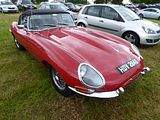
LAMBORGHINI
Lamborghini Murcielago
MASERATI
Maserati Ghibli
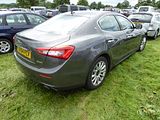
MERCEDES-BENZ
A couple of AMG models attracted my attention, another C63 and an earlier CL55 AMG
MG
MGB GT
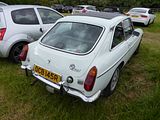
MINI
Among the large numbers of modern MINI was this first generation MINI John Cooper Works GP, the last Mk I MINI variant to be produced using the supercharged Tritec engine. This was sold as a light-weight, quasi-race-prepped John Cooper Works model, hand-finished by Bertone in Italy. It was offered as a limited-production run of 2000 cars during the 2006 model year, with 444 of those originally intended for the UK market, although ultimately, 459 were sold, even though the price was somewhat eye-watering. The GP featured more bolstered Recaro front seats but had no rear seats, which along with reduced sound-deadening, removal of the rear wash-wipe system, optional air-conditioning and radio, and other weight-reduction steps, resulted in a weight saving of around 40 kg (88 lb) compared to a Cooper S. Mechanically, it featured a less restrictive intercooler, recalibrated engine management, high-volume injector nozzles, and a freer-flowing exhaust system. Extra cooling capabilities lets the supercharged engine run longer on cooler temperatures for better track performance. This resulted in an output of 218 hp from a faster revving engine. Additionally, the car had enhanced braking, suspension, and a smooth under-body for better aerodynamics. The whole geometry of the rear axle was modified with parts from the Mini Challenge race car to enhance the handling. In place of the rear seats there is a metal bar for a stiffer chassis performance. The car also offered many unique styling points, such as the red door mirrors, a carbon fibre rear spoiler, unique body kit, bespoke, 2 kg lighter four-spoke alloy wheels, and specialised badging. Available in just one colour scheme (Thunder Blue with a Pure Silver roof), each car was individually numbered and featured a decal on the roof along with a plaque on the dashboard. Although they were costly when new, they have held their value very well, and rarely come up for sale even now, nearly 10 years after they were new.
NISSAN
Not part of the Owners club display, clearly, there were examples here of the Skyline R34 and the still current GT-R.
PEUGEOT
Launched in 1986, Peugeot 205 Convertibles were built alongside the Ferrari Testarossa, with Pininfarina having total control over the design of this model. Cars were part assembled with the unique cabriolet parts in Italy before shipping back to France for final production . With the exception of the bonnet and front wings all other panels were unique to the cabriolet. The total number of RHD convertibles sold in the UK was 6,223 in a production run from 1986-1994. This included both the 205 CTi and 205CJ versions. The CTi was first to market, being an open topped version of the established GTi
ROLLS ROYCE
Phantom
SUBARU
The latest Impreza WRX STi is a rare beast, which is not that surprising, as it is rather “previous generation” in its approach to many things. The market has moved on, but Subaru have not
TRIUMPH
Although there were plenty of TR models on show in the Car Club displays, they were all from the TR4 – TR5 era, so it was nice to see the TR model which actually turned out to be the best seller of the lot, with this TR7 Drophead. Whilst the TR6 had been a careful update of the Michelotti designed TR4 and 5 models, with a new front and rear end disguising the model’s origins, when the next and what turned out to be final TR model was launched in January 1975, it really was all new. A dramatic Harris Mann wedge shaped was shock enough for the purists, but the fact that at launch it only came as a Fixed Head Coupe was almost too much for some to bear. In the end, though. more TR7s were sold than any other TR model, so it really cannot have been all that bad even if the car had a somewhat bumpy existence, moving production plant from Speke, Liverpool where the early cars were made, to Canley, Coventry in 1978 and then finally to the Rover Solihull plant in 1980. An open topped model did join the range in 1980 and small numbers of factory built TR8s with the 135 bhp Rover V8 engine under the bonnet were made, but the proposed 2+2 Lynx model, and a version with the 16 valve Dolomite Sprint engine and the 2 litre O Series unit never made production. The car was launched in the United States in January 1975, with its UK home market debut in May 1976. The UK launch was delayed at least twice because of high demand for the vehicle in the US, with final sales of new TR7s continuing into 1982. The TR7 was characterised by its “wedge” shape, which was commonly advertised as: “The Shape of Things to Come”, and by a swage line sweeping down from the rear wing to just behind the front wheel. It had an overall length of 160 inches, width of 66 inches, wheelbase of 85 inches and height of 49.5 inches, and a kerbside weight of 2205 pounds, exactly 1000 kg. During development, the TR7 was referred to by the code name “Bullet”.The original full size model wore MG logos because it was styled at Longbridge, which was not a Triumph factory. Power was provided by a 105 bhp 1,998 cc eight-valve four-cylinder engine that shared the same basic design as the Triumph Dolomite Sprint engine, mounted in-line at the front of the car. Drive was to the rear wheels via a four-speed gearbox initially with optional five-speed manual gearbox, or three-speed automatic from 1976. The front independent suspension used coil spring and damper struts and lower single link at the front, and at the rear was a four-link system, again with coil springs. There were front and rear anti roll bars, with disc brakes at the front and drums at the rear. The interior trim was revised in March 1977, with the broadcord seat covers being replaced with red or green “tartan” check inserts with black leather effect vinyl edging, which looks so very period. now The tartan trim was also reflected in the door cards in padded matching red or green tartan cloth inserts in the black leather effect vinyl. A number of other detailed changes were made, partly to ensure commonality of parts in future models, such as the Convertible and the TR8, and also based on what else was available from the corporate parts bin. Badging changed a number of times, but there were no other significant alterations before the end of production in 1981. In total approximately 115,000 TR7 models were built which includes 28,864 soft top/convertibles, and approximately 2,800 TR8 models.
TVR
There were a couple of TVRs which could easily have been in with the other Blackpool sports cars in the Car Club displays, a “wedge” 350i and an S.
VOLKSWAGEN
The latest Golf R is a deeply desirable car, and always attracts my eye whenever I see one.
Final vehicle of this sizeable report is a Mark 1 Caddy. The Caddy came into being when Volkswagen was experimenting with Golf derivatives, an estate and a pickup. Volkswagen of America was interested in the pickup, and they were first to market this body style with the Rabbit Pickup in North America, produced at the Volkswagen Westmoreland Assembly Plant in Pennsylvania from 1978 to 1984. Trim levels such as LX and Sportruck were available, along with two engine choices, the 1.5 litre diesel and the 1.7 litre petrol. One unique feature of the time was that the diesel came with a 5 speed gearbox, with the 5th gear labelled as “E” or “Economy”. The Caddy actually wasn’t called Caddy until 1982 when it was released in Europe. European Caddys were built in Volkswagen’s plant TAS in Sarajevo, Bosnia and Herzegovina from 1982 till 1992. The original Caddy was produced in South Africa until 2007, alongside the first generation Golf itself (which was sold until 2009). The stamping equipment was shipped from the closed plant in Westmoreland for both models. The second generation Caddy, released in 1995, was based on the Polo, and came as a van rather than a pickup.
This was an excellent event, with the Cholmondeley team going from strength to strength in assembling an array of cars to keep the attendees interested all day. It has been rebranded as “Cholmondeley Power and Speed” and takes place from 10 – 12 June 2016. Needless to say, I will be attending.

